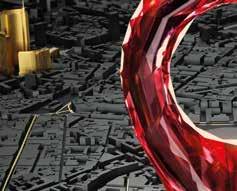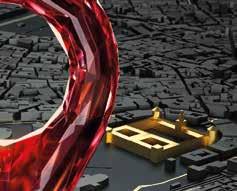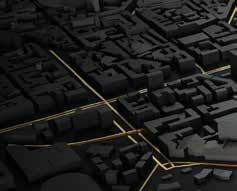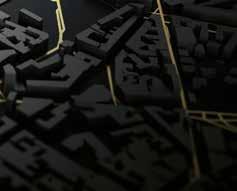
























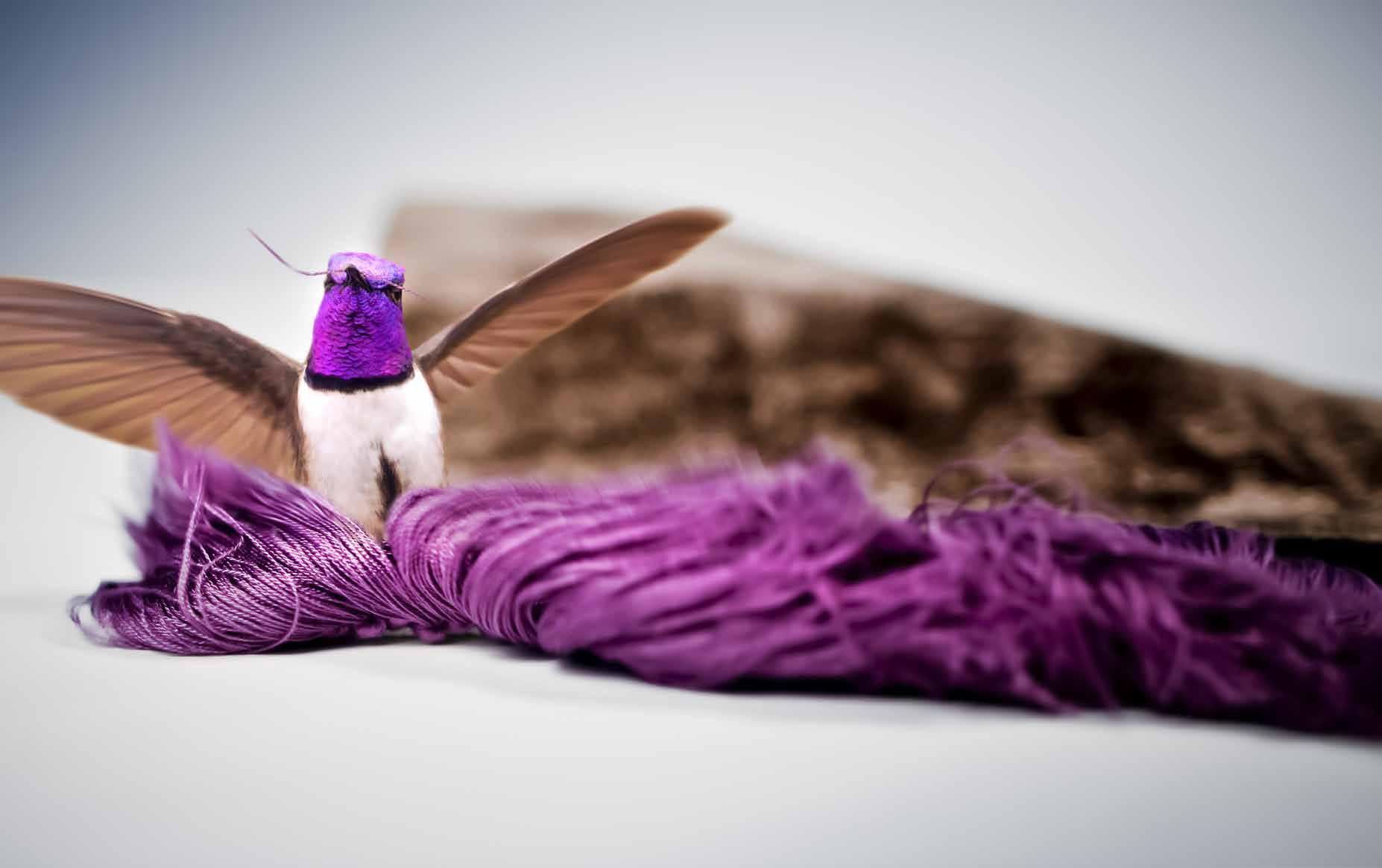




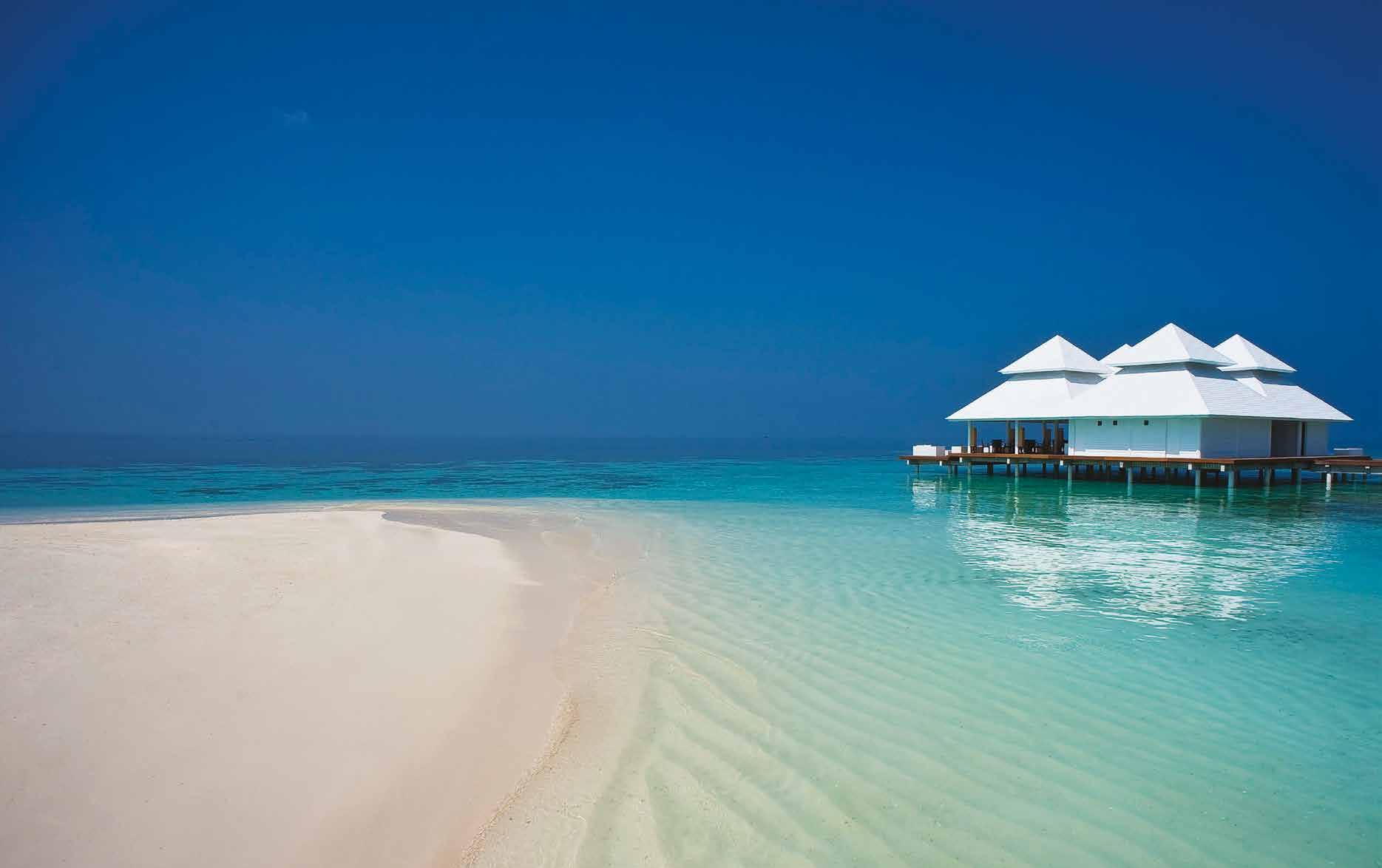
Heading NORD , looking up at the ink-black sky, I caught sight of POLARIS , the NORTHERN STAR and other PLATINUM -coloured, far away galaxies. I was eagerly waiting to see the perpetual ICE for the first time in my life. A few hours later the RISING SUN appeared and I finally caught a glimpse of the first sharp-edged iceberg on the HORIZONS III We approached closer, and there it stood – like a gigantic, glistening PODIUM . What a contrast: a few weeks ago, I was living the Italian BELLA VITA on CAPRI under the hot summer sun, and now, I was embracing the ELYSIAN -clear cold airs and facing a LIMITLESS white, which could not possibly be HERMITAGE to any living being. A couple of moments later, from my unique AVANTAGE , I spotted the ultimate sight, the ACE : a polar bear with her cubs. What a proud, mighty HUNTRESS she was. Who could not ENVY me for being here? This arctic wilderness was THE ONE place of my lifetime that I will never forget.
Anything can happen onboard a LÜRSSEN :
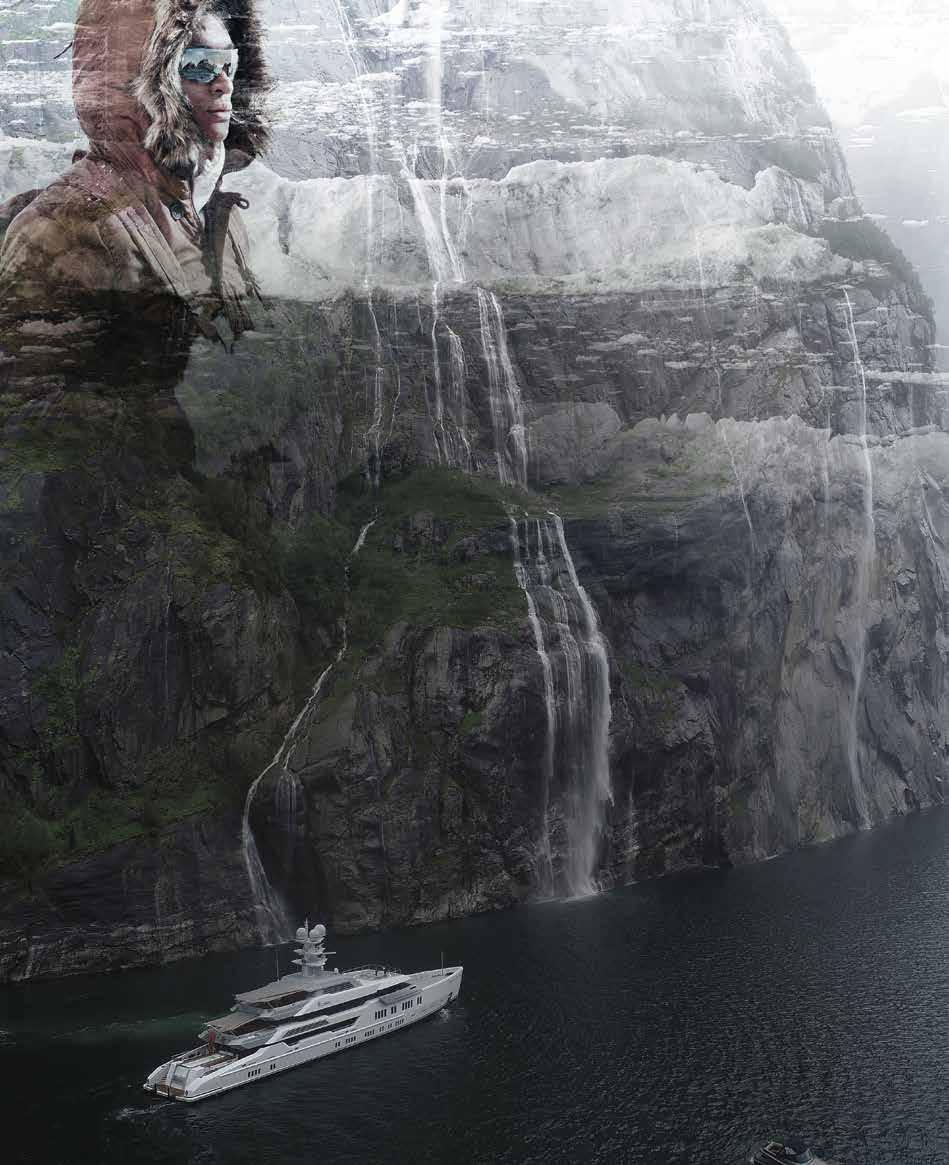
he arrival of spring marks the start of the most fertile season for the yacht building sector. And more…

Milan’s legendary Salone del Mobile is one of the most creative weeks of the year. The entire city is transformed for the duration as all of the hottest international furniture brands take creative ownership of the streets, piazzas, stores and store windows, revealing an all-too-often hidden side of Milan. Even the most eclectic and classic brands open up to the pub-lic and everything – materials and forms of all shapes, types and sizes - becomes about Art and Design. The frenetically busy Milan Design Week is gradually drawing in Italy’s yacht builders too. Sanlorenzo is a case in point,- present as usual in the Fuori Salone at city’s Università degli Studi with an installation. This year “The Impossible Machine”, created by Piero Lissonito, ex-plains how green methanol represents the future of yacht power generation. This new technol-ogy was developed in partnership with Siemens (for further information see the Green Horizon column on page 36). Azimut’s Seadeck concept inspired AMDL Circle and the Michele De Lucchi to create “The Sea Deck”, an emotional walk on the water at the Darsena too. Sticking with the University, Besenzoni is also there with Flow, a piece by Francesco Forcellini (we tell you more in the “In The Spotlight” Special on page 96). A new nautical startup called Santelmo has also se-lected the vibrant Fuori Salone to celebrate its entry to the yachting market with a line of eco-sustainable aluminium alloy models, powered by green hydrogen. It is there with an original in-stallation in the showroom owned by Richard J. Brown, a luxury Italian clothing brand with which it shares the same focus on detail and sustainability.
All this for THE ONE Yacht & Design: an endless sea of news and innovations, all the while keep-ing our eye on the megayacht world. Which, of course, we will be reporting back to our readers in the upcoming editions of the magazine and on our social media platforms.
In the meantime, don’t miss the opportunity to take a virtual tour on the most beautiful megaycahts of the minute and all that they are bringing to the party. In the cover story of this issue, we take you aboard the CRN 52m CIAO where the emphasis is on generous open-air spac-es, developed in connection with the interiors. We also explore Attitude, the first 133’ in Baglietto’s seafaring domus-inpired DOM series. And last but very far from the least, we reveal Nyumba, Southern Wind’s first diesel electric hybrid yacht.
Happy reading!
CEO Platinum Media Lab
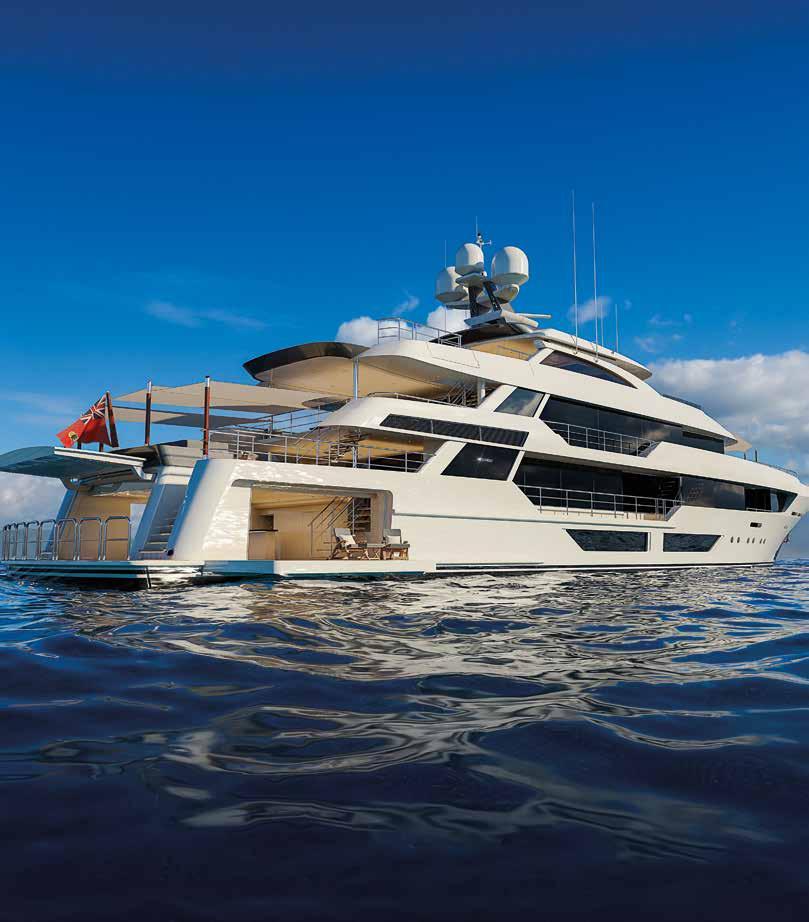



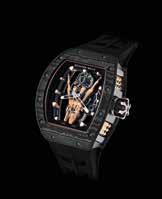



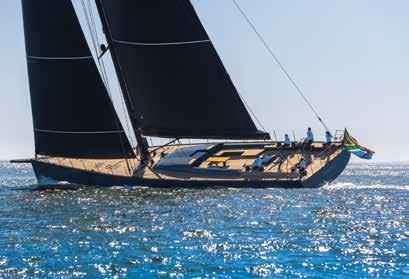
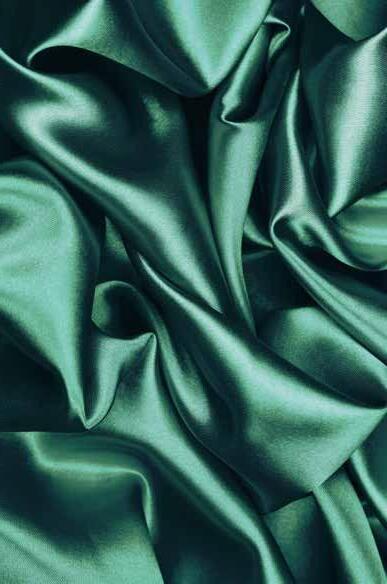

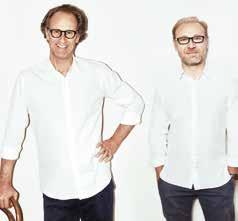
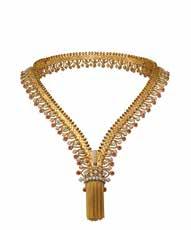


Mr. Maggi, can you give us an overview of the yacht market?
Can you see any signs of a downturn?
In my opinion, after the sharp increase we’ve seen in the past two years as the pandemic gradually burnt itself out we’re seeing a normalisation process that is still showing positivity and elan. I think political events are worth keeping an eye on if we are to avoid the risk of sudden crises and a resulting decline in sales. As far as Wider is concerned we can be happy with we’ve done so far, in terms of orders, too, both for our superyacht production hub in Venice and our new centre in Fano, where work on the creation of our new facility is progressing nicely.
What are the main target markets of Wider?
We’ve established significant dealerships in a number of European, Asian and American markets. We’ve set the ball rolling in America with an important agreement signed with the famous MarineMax company. For 2023 we have a development plan that will provide suitable territorial coverage with all the operators who are demonstrating a belief in our series-built model, the catamaran, and who are most of all are as enthusiastic as we are about our exclusive series-built hybrid propulsion system.
Wider have announced a collaboration with Northrop & Johnson. What results are you expecting?
The collaboration we’ve initiated with this large, capable operator focusses on megayachts between 50 and 70 metres in length. We’re expecting great things from this project.
One of the innovative projects you’re involved in is the construction of green yacht-building yard in Fano. When will it come onstream and what will be the first yacht built there?
The new yard is going ahead as planned - apart from a few small glitches caused by technical problems – with a programme that will enable us to begin using use it as soon as late May, early June. The slight delays in completion have had no repercussions on production of the catamaran line, as we’d already prepared a plan B that has enabled us to begin fitting out the first unit as early as last December in a temporary structure. I also think that completing the work in a short time is also the result of our decision to involve exclusively local companies in the project, from builders to plant engineers and designers like Alessandro Massari, who read our specifications and gave the right look to the finished product.
The design is very attractive. Together with Luca Dini and our Wider Centro Stile we’ve created a look that’s sexy even though it involves a type of boat, the catamaran, that in the past has never really been all that appealing. The interior choices reflect the aesthetics of the exteriors, with a sinuosity, colours and materials that we hope will satisfy the tastes of a sophisticated clientele. As for the green elements, Wider has fitted a yacht with a propulsion technology that even Tesla at the time had difficulty in persuading the market to accept. Now Wider has perfected this technology and is constantly researching innovations that make our products increasingly sustainable, from cutting harmful emissions to taking care where materials are sourced and paying attention to everything that helps make it possible to use the yacht in total safety. The WiderCat 92 especially has solar panels that will assist greatly in on-board energy generation, useful above all when spending leisurely days at anchor.
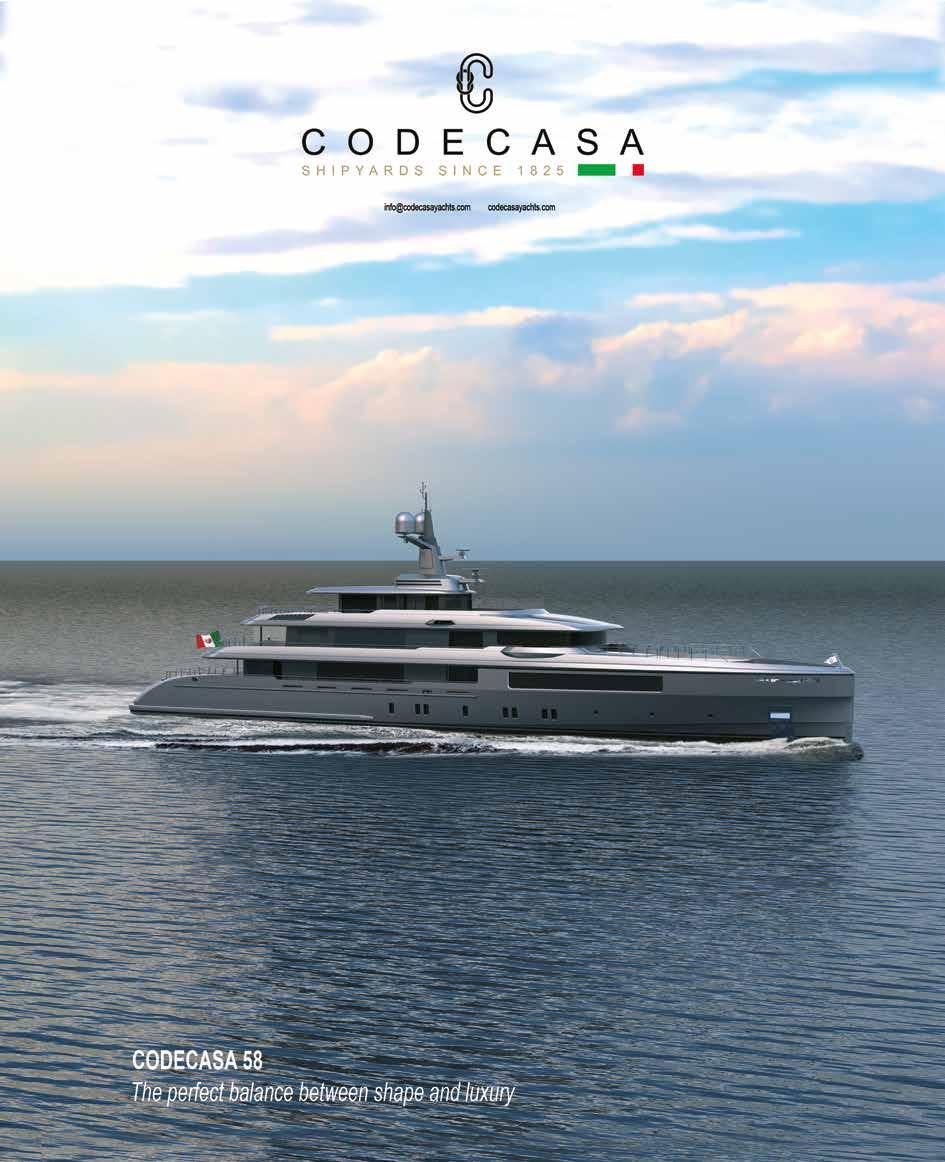
 by Veronica Lempi
by Veronica Lempi
WhatmakesaLivingDivaniproductsorecognisable?
Wedevelopproductsandsolutionswhosedifferentfinishesandmaterialsreflecta heterogenoustastethatprovidesaresponsetothemanifoldrequirementsofaconstantly evolvingmarket.Aharmoniousmix,unquestionablyItalianyetatthesametime international,whereperfection,balancedproportionsandattentiontodetailarethequalities thatmakeourproductsstandout.Ouryachtscommunicatebeautyandquality,intrinsic elementsinMadeinItalymanufacture,butalsothestoryandhumansidethatliesbehind thecompanyanditsproducts.Wehavedevelopedastylethatrevolvesaroundtheconcepts ofdelicacyandelegance,simplifyingshapesuntilwecreateobjectssuitableforallsettings.
Howhastheideaandmethodofexperiencingasofachangedinrecentyears?
Betweenthelate1980sandthestartofthenewmillenniumthattaskofdesignwas toamaze,topresentobjectsandproductsthatwereinturnextravagantandcapable ofprovidingavisionforourhomes.Nowdesignhastofulfilandrespectallcultures, respondingdirectlytochangesinthesocialandtechnologicallandscape.
HowhasLivingDivanirespondedtothesechanges?
Weenableclientstotryoutanewfreedomwhenpurchasingasofa,offeringavaried collectionofadaptable,versatilepieces.Forus,sofasareaconversationpiece,providing welcome,warmth,relaxationandasophisticated,intimaterefugewheretactilesensations arethekey.
What’syourideaofoutdoorliving?
Founded in 1969, Living Divani is an Italian company known for its upholstered furniture. Harmonious proportions and attention to detail are the hallmarks of the family-run business, which is based in Brianza, Italy. Carola Bestetti is now at the helm of Living Divani, continuing the traditions established by the first generation and enhancing them with an additional dose of feminine awareness and aesthetic sensitivity.
Since 1988 a collaboration with Piero Lissoni as art director and designer has led Living Divani to acquire an unmistakeable stylistic personality.
Forus,outdoorisaplaceforliving,dedicatedtorelaxationandwell-being.Ouroutdoor productshavewelcomingshapes,refinedmaterialsandMediterraneancoloursthatcreate elegant,versatilefurnitureitemssuitableforarangeofdifferentsettings.Theaesthetics andDNArecognisableinourindoorproductsaretransferredtotheoutdoorcollections, maintainingthesamephilosophyofliving.LivingDivani’sofferalsoincludescontract projectswherequality,technicalperformanceandopportunitiesforcustomisationhaveled thecompanytoacquireaglobalpresenceinanumberofsectors–offices,banks,airports, hotels,lounges,museums,restaurantsandshowrooms.We’vealsobeencollaboratingfor severalyearswithimportantluxuryyachtindustrybrandsindefiningpersonalisedoffers. HowimportantistheaestheticsofaproductforLivingDivani,andhowdoesrelate toperformancequality?
LivingDivaniaddressesarefinedclientbase,peoplewholovebeauty–whichalso meansartisanalqualityattentiontodetail.Theyalsoappreciatecreativityandareopento newideasanddiscoveringunusualcombinationsofstylesandmaterials,fromthemost prestigioustothemostinnovative.That’swhyLivingDivaniproductsaretheresultofa perfectbalancebetweenindustrialproductionandmanualexpertise,whereeverystageof theproductionprocessissubjecttocarefulcheckstoensurethateverycreationmeetsthe highestqualitystandards.Thecompanyiscarefultoprovideperfection,sothecreativestages andthechoiceofleathersandfabric,cutting,sewingandassemblyarecarriedoutin-house, withanalmostartisanalapproach.
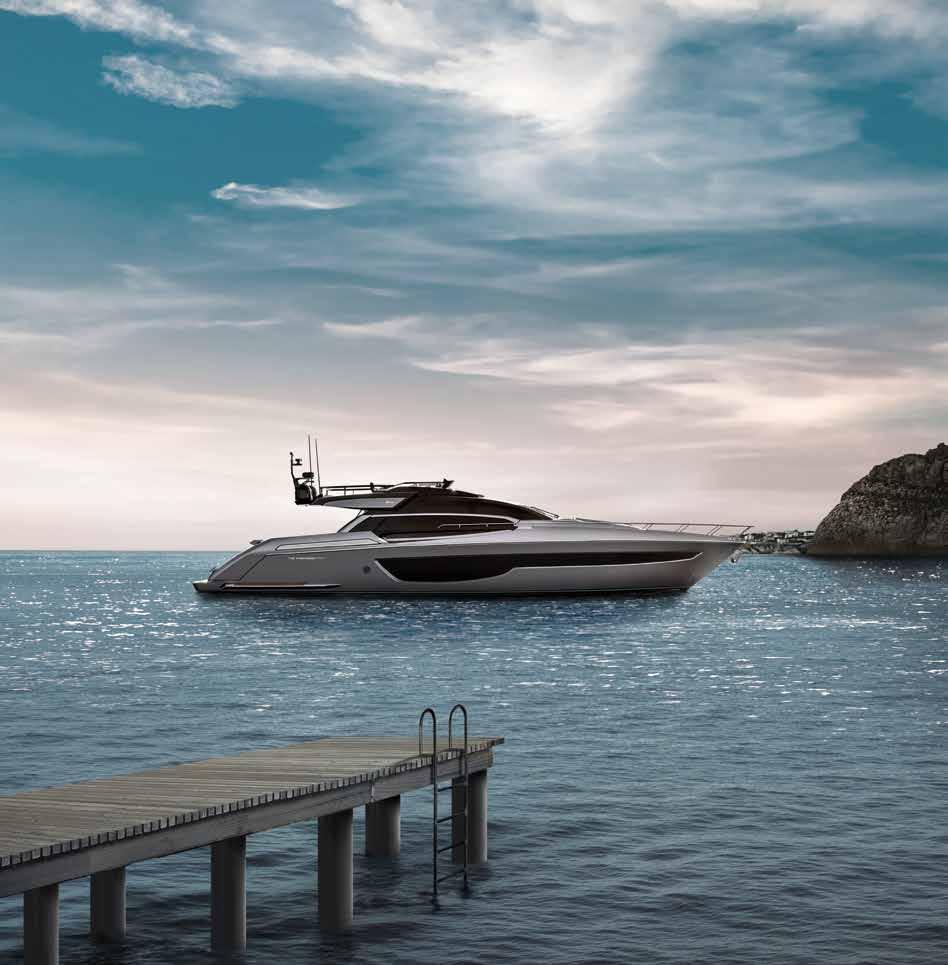

Ireturn to a subject that’s dear to my heart and that was also the theme of our Captains Meeting, an annual event organised by the Floating Life team that attracted over 50 commanders. I’m talking about electrical fires and the related standards currently being drawn up. I’m not going to talk about all the arguments that have been raised but I just want to say that the number of incidents causing total or significant loss of the yacht’s value quadrupled between 2021 and 2022 when compared to previous years. One of the reasons is linked to the increasing use of lithium-ion batteries and the lack of knowledge of what to do in the event of a fire. As yet, the regulations drawn up for yachts concerning all this are still insufficient or non-existent.
As a result I feel I should recommend that all owners, designers and crews to carry out risk assessments, or call on specialists in the field to do so with the aim of seeing existing yachts, which in recent years have been stuffed
with electrically-powered toys, and new models that will include equipment powered by lithium-ion batteries. Let’s remember that it’s not only batteries that can burn – everything around them must be made incapable of spreading what starts off as a localised blaze that is almost impossible to put out. Going by the look on the faces of the participants in our meeting I’m sure that many people have little knowledge of a subject that’s literally a burning issue in our markets. For example, in 360 days there have been 24 serious electrical fires, 14 of which involved lithium-ion batteries, with the cause of ten more yet to be precisely determined, but it’s fair to say that they, too, can traced back to lithium-ion batteries.
As always, I will conclude by saying that I’ve already communicated everything I’ve said here loudly and clearly to the yacht-building industry, and have been doing so for some time.
BE CAREFUL OF TOYS AND LITHIUM BATTERIES. SAFETY IN DESIGN, TOO!
Ihopethatthistimemywordswillnotsimplyvanish, disregarded,intothevoid!

Tankoa has been busy-busy of late, having nailed both the launch of the fifth example of its 50m series and a hugely successful debut for M/Y Kinda’s at Monaco in recently months. It now has further reason to celebrate thanks to the sale of the second hull in the new Luca Dinipenned all-aluminium Sportiva 55 series in less than a year. Due to be delivered to its young European owner in 2024,
this ultra-sleek yacht will have its galley on the main deck in addition to a master suite with private hot tub. The lower deck hosts five guest suites and a pretty amazing beach club that includes a swimming pool, a Nemo room and an elevator to the upper decks. This particular owner will be providing his own interior designer. Tankoa currently has a total of eight vessels in build with delivery dates set between now

and 2025, proof positive that the new commercial strategy it began implementing three years ago is working. In the words of Tankoa Sales & Marketing Manager Giuseppe Mazza: “I am proud to see that the commercial strategy undertaken three years ago is bringing the expected results and we are on the right path to become one of the main players in the superyacht market.” Tankoa President Eva Orsi echoed his
confidence, saying: “Despite all the political and economic uncertainty, 2022 was a very fruitful time for Tankoa as the market is increasingly aware of what our boutique brand is all about. The super sleek Sportiva 55 was designed by Luca Dini to expand our market offering by integrating all the best features into a 55-metre yacht while remaining under 500 GT.” ww.tankoa.it
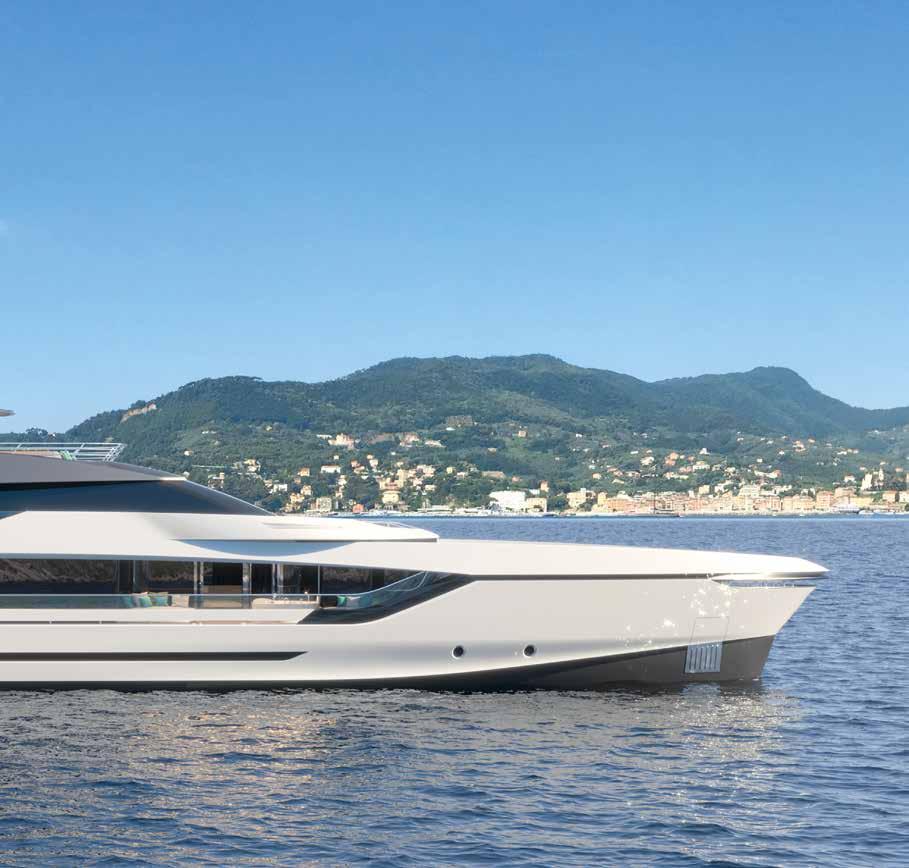
Jozeph Forakis has unveiled the radical Pegasus, the first 3D-printed superyacht designed to be virtually invisible both in terms of design and environmental impact. Promising unparalleled sustainably, range and structural integrity, the 88m superyacht will have an astonishingly light and strong 3D-printed mesh framework integrating both hull and superstructure. The unique low, linear plumb bowed hull has a silvery metallic finish to blend with the colours and movement of the sea, and is topped by a superstructure with multi-tiered, ephemeral glass wings that reflect clouds and sky. The base of the four-level Tree of Life, the centrepiece of the interior, emerges from a reflecting pool on the lower deck and is surrounded by a hydroponic garden providing fresh food and air purification. Living greenery and uninterrupted views are a constant throughout the guest areas. The top level is the owner’s with a forward-facing suite with generous private terrace. The superstructure glass incorporates transparent solar panels that drive electrolyzers that extract H2 from seawater which is then converted to electricity by fuel cells and stored on lithium ion batteries to power operating and hotels systems as well as the pod drives. www.forakis.com
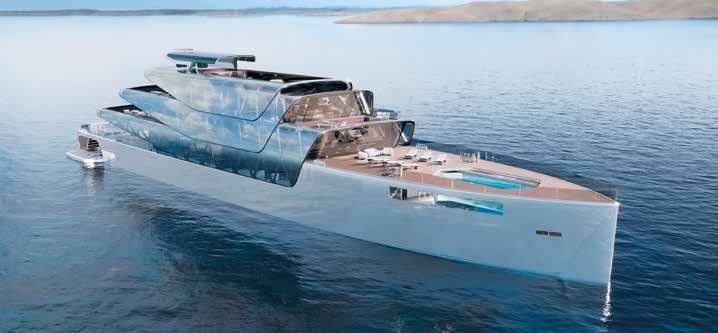
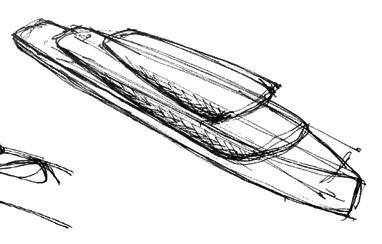

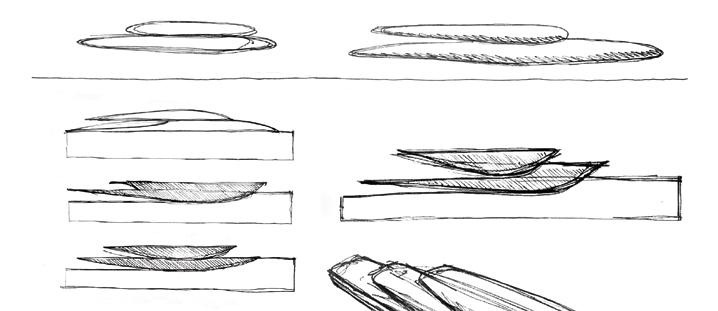
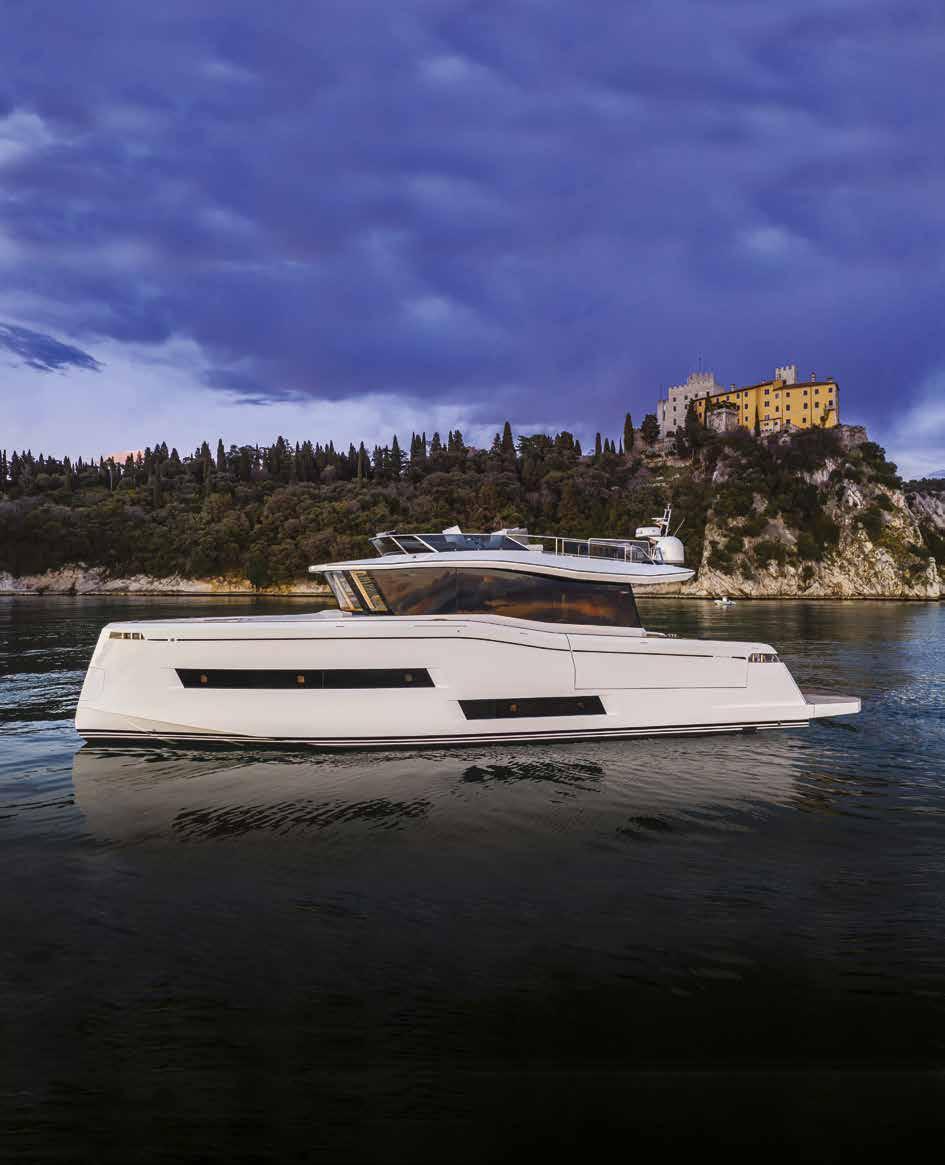
Tillberg
Design of Sweden (TDoS), a Viken Group member, has been commissioned to do all of the exterior styling, guest suite accommodation design and master planning for a new vessel for the Four Seasons luxury hotel and resort group. The client brief was “Christina O meets James Bond”, so this is a stunner indeed. Dubbed a luxury yacht liner, the 207m will combine the scale of a small luxe cruise ship with superyacht glamour, sophistication and amenities, offering 95 suites over 14 levels. Mirroring the harmonious lines and proportions of Christina O, the yacht will also have a 20-metre long pool with a surrounding deck in the very aft section. The interior features an extensive network of

joining suite combinations that create versatile villa-lik residences with a distinctive Dolce Vita vibe. Each suite will offer floor-toceiling windows providing unobstructed natural light and access to expansive terrace decks not to mention 2.4m ceiling heights. The spectacular Funnel Suite, a reference to Christina O’s iconic funnel, offers its fortunate guests a massive 892 sqm of indoor and outdoor spaces spread over four levels, and also has a private tender access. Very James Bond indeed. The Four Seasons Yacht will, of course, offering its guests haute cuisine restaurants, lounges, bars, spas and a slew of other high-end amenities. www.tillbergdesign.com
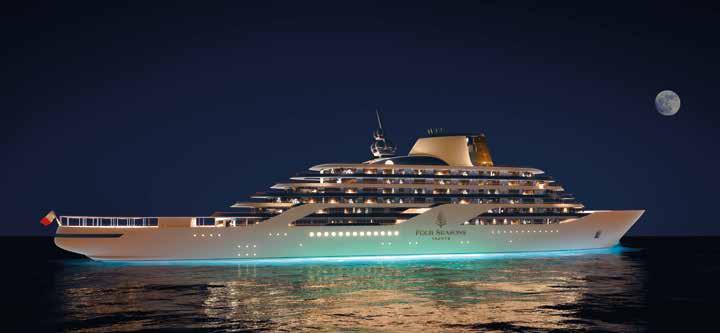

Theaggressive, compact yet incredibly spacious Young 72 offers the owner seamless circulation from foredeck to aft deck, resulting in a great sense of freedom as well as heightening its many ocean views. The work of Ashish Gupta, founder of international design studio Beyondesign, this gleaming craft is aimed at the 40-55-year old entrepreneur demographic. The welcome deck includes an open-to-sky beach wellness area with lap pools port and starboard as well as a grand waterfall entrance to the entertainment deck overhead. The beach deck also offers 220 sqm of dancefloor with folding terraces with the waterfall door

leading to the beach bar lounge. The entertainment-guest deck includes a lovely al fresco dining area that connects to the pool and grand skylit staircase on either side. Accommodation-wise, there are four full-beam VIP staterooms on the entertainment deck. The owner’s relax-private deck includes an open-air theatre aft with a private family lounge and study, two teenager suites and the panoramic owner’s suite overlooking the helipad forward. The bridge – owner’s work deck has an al fresco aft lounge in addition to a full office and conference room. The garage houses a 7.3m owner’s limo tender. beyondesign.in

LOA: 38.70M | BEAM: 8.50M | RANGE: 5000 NAUTICAL MILES
GROSS TONNAGE: 430 GT |
ACCOMMODATION: 12 GUESTS IN 6 CABINS
CONSTRUCTION: STEEL AND ALUMINUM
EXCLUSIVELY FOR SALE THROUGH FLOATING LIFE
www.floatinglife.com - info@floatinglife.com
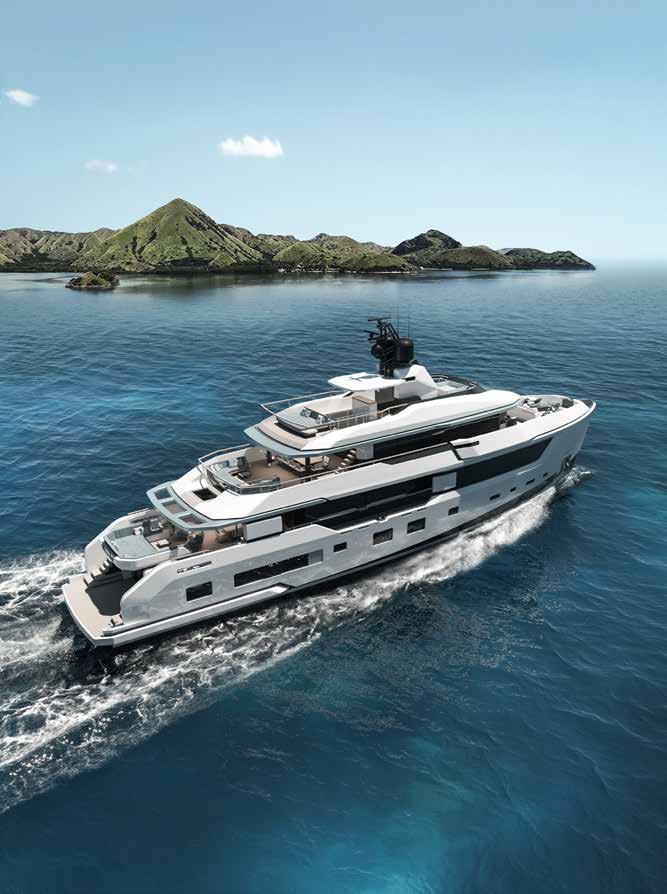
The115m Apex full custom explorer yacht concept has a rugged exterior by the A Group and naval architecture by Lloyd Werft Bremerhaven which will also build it. This is a “no limits” vessel with an ice-going bow almost four decks high to negotiate even the heaviest weather. An 18.5m beam and 8,000GT give a further insight in to what is on offer. In fact, up to 22 guests and 48 crew can be accommodated as this beauty eats up her 9,000 nm range at 16 knots. The exteriors are awash with large open spaces. Amenities include two 20m tenders and a 12m pool with glazed walls almost the height of an entire deck. The Apex’s signature expansive windowing


includes the largest panes ever used on a yacht. Behind lie 2,400 sqm of luxurious living space in the completely customisable interior. The helicopter stows safely in a hangar beneath the helipad. Guests accommodation is on the main and upper deck with two of the four VIPs each sharing a private saloon. The owner’s deck includes a stateroom, dressing rooms, bathrooms, an office and a lounge, with the party area and the infinity pool at the stern. The Apex also offers two saloons. The main deck has a cinema/conference room and entertainment area.
lloydwerft.com
YACHT SELECTION FROM 24 TO 140 MT CHARTER SALES
NEW CONSTRUCTION
YACHT MANAGEMENT
CREW RECRUITMENT
BOAT LIMOUSINE
LXRY1 SRLS, Piazzetta della Marina
CAR RENTAL: HYPERSPORT CARS SUVs

100% ELECTRIC VEHICLES
PLUG-IN HYBRIDs
ULTRA LUXURY
CHARGING INFRASTRUCTURE FOR ELECTRIC VEHICLES
07021 Porto Cervo (SS) Italy - 41°08’09’’N 9°31’39’’E
Tel. 0789 1670170 - mail: info@lxry1.com
Visit: lxry1.com LXRY1 lxryone
AIR TRANSFER
PRIVATE JETS

HELICOPTERS
AIR AMBULANCE
SALES ‹ ACQUISITION
NAT’L ‹ INT’L AIR TRANSFERS
24/7 BOOKING
SHORT-MID-LONG HAUL FLIGHTS
YACHT BROKER alessio.dangelo@lxry1.com
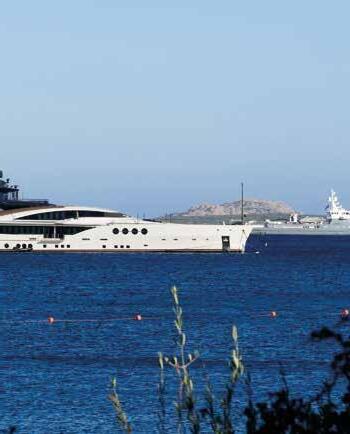
Thepower of pure purpose concept means that nothing aboard this 63m is just for show, purpose and beauty meld. The result is a wave-breaking bow chine, state-of-the-art shade devices, a spectacular observation deck and even a perforated swim platform that allows waves pass through it rather than fighting their action. LP Design’s brief was for a contemporary yet timelessly proportioned functional vessel with oodles of attitude. The full-displacement steel Explorer Yacht EXO – meaning outside – will deliver the endurance, capability and reliability, confidently tackling almost anything sea and climate throw at it. It also has a potential range of 5,000 nm. The layout allocates the perfect amount of space for guests, crew and owner as well as providing separate circulation paths. The final version of the styling seen here will, of course, be informed by the client’s wishes. The main saloon is airy, modern and intimate with side entrances avoiding the corridor effect and corner window arrays offering aft views. The rich materials in the Owner’s stateroom have a light neutral palette while its design centres around privacy, superb functionality, plentiful storage and effortless elegance. Lastly, hybrid dieselelectric technology delivers the perfect combination of power and silence. www.exoyacht.com

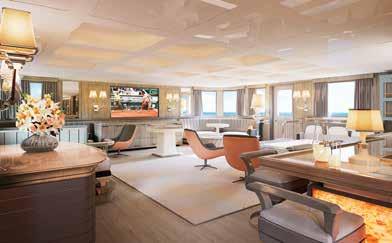

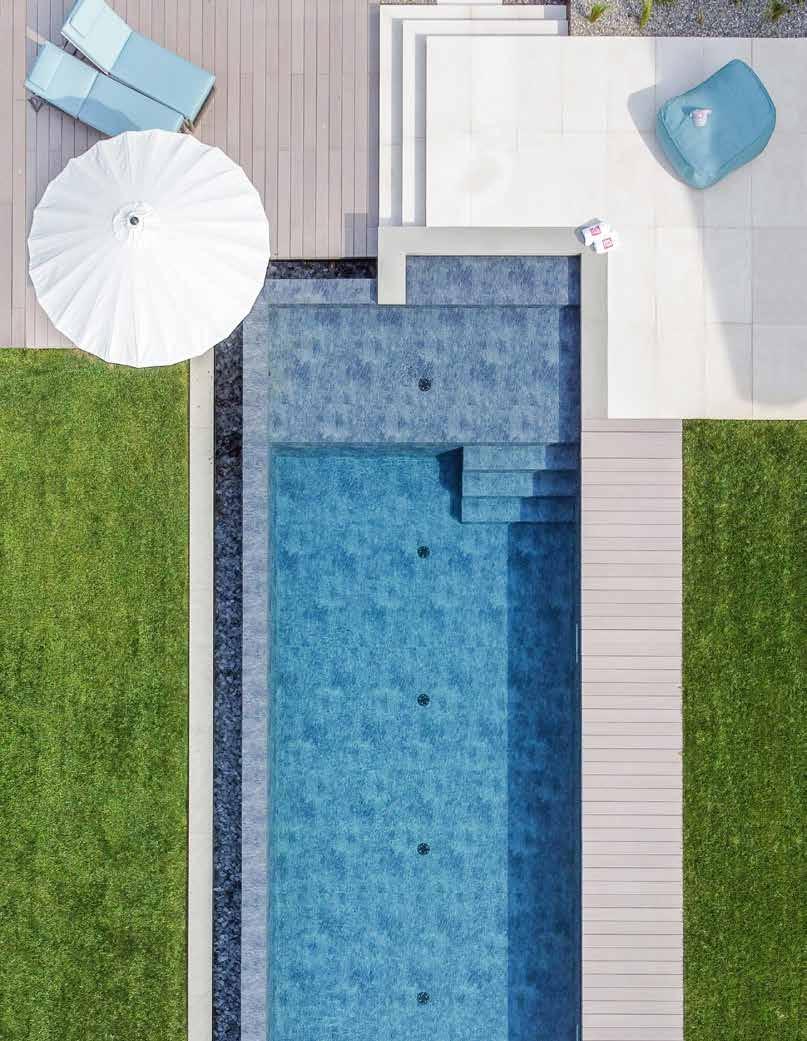


Elevators with sinuous shapes and attractive design are the perfect solution to luxurious, exclusive settings.

The use of valuable materials combined with modern high technologies can meet the most particular needs in terms of space and design.
Personalization and customisation is our must.

A particular attention is paid to norms and regulations in force in the elevator industry as well as to materials and their treatment in order to make them suitable for installation and functioning into a marine environment.


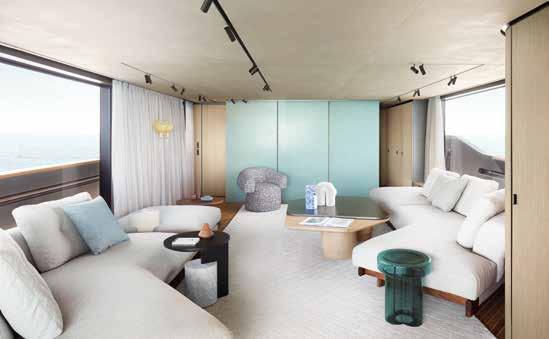
Sanlorenzo S.p.A. recently presented its 2023-2025 Business Plan to the financial community and the press. The extraordinary results realized in the previous three years delivered a compound annual growth rate of 17.6%, a doubling of EBITDA, a near-tripling of net profit, and over €100 million in cash generation, despite dividend distribution of around €31 million. “At the time of listing, we promised measured growth. We intend to keep the same promise pace for the next three years, while always delivering better-than-expected results to our shareholders,” commented the company’s Chairman and Chief Executive Officer Massimo Perotti. “To support the Plan, we identified the pillars, summarised in our Road to

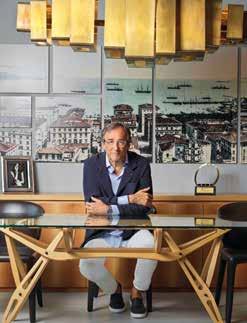
2030, that will see us pioneer carbon neutrality. This is thanks in no small part to agreements with the world’s leading energy and E-fuels players capable of revolutionising yachting’s global economic development, which in coming years will be increasingly affected by targets to limit social and environmental impacts, in line with the goals of the UN 2030 Agenda and the EU Green Deal. Although shipping accounts for just 1.7% of total GHG emissions, of which only a marginal 0.22% can be attributed to yachting, sustainability is therefore no longer an option”. In July 2023, for example, the Maritime Environmental Protection Committee (MEPC) is expected to decide to bring forward 100% decarbonisation of shipping to 2050. “The route mapped out in the Road to 2030

The Road To 2030 is the Amelia yard’s game plan to keep productivity high whilst respecting the environment. The strategy includes a focus on leading-edge partnerships and sustainable materials
strategy will see Sanlorenzo launch the first 50Steel equipped with methanol fuel cells to power all on-board services, in 2024, followed in 2028 by the launch of the first 50Steel powered solely by methanol, the ultimate goal for Sanlorenzo and a true response to the nautical sector’s demand for carbon-neutral on-board power generation. Indeed, power generation for maximum speed sailing will no longer be tied to fossil fuel-powered diesel engines, but will be based on a combination of fuel cells and internal combustion engines powered by green methanol. In parallel, two revolutionary hydrogen-focused Bluegame projects are advancing: the BGH tender, launching in June 2023, was selected by the New York Yacht Club as the chase boat for American Magic during the 37th America’s Cup in 2024, and the subsequent BGM65HH (hydrogenhybrid). The use of recyclable materials, such as aboard the SD90, also counts in this battle with the Patricia Urquiola-designed interior placing a strong emphasis on transformability. Last but not least, Piero Lissoni’s “The Impossible Machine” installation for Milan Design Week celebrates Sanlorenzo’s relentless pursuit of technologically innovative solutions to reduce the environmental impact of yachting.
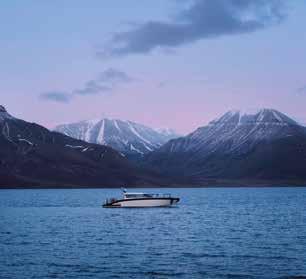
Withits hybrid electric pilot project currently proving a success in commercial marine applications, Volvo Penta has announced its first trial in the leisure segment. This exciting development will see a fully-integrated Volvo Penta hybrid electric system feature on a Groupe Bénéteau concept boat. The concept boat’s helm to prop technology is based on a successful hybrid electric vessel pilot project for Hurtigruten Svalbard, which has been running near-silent tour experiences ever since 2022. The hybrid electric demo will serve as a platform for testing and learning with early adopters. Silence is a key and enormously appealing benefit of hybrid electric boating and the sustainable experience is set to change the very nature of boating itself. That said, this initiative will seek to discover how clients expect to spend their time on the water and what performance needs they have around automation, connectivity, etc. Ahead of a much broader launch of sustainable vessels, Volvo Penta and Groupe Bénéteau will use the input from this process to support product development, running as an additional workstream in the process. “One of our core philosophies at Volvo Penta is ‘learning by doing’ and presenting this concept to customers at this early stage will help us in our efforts to transform Boating for Everyone,” says Johan Inden, President of the Marine Business at

Volvo Penta. “By running customer trials alongside product development, we can accelerate transformation and ensure our finished products are market-ready. Groupe Bénéteau is a great partner for this project because the company’s vision is so forward-looking and it’s a globally recognized brand.” A Jeanneau NC 37 model will be used for the demo. It will be equipped with a Volvo Penta twin D4-320 DPI Aquamatic hybrid-electric concept and leading-edge technology including Volvo Penta’s full joystick docking system and the Dynamic Positioning System, adapted to work in electric mode. The demo boat will also feature additional manoeuvrability, a hydraulic clutch for silent shifting at low engine speeds, and superior control thanks to precision joystick functionality.

A Jeanneau NC 37 model will be used for the demo and sport a Volvo Penta twin D4-320 DPI Aquamatic hybrid-electric concept, Volvo Penta’s full joystick docking system and the Dynamic Positioning System. The result? Superior manoeuvrability, silent shifting at low engine speeds, and superb control thanks to precision joystick functionality

Since 2018, the YCM Explorer Awards
La Belle Classe Superyachts have been recognising and rewarding the industry’s most forward-thinking owners and most ecoresponsible yachts. At this year’s ceremony, the electric Sunreef 80 Eco Marie-Joseph was declared the winner in the best yacht in the Technology & Innovation category.
The four awards were presented to men and
legend and avid sailor Rafael Nadal is getting involved in the first world championship for electric boats. The Majorca native is passionate about the ocean and so is backing the E1 team as a platform to accelerate the transition to clean mobility and restore marine ecosystems. The 22-time Grand Slam champion will support E1’s Blue Action Programme, which is designed to protect and restore marine ecosystems at scale in the cities involved in the championship while also
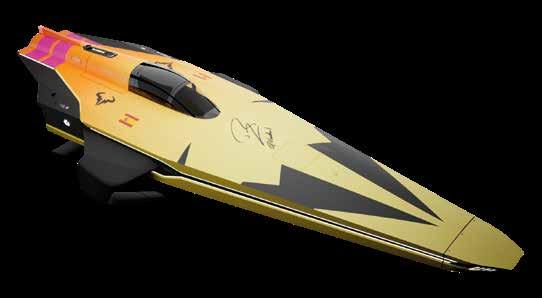
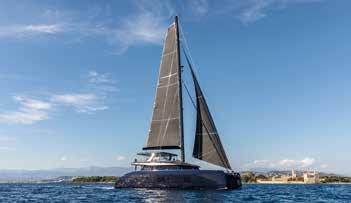
women who, as true explorers of tomorrow, perpetuate the ‘Art de Vivre la Mer’ philosophy. A delighted Sunreef Yachts Founder and President Francis Lapp accepted the award won by the Sunreef 80 Eco.
The Sunreef 80 Eco Marie-Joseph proved the most surprising candidate this year, thanks to her sheer number of eco-focused innovations, including solar panels with a ‘solar skin’
benefiting local communities. “I’m really excited to be getting involved with a project like E1 that values sustainability and will make a positive impact on society as a whole, especially in coastal communities,” declared Nadal. “E1 has a clear mission and is committed to preserving marine ecosystems. As a professional athlete, I recognise how making marginal gains has a positive impact on performance. To see this same competitive spirit and approach being applied at E1 to optimise the performance and efficiency of sustainable marine mobility is good news for our oceans”. Professor Carlos Duarte, a fellow Majorcan islander and Chief Scientist at E1, is a world-leading marine ecologist and will play an instrumental role in developing E1’s overall sustainability strategy, supporting the Rafa Nadal Academy’s sustainability initiatives and shoring up its commitment with sustainable sport. Alejandro Agag, Co-Founder & Chairman of E1, said: “E1’s mission is to accelerate clean mobility and restore marine ecosystems, which I know Nadal and his team feel strongly about”.
system, a hydro generation system and highperformance batteries.
Sunreef Yachts has long been heavily committed to developing sustainable yachting solutions and exploration with the result that it now has a full range of electric yachts and luxury explorer catamarans. Its team is always delighted to provide further information about the Sunreef Yachts electric yachts and explorer catamarans.
To side; HSH Prince Albert II with Francis Lapp Sunreef Yachts
Founder and President Francis Lapp accepted the award won by the Sunreef 80 Eco (left)





12 17
www.cannesyachtingfestival.com



CRN’s signs this 52-metre yacht with a sporty, contemporary appeal, designed and built in collaboration with Omega Architects, who created the exterior lines, and Massari Design for the exterior and interior guest areas. The project emphasises generous open-air spaces, developed in connection with the interiors
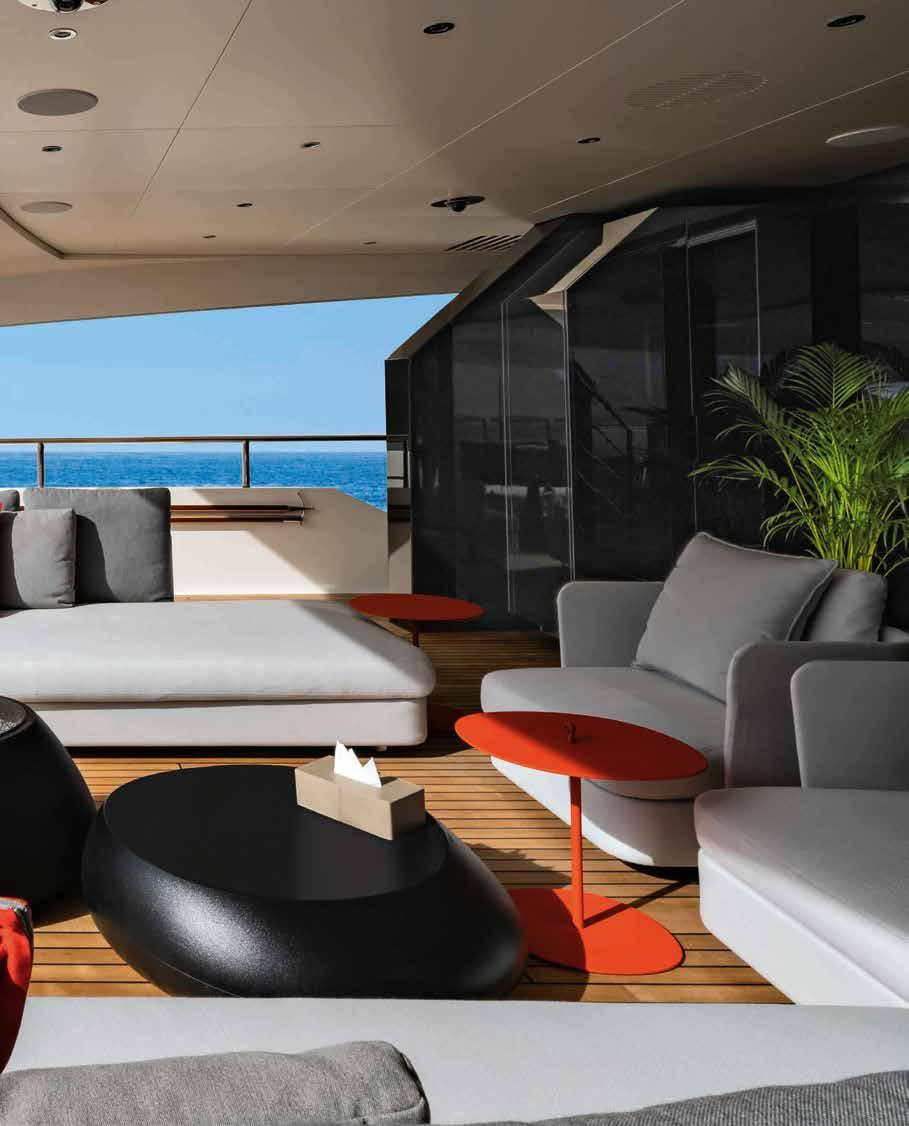
 by Paola Bertelli
by Paola Bertelli
owadays open-air living is assigned the same importance as experiencing the interiors, so designers and planners are constantly in search of new solutions in terms of functionality and quality. On a yacht, where sea, sky and sun are the natural environment, this is an even more pressing consideration. CIAO, the 52-metre yacht by CRN shipyard is the perfect example. CIAO was commissioned by an expert owner with extremely clear ideas and and passionate about sea. In a yacht with a strikingly sporty attitude, he specifically asked to focus on the social areas, with spaces designed to be experienced informally and generous, multifunctional exterior spaces fluidly connected with the interiors.
CIAO embodies the exclusivity of a custom-made yacht with a strong artisanal input. It is laid out over five decks (including a sub-deck) while remaining below 500 GT and can accommodate up to ten guests in four VIP cabins on the lower deck and the main deck owner’s suite. CRN


developed the entire naval architecture, and the yacht embodies CRN’s hallmark design and construction quality. The shipyard collaborated with the Omega Architects design and architecture studio, which created the exterior lines, and the Massari Design architecture studio, which is responsible for the exterior and interior décor.
The yacht’s profile is shaped by an almost vertical bow and taut, clean and dynamic lines. The decision to integrate the main deck into the hull and create a compact superstructure gives the yacht a refined, racy elegance. The two arches aft by Frank Laupman (Omega Architects) swoop upwards from the deck overhang to the base of the bridge. The long, dark glazed bands contrasting with the white superstructure create a pleasing balance between full and empty spaces.
The contemporary interiors combine elegant simplicity and clean shapes. Bright, with vivid colours and prestigious materials welcome guests in informal, wonderfully comfy settings. The Canaletto walnut combined with metals with warm finishes and dark leathers are complemented
CIAO, a 52-metre custom yacht with 9-metre beam and a gross tonnage of 499 GT, has an aluminium hull and superstructure. She was designed and built by CRN, the Ancona-based shipbuilder founded in 1963 and now known for its refined bespoke superyachts between 50 and 90 metres in length. Opening, the main deck conversation area

by some unique handmade decorations. The layout of CIAO revolves around the spacious open-air lounges and their ability to integrate harmoniously and fluidly with the other social areas. The main deck cockpit is a large open-air lounge – the decisive colours of the furnishings chosen by the owner underline its personality – that dialogues with the aft pool and the interior saloon, where the full-height windows and vertical mirrored structures to the side seem to open out the interface with the sea. Behind the saloon dining area, configured as an open space, is a bespoke decoration by Massari Design with metal finishes and a strongly material effect that contrasts with and breaks up the rigidity of the clean lines that define the overall design. Forward, the owner’s suite features large windows and an extensive mirror wall enhances the feeling of space. There is also a private studio. The walls are particularly striking – the Canaletto walnut panels with horizontal veining are complemented by darker leather and fabric surfaces. Outside, two large staircases connect the main deck to the
beach club – a leisure zone with sea level terrace and a sheltered relaxation area with TV, bar and wellness area with hammam and experience shower. The ability to create a seamless transition between indoor and outdoor spaces is also on show on the upper deck – here, the central role is played by the al fresco dining area with large custom-made table. The space can be enjoyed at all times of day, thanks to windows integrated into the superstructure, sheltering it from the wind. It forms a continuum with the sun/conversation area aft, and when the glass doors are opened it segues smoothly into the panoramic lounge, which can be transformed into a cinema room.
The integration of the sundeck into the superstructure is the result of a careful assessment of shapes and volumes, and it becomes a wonderful area for sunbathing and relaxation. Here, the horseshoe-shaped bar counter in the middle of the deck acts as a fulcrum between the aft dining spaces and the solarium area with hydromassage pool. www.crn-yacht.com

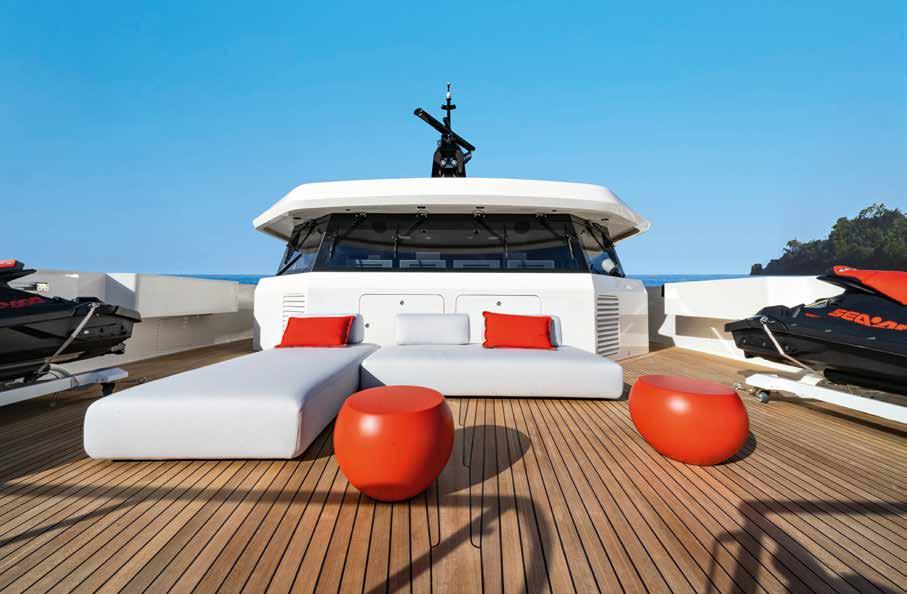
A constant search for harmony between interiors and exteriors is also expressed by the repeated presence of several furniture items, like the red table in the forward relaxation area (top left) and the main deck saloon (above). Light shades and the warm colours of wood for the interior beach club lounge (right) with sofas facing the large TV screen. The vast saloon in the Upper Deck, designed as a social area (left), houses a large sofa and a giant TV screen that allows the space to be converted into a real cinema room


WithM/Y CIAO we were asked to design a comfortable ocean-going vessel, with a distinctive character. It’s a full-custom design for a specific owner. Her design was developed from the ‘Ocean Sports’ concept, which we created together with CRN some years ago. The design for CIAO is nearly mid-leaning – in other words, her superstructure is placed just behind the optical centre of the side profile. This initial set-up enabled us to position her most defining element, a lowered foredeck that serves as an open-air tender garage. This open-air garage is the key to keeping her volume under 500 gross tons. A second important element and design feature is CIAO’s integrated hull and body. The hull and the main deck ‘layer’ work as one unity and as a result the rest of the superstructure looks relatively short. In effect,

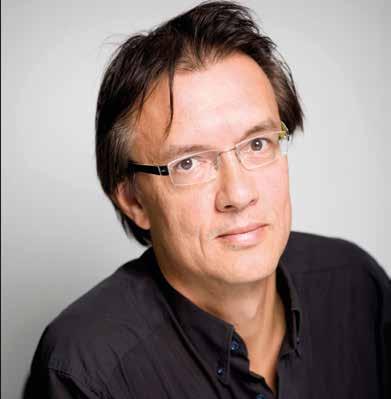
you may perceive the yacht as being longer than she actually is.
The layout of CIAO, is rational, sober and generally symmetrical. As a result, the configuration of the spaces means they can serve as a canvas for different interior styles, reflecting the owner’s expectations. Her large floor-to-ceiling windows are a special feature providing uninterrupted views onto the world outside. The design language of the 52m CIAO is expressed through chiselled 3D surfaces that develop in a relatively straightforward way to show her rugged character. With that, her overall look is between that of a normal yacht and a trawler style Expedition yacht. This integrated hull and body design leads to an eye-catching exterior and a variety of ambiences for the on-board spaces in a yacht with ocean going properties.
CRN is a full-custom shipyard whose aim is to meet the client’s specifications to the letter, and we hope that this yacht will display enduring beauty and act as a benchmark for future developments.


The owner’s suite on the forward main deck features extensive windows and mirrored walls separating the sleeping area from the bathroom, enhancing the feeling of space. Original dark leather and fabric panels create a warm, interior space. Nightstands, armchairs and accessories break up the natural colours with splashes of strong, lively colours
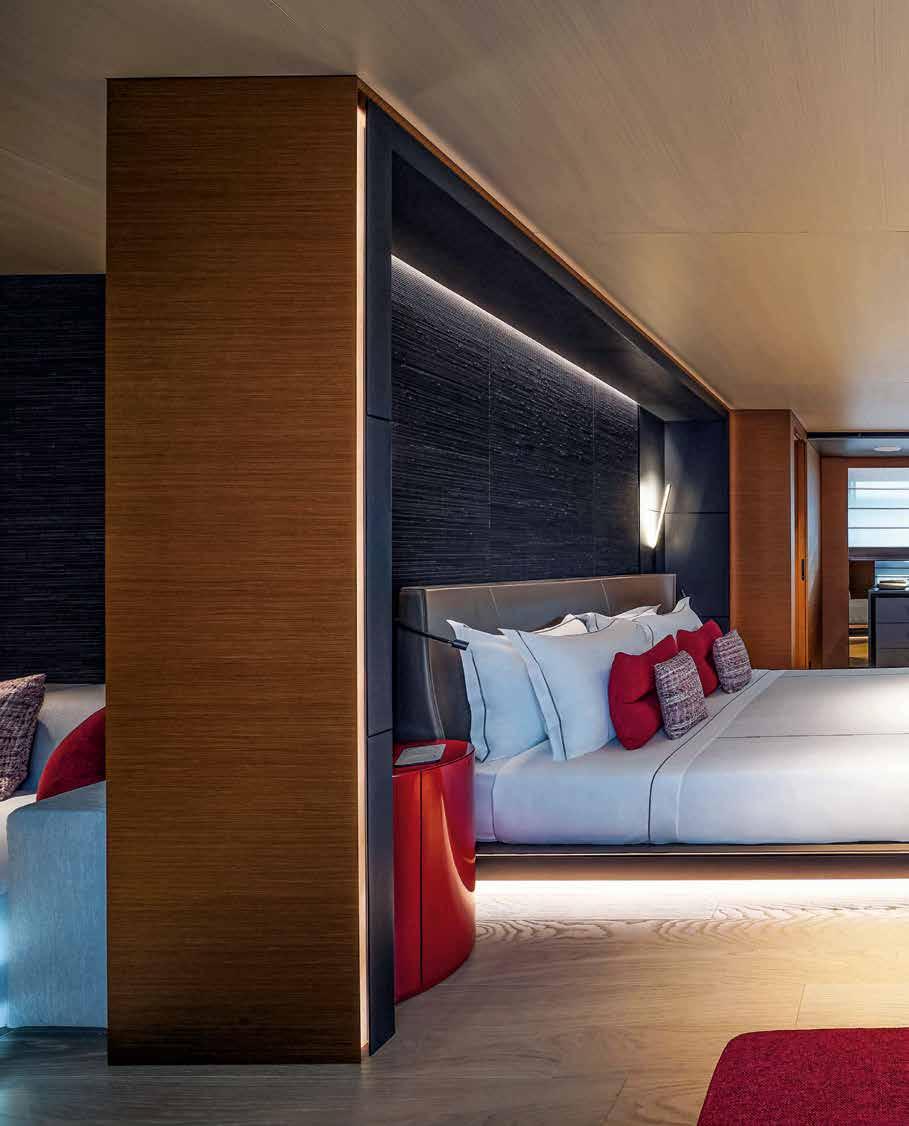
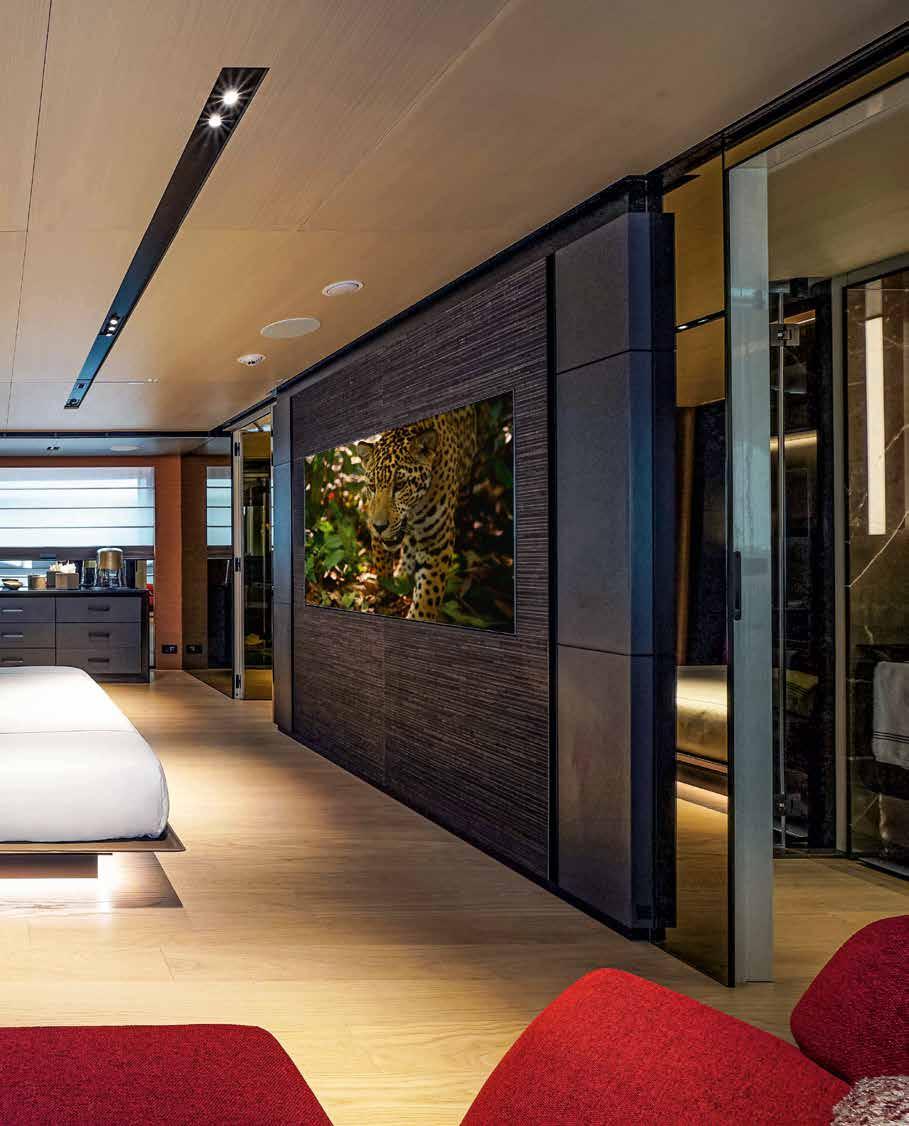



The brief and specifications arising from the earliest contacts with the owner, crucial elements in a bespoke project, focussed on creating new, linear interior spaces based on the yachts he had owned previously. After the initial input the client allowed us to give free rein to our creativity, approving the proposals we made. We concentrated on a contemporary style with a linear elegance generated by clean, uncluttered elements and blending them with details of a refined and sophisticated character, without ostentation. We selected the colour palette on the basis of a specific type of wood, Canaletto walnut. This was chosen by the owner, who developed the guidelines for the décor.
The warmth of the spaces is generated by the colours of the chosen materials, like wood or metal with a champagne finish and soft surfaces like leather. The fabrics mainly display a neutral base tone with accents of brighter colour. All areas are conceived as cosy spaces, surrounded by the warmth of wood and interspersed with strong design elements that give a unique, elegant character to the interiors. Special attention has been paid in the saloons to large openings that generate a constant dialogue with the outside. Here, reflecting the concept of uninterrupted vistas, the vertical structures have been covered with mirrors.
As for managing the natural and artificial light, we realised that as the yacht has generous expanses of glass this means large amounts of daylight flooding in from the sides, which is projected towards the interiors. We also developed evening/night scenarios involving a total absence of external light. In short, with CIAO we’ve sought to create a yacht that reflects design concepts that are driven by a search for refined simplicity.

 Above, the pool on the aft main deck has a glass bottom that lights the beach club below. Below and to side, the owner’s suite – the entrance leading to the sleeping area, the bathroom with marble surfaces and the sleeping area. The style is contemporary with a linear elegance generated by clean, uncluttered elements and blending them with details of a refined and sophisticated character, without ostentation
Above, the pool on the aft main deck has a glass bottom that lights the beach club below. Below and to side, the owner’s suite – the entrance leading to the sleeping area, the bathroom with marble surfaces and the sleeping area. The style is contemporary with a linear elegance generated by clean, uncluttered elements and blending them with details of a refined and sophisticated character, without ostentation
The wheelhouse is surrounded by large windows on three sides.
CIAO’s naval architecture was optimised by using CFD simulations, theoretical computer analyses and tank tests. She is powered by two 1080 kW Caterpillar engines. All systems are concentrated in the 95 square metre engine room

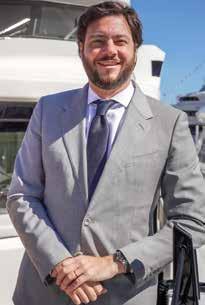
CIAO is a magnificent 52-metre yacht. Like all the yachts designed and constructed by CRN, she is an expression of high-level artisanal skills and Italian quality. We’re proud to have been able to take the constant dialogue with the client and his team as the basis for creating something unique. The finished product is underpinned by CRN’s design and build quality, and is an expression of the longstanding collaboration with Omega Architects, who developed the taut, sleek external lines. As the client requested, we paid great attention to the social areas outside, large, comfortable open-air spaces linked smoothly to the bright, generous interior spaces. As a result we’ve dedicated as much space as possible to the guest area while retaining all the space needed to fulfil operational, technical and crew requirements. For CRN the true-custom philosophy is a way of life, it’s part of our DNA. Developing and building a CRN yacht involves exceptional technical expertise and artisanal skills as well as our team’s constant search for perfection and obsessive attention to detail. A five-deck yacht (including the sub-deck), 52 metres long with a 9-metre beam and a volume of 499 GT has to be
designed down to the smallest detail. This means constant calculating and recalculating to millimetric precision, taking full advantage of the space available to ensure maximum comfort and practicality. With CIAO we’ve created a totally complete yacht – from the point of view of on-board systems she has everything you could find on a 1,000 GT superyacht. My favourite area is the lounge area on the aft sundeck, which reflects the unique character of this bespoke yacht. It’s entirely dedicated to socialising and enjoying on-board life, a multi-functional space that’s perfect for evening entertainment or relaxing moments in the sun. In the centre stands a full-custom table, a twin of the one in the upper deck dining area. The table can be split and anchored at the sides to create an ideal party venue. The star feature on this deck is the horseshoe-shaped lounge-bar that opens towards the stern and bows.
There are many reasons to choose Eccelsa Aviation for your trips to Sardinia


· State-of-the-art dedicated Business Executive Terminal
· Gateway to Costa Smeralda and Sardinia since 1963 *
· 3 km from the Marina of Olbia and 25 km from Porto Cervo
· Complete under the wing services for aircraft up to A340 and B747

· Tailored passenger services
· Full plannig for crew stay(s) at preferential rates
· Hangarage recovery
· Maintenance service in cooperation with Meridiana Maintenance
· Slot- and PPR-free landing and take-off **
· Great value-for-money services and easy payment methods
· Award-winning professional and experienced multi-language staff
However, you can forget about all of them. In fact, what you’ll really appreciate is how you will feel And that’s all the difference between simply landing and truly arriving. So whatever your reason for visiting Sardinia, keep in mind you are always welcome to
Its new 72-metre is the first Admiral to be designed by Giorgio Armani. This refined, elegant yacht is the result of an encounter between yacht-building and fashion excellence, a perfect mix of magnificence and dynamism

Giovanni Costantino, Founder & CEO of the Italian Sea Group, and the couture stylist, king of the international fashion runways, Giorgio Armani, together on stage during the presentation of the Admiral 72m. The project was developed by Giorgio Armani and his team in partnership with the Admiral style centre, and the yacht will be handed over to its owner Costas Cleanthous, founder and CEO of Trading Point, in early 2024
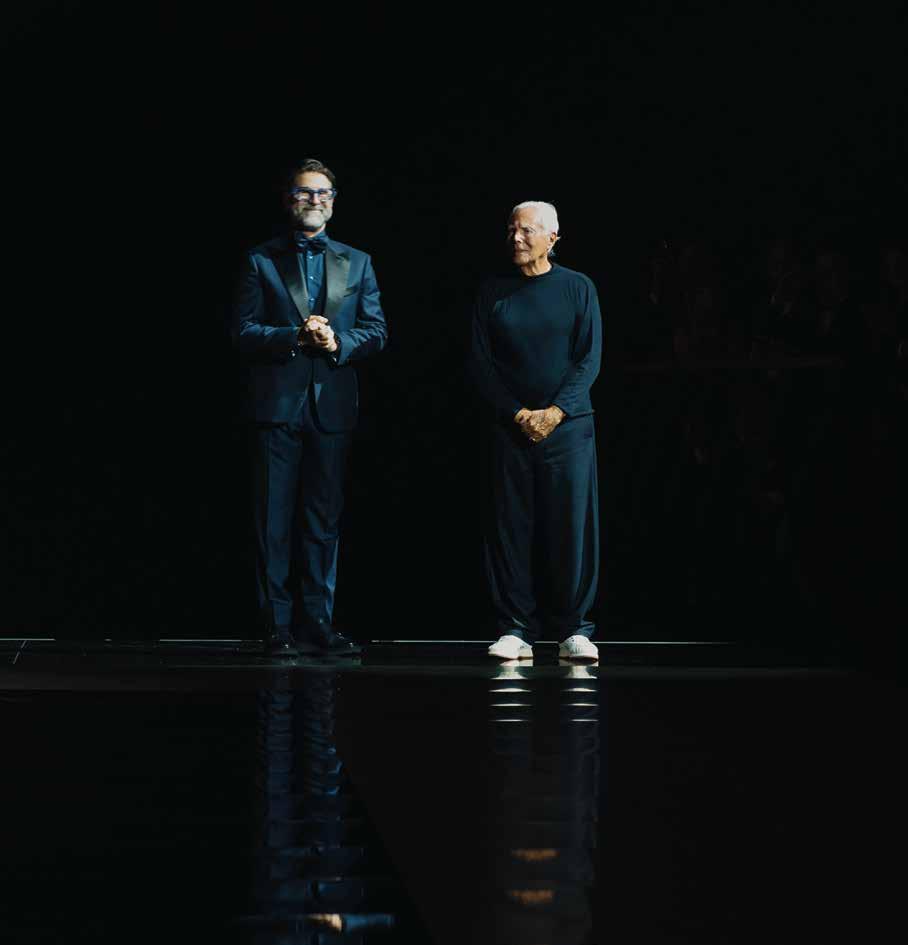
The new 72-metre Admiral is an haute couture yacht created by two centres of excellence – Admiral, the hallmark brand of The Italian Sea Group, a company that designs and builds megayachts admired for their elegance, classic appearance and prestige, and Giorgio Armani, king of the high fashion runways, a figure who needs no introduction. The Admiral 72m is the embodiment of a collaboration between yachtbuilding and fashion excellence. “This megayacht, the result of an exciting partnership that I’m extremely proud of, is the latest confirmation of our ability to take on unique, increasingly ambitious projects with Italian centres of excellence, brands that share our values”, says Giovanni Costantino, founder & CEO of the Italian Sea Group. A global operator in the luxury yacht industry, quoted on Euronext Milan and active in the construction and refit of motor yachts and sailing yachts up to 140 metres in length, the group has already forged partnerships with the most prestigious Italian luxury brands. One example resulted in Tecnomar for Lamborghini 63”, a motor yacht developed and built in collaboration with Automobili Lamborghini, a limited-edition model with breath-taking performance and innovative design. The group’s brand portfolio includes Admiral, known for its prestigious, elegant yachts, Tecnomar, famous for yachts with a sporty character, cutting edge design and high performance, Perini Navi, a centre of excellence in the large sail yacht sector, Picchiotti, a long-established Italian yard producing yachts
The design is rigorous yet extremely appealing, with a clear architectural influence. Large, geometric and imposing volumes combine in a perfect equilibrium with softer, more curved spaces. The generous exterior spaces encourage socialisation and contact with the surrounding seascape
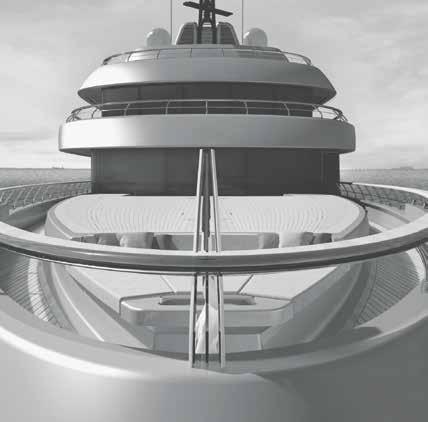
with classic, elegant lines and NCA Refit, handling repairs and refits. Conceived in 2020, the yacht - developed by Giorgio Armani and his team in collaboration with Admiral’s style centre – interprets and blends the DNA of the two brands. “Giorgio Armani is an icon of timeless elegance and refinement and his stylistic vision has helped us hone our aesthetic awareness”, Costantino continues. “It’s a confirmation of our business model, which is oriented towards customisation of every detail to make all our yachts totally unique”.
The idea for the project arose when Giovanni Costantino was passing the Armani Casa display window in Milan. He realised that the illustrious Italian high fashion brand could be the perfect choice to interpret a new way of experiencing the sea. Blending the two brands’ DNA has resulted in a unique, cutting edge megayacht. But bringing Giorgio’s magic and talent into the game was no easy task. “It took eight months of talks with the help of the director of Armani/Casa & Hotel, Fabrice Gouffran, but Giorgio Armani had the final say”, said Costantino during the gala event when the yacht was presented. “We fixed an appointment in Milan. It was an exciting moment, a twenty-minute meeting at the end of which Armani thanked me left. He reappeared a short time later holding a big book. He placed it on the table and after opening it and making a sketch he said, “Giovanni, this is the first yacht I’ll design for you”.
The Admiral 72 metre is in fact the first of two yachts designed entirely by Giorgio Armani. His style is immediately recognisable, reflected by both the interiors and exteriors. It embodies sophistication and a pared-down elegance. The design is rigorous yet extremely appealing, with a clear architectural influence. Large, geometric and imposing volumes combine in a perfect equilibrium with softer, more curved spaces.
The Armani/Casa interiors express the brand’s distinctive style, which can be defined as discreet, refined luxury. The décor has a decisive yet relaxed feel, inspiring a pervasive harmony created by melding the different elements into an exclusive whole. Light plays a crucial role and the surrounding panorama becomes a part of the yacht – a large window
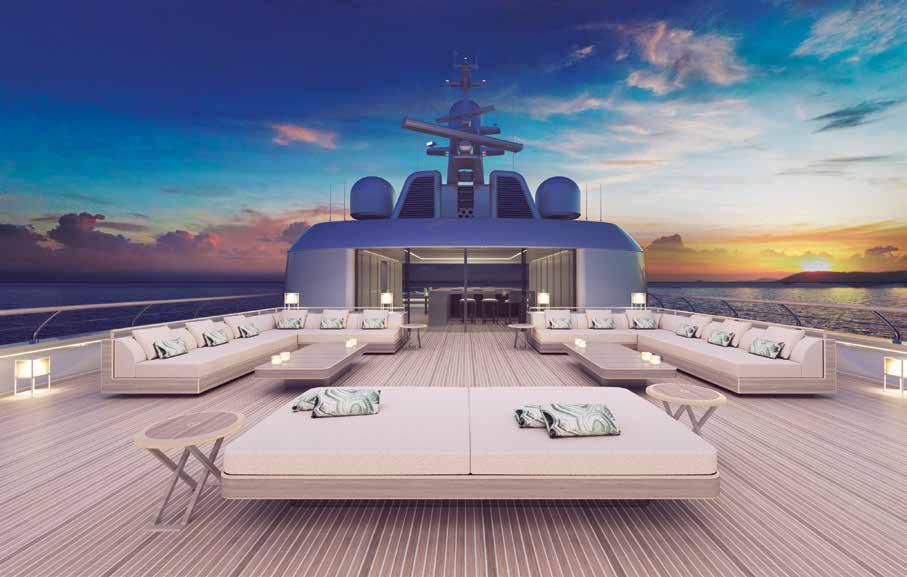

and skilful play of sliding panels bring guests closer to the water. “The sea and design are my great passions”, says Giorgio Armani, President and sole administrator of the Armani Group. “This new collaboration enabled me to apply my ideas on furnishing to the yacht building sector. This means that aesthetics and function work together and combine in a natural, elegant style, just as they do in couture. This stimulating project enabled me to create with Armani/Casa personalised spaces like made-
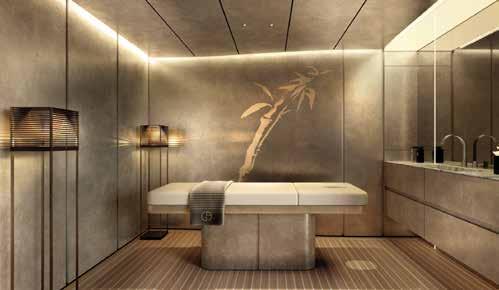
to-measure clothes, with the same artisanal care in the choice of materials and production methods”.
A minimalism that is only apparent unfolds through the use of refined, prestigious materials and select, artisanal finishes combined with a skilful mix of soft and vibrant colours. Costas Cleanthous, the Cypriot owner, is certain to appreciate all this when he steps on board this sartorial yacht in 2024.
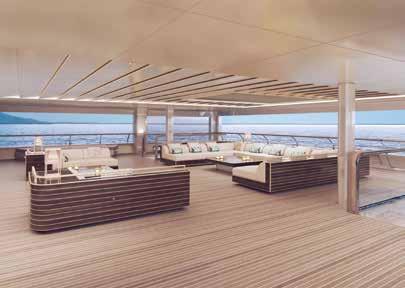

mapping display, high fashion runway show, live music and dinner by celebrity chef Cerea accompanied the yacht’s presentation. With 650 guests, including TheONE Yacht&Design


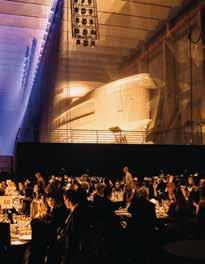
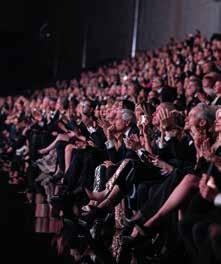
There had never been anything like it, at least in the yacht and motor cruiser world. There were no half measures involved in showcasing the international debut of the Admiral 72 by Giorgio Armani. The headquarters of The Italian Sea Group became a dreamlike setting, welcoming over 650 guests, including owners, brokers, shareholders, officials, actresses and the international press. Giovanni Costantino, founder and CEO of The Italian Sea Group, introduced proceedings and made a passionate speech about the group’s values, describing the most important events in its history as well as the birth of the partnership with the famous fashion house. A laser mapping display revealed the

Some images of the evening event where the Admiral 72 by Giorgio Armani was unveiled, a starstudded affair with many celebrities and show business names among the guests (centre, the actress Claudia Gerini with Giorgio Armani and Giovanni Costantino)
yacht’s lines, not just a profile but in full, virtual reality, appearing as a white monolith completed to the stage before painting, and where work on fitting out the interiors was shortly to take place. This was followed by an exciting runway show of Giorgio Armani’s spring/summer 2023 collection that ended with the traditional appearance by the stylist, who at the age of almost 90 lit up the stage with his charismatic presence. Finally, in a refined setting, also by Armani, guests enjoyed a private dinner by 3 Michelin Star chef Cerea, representing the “Da Vittorio” restaurant, an icon of Italian fine food and wine, accompanied by a live performance by the cover band Inspiration.
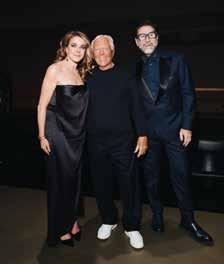 ph. by Lucas Possiede
ph. by Lucas Possiede
Francesca Burdisso and Emiliano Capponi founded their BURDISSOCAPPONI
Yachts&Design studio based in Ravenna in 2018 after accumulating many years of experience in the yacht building sector, especially with the Ferretti Group.
Emiliano creates the external lines while Francesca, backed by her architectural training, handles the interiors. The dialectical thrust of their creative process inspires unique designs that are a perfect synthesis of the owner’s specifications and their personal interpretation

 by Samuela Urbini ph. courtesy by BURDISSOCAPPONI Yachts&Design
by Samuela Urbini ph. courtesy by BURDISSOCAPPONI Yachts&Design
Two complementary points of view that see projects from different points of view and culminate in an organic, harmonious result. The creative process of Francesca Burdisso and Emiliano Capponi is like a tug-of-war where there is no single winner, but rather a yacht that is a perfect equilibrium between the purity of the exterior lines created by Capponi and the beauty and functionality of the interior space, the preserve of Francesca Burdisso. After years working in the yacht building industry and with a shared past as employees of the Ferretti Group, in 2018 they founded the BURDISSOCAPPONI Yachts&Design studio in Ravenna, realising their dream of dedicating themselves to designing. Their work focussed above all on the nautical world but was also based on research into architecture and design, two parallel paths that enabled each partner to draw on the other’s expertise as and when required.
“Emiliano has had a more specific training, oriented towards yacht design, which has always been his great passion”, says Francesca Burdisso. “On the other hand, I’m an architect who entered the yacht building world by chance, but as soon as I experienced I fell in love with it straight away. I work on space, and only then move on to materials and details. Emiliano, in contrast, takes the object as his starting point, the material to be shaped. He has a more sculptural approach, like in the Spartan project (a yacht inspired by the streamlined look famous in America from the 1930s onwards, and intended for an unconventional clientele who appreciate a timeless style drawing on both past and present). These two elements of the project, space and the object, blend in the concept of a yacht that is above all an object floating in the middle of the sea, but becomes a play of spaces as soon as you step on board”.
Almost immediately after the studio’s launch the two designers were tasked with creating the interiors for Emocean, a 38-metre build by Rosetti Superyachts. This went on to win three important international accolades, Revelation of the Year at the Cannes 2021 World Yacht Trophy, the World Superyacht Award 2022 and at the The International Yacht & Aviation Awards 2022, and in the following years the pair continued working with the Ferretti Group. They attracted commissions from private clients and entered into interesting collaborations with brands like Cantiere del Pardo. They are currently working with the yard on a number of projects, including the elegant interior design of Endurance 72, recently presented at the Düsseldorf Boat Show. The yacht is designed for long voyages and offers two interior layouts, one with a kitchen on the main deck and four cabins and five bathrooms on the lower deck and an alternative version featuring a kitchen on the lower deck to leave more space on the upper deck, with three lower deck cabins and four bathrooms. It’s not an unprecedented solution, but it is usually seen on much larger yachts. “We’ve always taken the teachings of the great names in architecture and design as our reference point – coherent design and mathematical rigour in






defining proportions are the principal foundations of our work. Every project is the unique, unrepeatable result of a synthesis of the owner’s requirements and our awareness and interpretation”. The Endurance 72 is a clear example. “In this case we wanted to create a reassuring interior comprising fluid forms, expressions of the formal elegance and clean lines that are the hallmarks of the Pardo Yacht brand.
We used materials and colours that draw on the brand’s DNA –wood as counterpoint to light surfaces. The dominant wood, a grey walnut with matt finish, is used in the elements that define the yacht’s character – the lowered ceiling sections to channel cool air and the sofa bases describe two dynamic orders of horizontal surfaces whose indentations and projections run through the yacht’s two decks”.
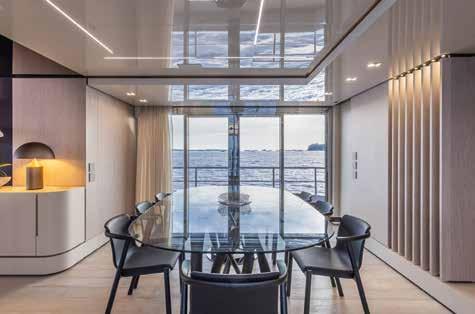
The yacht is currently under construction, with launch set for spring 2024.





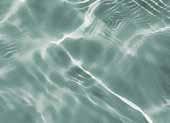

he superyacht industry is still in excellent health, and yards around the world are launching an impressive number of new builds every week. A recent market survey by Grand View Research (GVR) reported that in 2022 the global yacht market size was valued at USD 8.91 billion and is expected to expand at a compound annual growth rate (CAGR) of 5.8% from 2023 to 2030 to reach USD 13.95 billion. The demand for yachts has gradually increased over the last few years, reflecting a growing interest in leisure or recreational activities. The increasing demand for luxury tourism, personalized service and exclusive travel are the primary factors propelling yacht sales. The shipyards also witnessed an increase in the number of orders for new yachts as more people began to travel alone with their families. Significant investment has been made in R&D initiatives that enable yards to offer a unique on-board experience with luxury accommodation. Design plays a pivotal role – captivating external lines and innovative solutions mean yachts can be experienced with total freedom both inside and out, encouraging designers to develop new solutions enhancing performance, comfort and practicality. As a result, yachts are increasingly becoming somewhere it’s possible to spend time with the family in exclusive surroundings and close to nature, while enjoying the benefits of a home on the sea with as little environmental impact as possible. Personalisation through cutting-edge equipment, furnishings and finishes using sustainable materials is now a must, not forgetting, of course, alternative forms of propulsion that mean in the very near future yachts will operate with true zero impact. We take a look at all this in our special section of TheOneYachtandDesign , the latest in the yacht industry.
Désirée Sormani ManagingDirector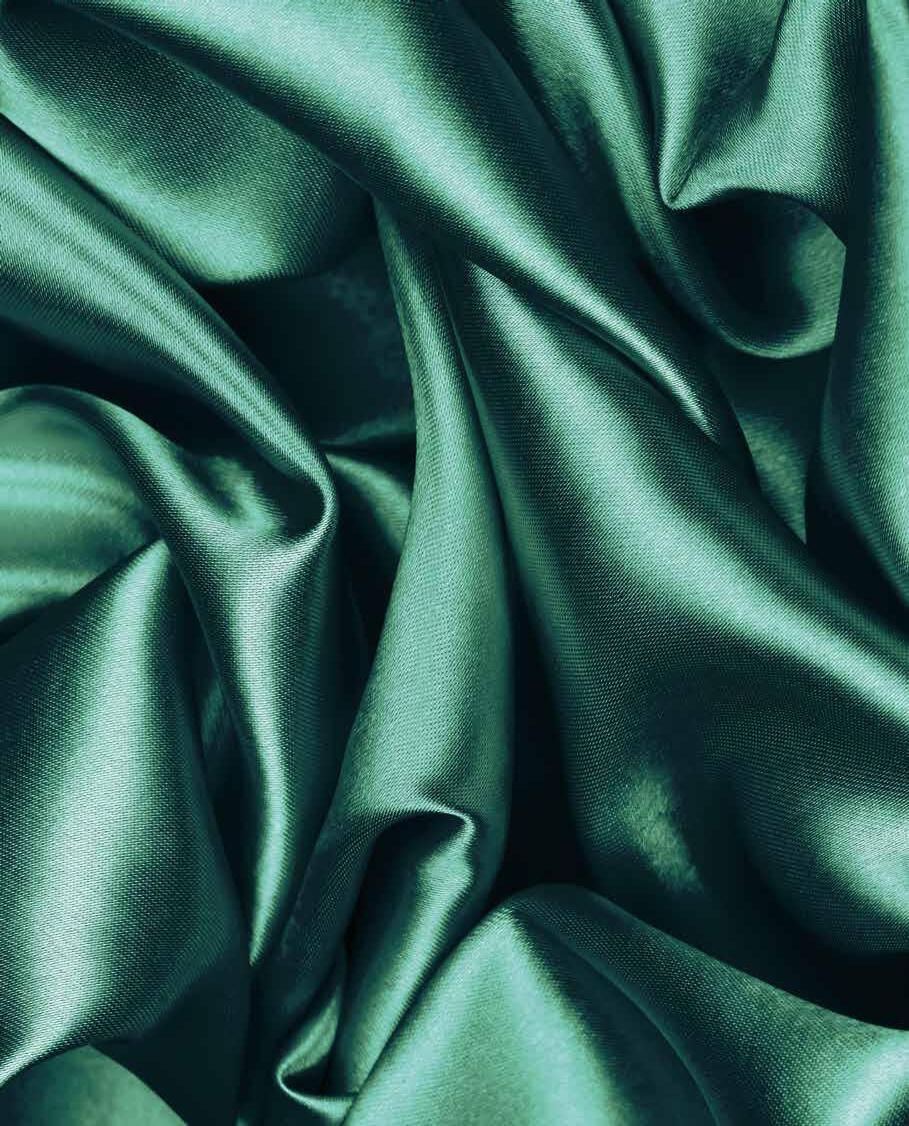
A selection of items from the finest furnishings brands for stylish living. Perfect for on-board use, providing touches of vivid personality and creating a domestic feel in the warm, intimate interiors



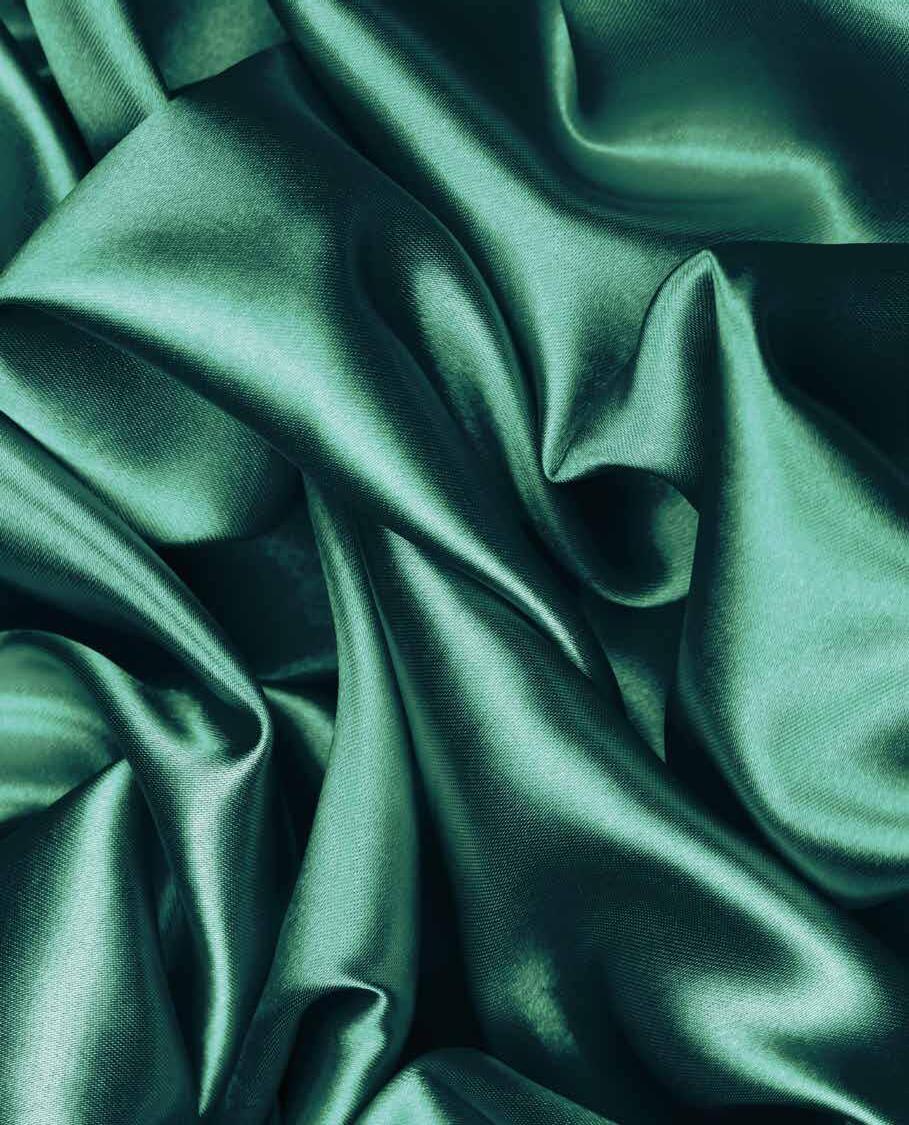 by Veronica Lempi
by Veronica Lempi
With a brass frame and backlit Vetrite hemispheres the discreet elegance of the Venus Wall Sconce by Sicis creates a warm, subtle light. The intriguing lines enhance its decorative appeal. Available in champagne finish brass or brushed nickel
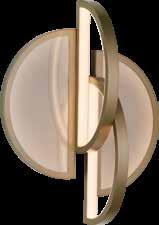
Natural beauty for the coffee table in the Jeko collection designed by Paola Navone for Gervasoni. The ECOTeak base is obtained, with authorisation from the local authorities, from teak recovered from demolished traditional wooden houses on the island of Java, Indonesia


The modular 36e8 sideboard by Lago offers almost countless interpretations to suit all spaces. In a constant equilibrium between full and empty spaces, reflections and transparency, it contains and furnishes with a timeless attitude. In the photo, the unusual polished glass design in Havana and dove grey colours
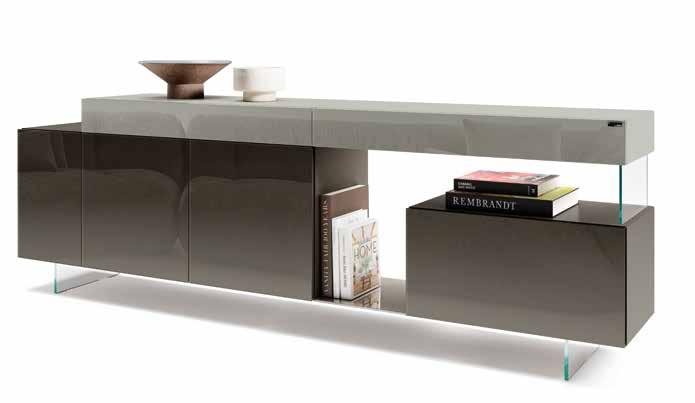
In a preview of the Furniture Show, the Fulham revolving chair by Gianfranco Ferré Home. It cocoons users in a charming embrace, creating an intimate atmosphere. The rounded organic forms are a contemporary interpretation of vintage elements, inspiring a sense of true comfort
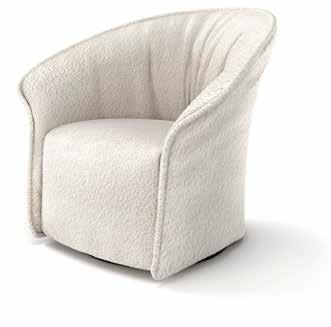
Maximum relaxation. The Karen daybed designed by Ludovica + Roberto Palomba for Talenti recalls African design, expressed through the artisanal work of the back, supported by countless cord threads and interweaving with the circular arms
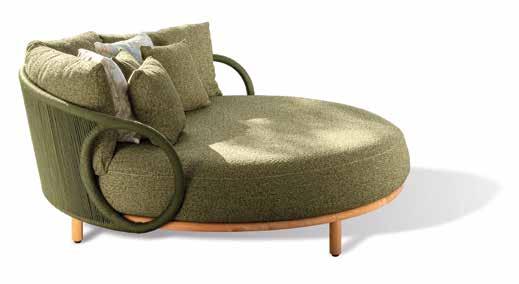
Textured effects for the new Refined Structures 3 wallpaper collection by Armani/Casa and Jannelli&Volpi. In the photo, the Brooklyn model serves as a background for the limited edition of the iconic Logo table lamp by Armani/Casa standing on the Boccherini coffee table, creating a snapshot of timeless elegance. This homage to the famous district is created by the wallpaper’s three-dimensional texture, simulating the network of Brooklyn’s streets and alleyways. This eclecticism is also reflected in the choice of colours, ranging from neutral tones to vivid flashes.

The Borghi countertop washbasin in Cristalmood by antoniolupi in the new Mostato colour is a celebration of the magical atmosphere of the Tuscan landscape. It’s a small-scale reproduction of the freestanding Borghi tub designed by Laura Fiaschi and Gabriele Pardi of Gumdesign, an oval with narrowed base creating the effect of floating in time and space. Apart from its minimal lines it also owes its powerful appeal to the exclusive Cristalmood material, a high-quality polyester resin with colourful pigments. As transparent as glass but tough as stone.

The evergreen Romby chair by Porro, designed by GamFratesi in 2010, takes on a lighter, more versatile new look, with a greater emphasis on the essential. The brand’s geometric purity, manufacturing excellence and artisanal flavour give life to the more harmonious shapes of the padded shell, which in this new version, also designed by GamFratesi, are wider and higher. The conical base is replaced by four central legs in wood, a touch of practicality and comfort.


This is where owners have their dreams transformed into reality. A mix of organisational skills, targeted research, new technologies, and exceptional artisanal know-how drives the production of truly extraordinary yachts. The key concept is a combination of total customization and the latest technologies with the aim of creating increasingly sustainable and environmentally-friendly craft


Soft, clean, sinuous lines, large interior spaces and a stern open to the sea, the new Perini Navi fleet, brand of The Italian Sea Group, strikes a successful balance between respect for tradition and a desire to look to the future
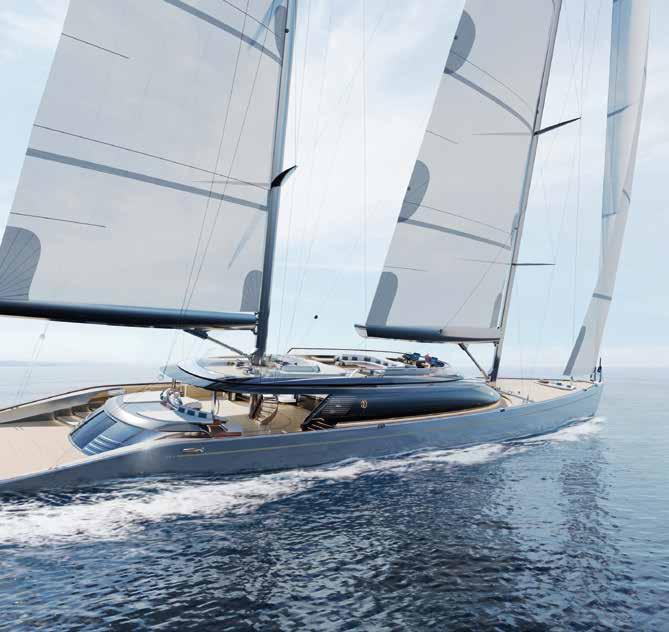 by Paola Bertelli
by Paola Bertelli
With four yachts currently under construction, including a 60-metre two-master, a 47-metre aluminium sail catamaran, the largest of its kind ever built, and the presentation of the new Genesis fleet, The Italian Sea Group is now fully occupied with the relaunch of the Perini Navi brand. Genesis, as the name suggests, highlights the brand’s new initiative. Perini Navi, taken over by The Italian Sea Group (TISG) a year or so ago, is presenting its new fleet with three models, a 48, a 56 and a 77-metre, and it’s doing so with conviction, strength and personality. Never forgetting the past, the new Genesis yachts embody the Genesis legend while remaining well aware of living in the present and looking to the future. Stylistic details and iconic elements are given a modern reinterpretation, the spaces grow larger, the beach areas expand and as is now obligatory, they are open to the sea. The large, restyled deckhouses take on soft, rounded shapes without losing the typical Perini shoulders and the double strip of windows recall the first models with raised helm station. Elegant and cutting edge, they have versatile, light-filled interiors ready to host works of art and exclusive brands for the enjoyment of owners and guests.
TISG’s experience in the motor yacht world has brought with it a constant search for greater comfort and practicality in the sail yacht sector. The Genesis 48 metre is available in two versions - cruise with 80 square metre flybridge and regatta, without flybridge - and has new keel lines designed to enhance sailing comfort, twin rudders and swing centreboard to reduce draught and make it possible to access more harbours
and bays. On the regatta version it’s also possible to mount solar panels on the coachroof top to complement the hybrid/electric propulsion.
Malcom McKeon Yacht Design developed the naval platform for the Genesis 56m, a ketch that has the complex task of revisiting the most iconic Perini Yachts. The first renderings show the huge, stunning beach club and the spiral staircase leading to the immense flybridge with hydromassage pool. Perini Navi’s sail handling system is managed from the flybridge, with all the running rigging concentrated in the two command stations. The new fleet also features the Falcon Rig, two rotating masts without rigging and square sails – it’s mounted on Genesis 77, a two-master with spa-beach club with unfolding terraces creating a seamless connection to the aft swim platform.
The new Genesis line is complemented by four superyachts currently under construction. The first is a 60-metre ketch, the most recent in the “Classic” series, with enhanced sail plan, to be launched in 2024. Due for delivery this summer, is the largest sail catamaran ever built, 47 metres long by 17 metres wide, designed by Axel De Beaufort. It’s named Art Explorer after the Art Explora foundation created by its owner, Frédéric Jousset, an entrepreneur and member of the board of the Louvre. After this, 2025 will see the launch of a 56-metre ketch by Malcom McKeon and Winch Design and a 47-metre sloop.
The declared aim of Giovanni Costantino, founder and CEO of The Italian Sea Group, is to produce two yachts a year and to enjoy peaceful sailing with the wind at his back.
www.perininavi.it

Lower than the deck, the half-moon shaped forward lounge of Genesis 77 is a welcoming, scenic space. Below, the yacht under way. Opposite page, the regatta version of the Genesis 48 with solar panels mounted on the top. Opening, the Genesis 56


There are currently four Perini Navi models under construction, to be launched between this summer and 2025. Here, a rendering of the light-filled main deck saloon of the 47-metre sloop, to be launched in 2025
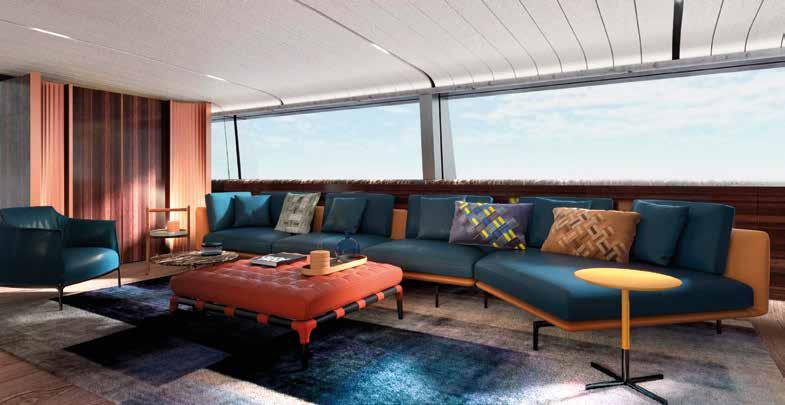

What was your starting point for redesigning the Perini yachts?
Genesis indicates the origin, the birth of a new project. The external lines of the Genesis fleet reflect two essential elements of the Perini philosophy – a desire to give a contemporary interpretation to the classic Perini Navi style, famous throughout the world for its elegance and sobriety, and to express a contemporary, timeless approach that is directed towards the future. The main interior spaces also tend to be spacious and flowing – their various intended functions establish a direct yet discreet dialogue, fulfilling the required purpose as well as having an open, dynamic spatial form.
What type of owner would purchase one of the new Perini Genesis yachts?
Most of all Perini Navi sail yacht owners love the sea. They’re looking for adventure and freedom, privacy and luxury. They want a yacht that can sail anywhere in any weather, and they’re searching for a deep, enduring relationship with the sea, on board a yacht that embodies uncompromising uniqueness and perfection.

Is it correct to talk about the Genesis line as semi-custom superyachts that will complement the custom production?
Building yacht projects of this type is always full custom.
Exclusive brands, works of art…superyachts are increasingly becoming reflections of their owners’ homes.
How much influence does this have on your sail yacht designs?
The starting point for our yacht designs is always the owner’s requirements. The owner is the most important person in the whole project, and we develop concepts that reflect our high standards hand in hand with them. Stylistic innovation is our hallmark – all our yachts are unique and we’re constantly searching for new creative solutions.
How do you see the future of the sail superyacht world?
The pleasure yacht industry is enjoying a successful period on a global level, despite the complicated geo-political situation. The sector is once again a very dynamic market. Sooner or later things are bound to cool down. The large sail yacht sector, very small in relation to the world market, is more resilient than other areas, partly because we have a very loyal international client base comprising solely ultra-high net worth Individuals who are less affected by economic recessions.
Dynamic, masculine and fast, the yacht under construction at Vittoria Yachts is set for launch in January 2024. This 32-metre aluminium semidisplacement craft has a maximum speed of 20 knots. It has a unique look, with extraordinary, versatile open-air zones and bright, contemporary interiors
 by Paola Bertelli
by Paola Bertelli
ith decks now integrated into the superstructure, work on the Veloce 32 RPH is progressing rapidly at Vittoria Yachts, with launch scheduled 2024. The yacht is the first build by Vittoria Yachts, an offshoot of Cantiere Navale Vittoria, which for over almost a century has been building military, civil and commercial vessels. With origins and experience of this calibre the skills wielded by the entire team, from the technical office to the carpenters, display extremely high levels of expertise, now used for the construction of designs appealing to a new type of clientele.
Together with Sergio Cutolo’s HydroTec studio, which handled interior and exterior design and naval architecture, Vittoria Yachts is building a sophisticated Made in Italy custom yacht that incorporates all the characteristics typical of a superyacht within its 32 metre length. It is laid out over three decks plus an intermediate deck hosting the wheelhouse, set between the main deck and fly bridge. With its vertical bow, raised gunwales, low-profile wheelhouse and reverse windscreen, Veloce 32 RPH displays all its imposing presence and racy, dynamic character, but when at anchor the emphasis shifts to the close contact with the sea that is part of the yacht’s DNA. The stern becomes a wonderful relaxation area and the cockpit sides drop to create a terrace on the water that flows seamlessly into a beach club pieds dans l’eau. The sun deck features a generous open-air space with large horseshoe-shape
upholstered seating unit and sunpads. In the centre a bar counter and dining table, sheltered by the top and transparent side panels integrated into the superstructure, dialogue with the conversationrelaxation area aft, furnished with sofas, sunpads and a spectacular hydromassage pool – the side facing the sea is transparent. The contemporary interiors feature soft, sinuous lines. In the saloon the full-height sliding side windows entirely remove any barriers between the worlds within and outside the yacht. The owner’s suite with private study lies on the forward main deck. A further four guest cabins are sited amidships on the lower deck, with the crew quarters in the area further forward.
Veloce 32 RPH is an aluminium semi-displacement yacht, designed with the aim of addressing a market segment that until now has been left relatively unexplored by 30-metre craft, the niche between fibreglass planing yachts and displacement models. Powered by two 1900 hp MAN engines, Veloce (which means “Fast” in Italian) has a top speed of around 20 knots with a cruising speed of 10 knots and a range of 2,000 miles.
Vittoria Yachts also has a second yacht, Bow Sprit, under construction, a 54-metre steel and aluminium explorer. With a unique style, Bow Sprit is inspired by fishing and commercial craft, reinterpreted in a much more luxurious key. The bowsprit from which it takes its name contributes to the yacht’s unmistakeable profile and provides a privileged observation point for an all-round panorama.
www.vittoriayachts.iz

The saloon and owner’s suite on the main deck. To side, when the yacht is at anchor the cockpit sides drop to create a magnificent sea terrace that communicates seamlessly with the beach club and garage for toys and tender
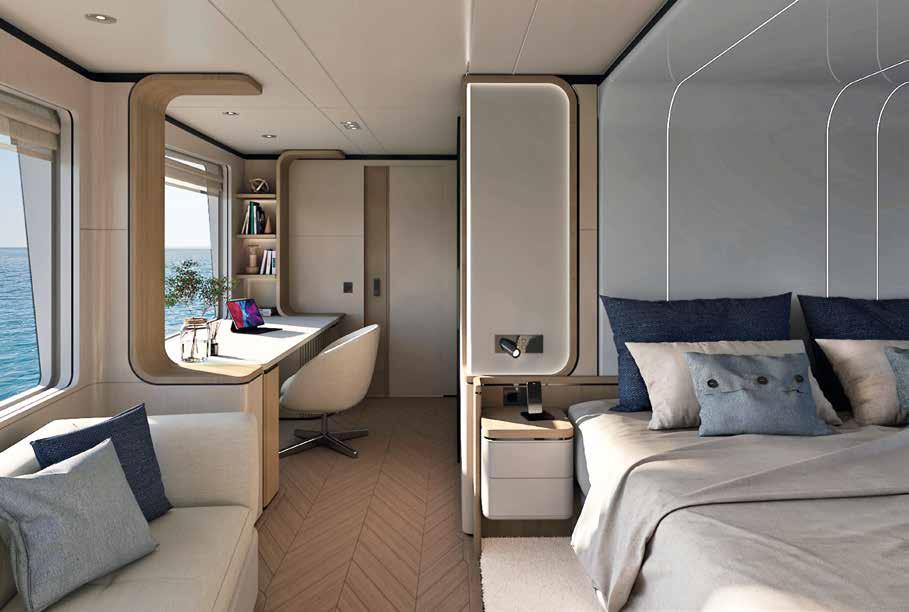


How important is your experience in military vessels and how do you reinterpret it in the luxury yacht market?

Our experience in military and civil shipbuilding is a decisive factor in our work. It gives us great mental versatility and agility and encourages us to pay great attention to detail, ensuring stability and strength in all our models. We apply the construction philosophy behind our patrol boats and ships to pleasure yachts, a sector where advanced technology dominates but also benefits from influences and developments we can bring to bear.
What part of the Veloce 32 RPH project are you most proud of?
Veloce is a semi-displacement that can sail at 20 knots. It has the characteristics of a superyacht and is an aluminium build. What makes me most proud is having given shape to an exciting, innovative project, the perfect solution for new market requirements.
Who are the ideal Vittoria 32 owners?

They’re people who like to travel at speed with all the benefits provided an aluminium build without compromising on comfort, from the beach club to the interiors. In short, the ideal owners for this project are looking for solidity, convenience, practicality and speed, with all the values Vittoria embodies.
You also have Bow Sprit under construction. How far along is the build? What are your main future projects?
Bow Sprit is making rapid progress. We have many new developments on the horizon, including a very special design variant…but you’ll hear talk about it soon.
Traditional, hybrid, electric and hydrogen propulsion… How do you see the future yachts? What direction are you moving in?
We’re seeing a market trend in that direction, many yards are starting to focus on sustainability, but I think that’s actually driven by the requirements of image. Technically, full sustainability in a short period is hard to achieve.
Nevertheless, hybrid propulsion is a good solution, one that’s experiencing increasing demand.
As a result Vittoria Yachts, drawing on the construction experience of Cantiere Navale Vittoria, can integrate this kind of propulsion into its designs, with an eye to the future.

Designed to enable owners to enjoy family holidays at sea, the MY 62’ is the yard’s smallest model but still incorporates many innovative features, with special hybrid propulsion based on a patented 105-square-metre retractable solar panel array that enables long, silent voyages with zero consumption
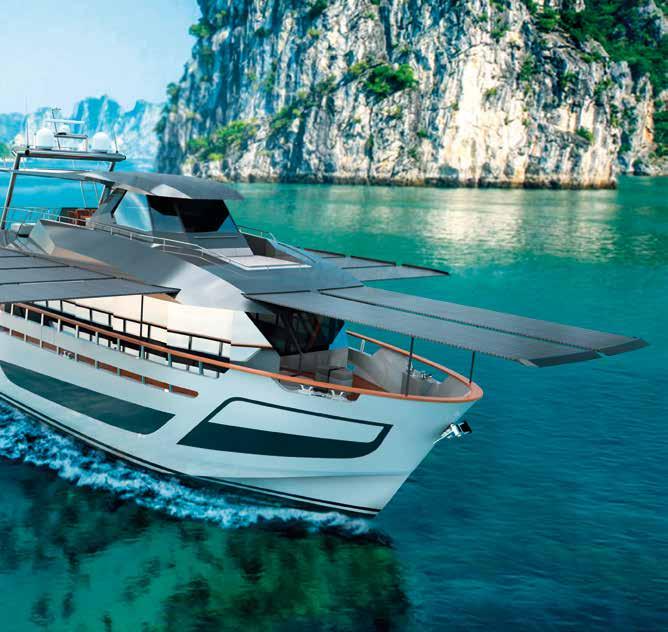 by Samuela Urbini
by Samuela Urbini
Arendering of the MY62’, the latest project from Fabiani Yacht, immediately shows that it is something revolutionary, a highly-innovative yacht that has captured the attention of many visitors at the most important boat shows, most recently Boot Düsseldorf early this year. Three-dimensional models make it even clearer just how extraordinary this 19.25-metre family yacht really is. The retractable 105 square metre solar panel array enables the yacht to sail at 6-8 knots for nine hours at six knots or four hours at eight knots, wrapped in silence as if on a sail yacht, at no expense and with zero environmental impact. The solar panels are concealed in the double layers of the main deck and the flybridge canopy, and small electric motors extend them to the front and sides. They can function while under way in suitable weather conditions, increasing the electric-powered range. The system has been patented by Maurizio Fabiani himself, the passionate founder of Fabiani Yacht, a young Livorno-based yard. Initially it enjoyed the legacy of the Intermare yard, founded in 1973 and then closed in 2008 as a result of the crisis in the yacht-building industry, which Fabiani transformed into a totally new concern, building larger yachts than the previous Intermare models. His products are based on technological innovation, unique models, respect for the environment and beauty of form. The brand’s offer currently comprises five models from 62 to 101 feet long, all available in either a classic or hybrid version.
However, it’s Fabiani’s hybrid system that merits the closest attention, as it is not the classic electric propulsion drawing energy from batteries charged by diesel engines – the power is generated by the retractable solar panel array and is then stored in the batteries, cutting consumption, pollution and noise levels when under way.
Of course, these yachts also have two diesel engines (MAN 1300 hp units on the MY62’), providing a cruising speed of 18 knots.
Caring for the environment is one of the key elements of the yard’s philosophy, expressed through its development of the special hybrid propulsion model but also its choice of materials – all the yachts are designed as aluminium builds, using no fibreglass, making them recyclable.
The layout of the MY 62’ is rational and optimised. It has a 6.19-metre beam and large windows, the main deck is spacious and airy and features a large saloon with sofas, armchairs, TV aft and a bar/ kitchen with scenic dining room forward.

The helm station, air conditioned and with opening windows, is on the flybridge, with a generous cockpit and panoramic sunpad space forward. Below deck the sleeping area comprises three double cabins with bathroom and two with bunk beds for the crew.
The interiors of the MY62’ draw inspiration from those of the topof-the-range 101’, and are bright and elegant, with select materials like marble in the bathrooms, which can, of course, be personalised on the basis of the owner’s desires.
www.fabianiyacht.it
On the main deck, the bright saloon (above) and the bar/ kitchen with scenic dining room (below). Opposite page, a stern view with the solar array deployed and the multifunctional platform that goes from one metre below the sea to the flybridge


The owner’s cabin on the forward lower deck is also full of light thanks to the choice of furnishings, which can be personalised by the client. It is accessed through a corridor running along the yacht from bow to stern, making it also convenient for differently-abled guests
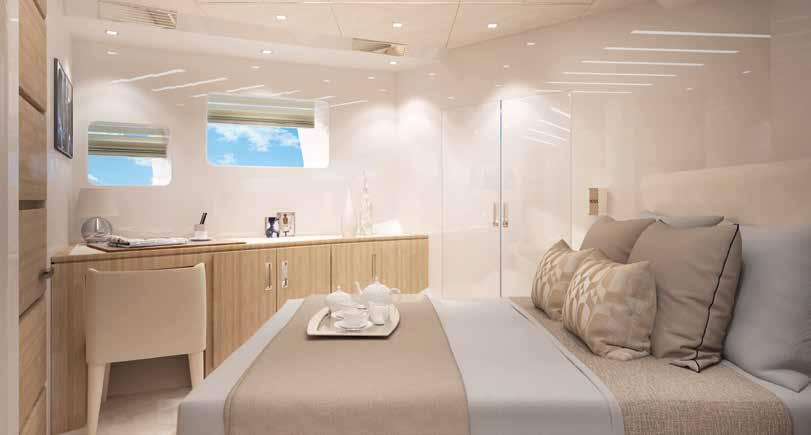

What type of owner is the MY62’ intended for?
This project is intended for families, and has a considerable amount of space on board. It’s the most compact model in our offer, a solution we’ve developed to attract potential clients to interior layouts that are attractive, practical, easy to use and offer satisfaction and reliability.
Your first model, the 77’ hybrid, is currently under construction. How is that progressing?
All the projects are carried out in collaboration with the engineer Mario Grasso’s Navirex Design, with who we’ve stablished an on-going synergy. The hull’s ready, we’re working on the superstructure. Until the build is complete we think that people won’t be able to appreciate its potential to the full without a degree of scepticism. One on the water, though, it will amaze crew and guests.
Can you explain the virtues of the multifunctional platform, your patent, which is present on all your craft?

It’s a platform mounted aft that move from a metre below the water, especially convenient for swimming, to the flybridge, becoming a beach club, gangway, travel-lift or extension to the flybridge or cockpit, with “candleholders” that rise to form a parapet to provide safety. Our platform goes around 2-3 metres higher than its equivalent on other yachts. When at berth it lines up with the quayside and an extending element with a folding steel ramp provides easy access on and off so that wheelchair users or pushchairs can board or disembark safely.
As well as environmental awareness your projects also show respect for differently-abled people. Could you explain your choices?
Apart from the multifunctional platform, there are no interior stairs between the various decks and below deck a central corridor runs from bow to stern so that differently-abled guests can also access their cabin independently, avoiding any potential inconvenience.
What advantages are offered by your hybrid yachts?
There are the classic two diesel engines on board our yachts. The electric motors are on the inverter. If you’re sailing under diesel power the electric motors can be disconnected. If you want to access a marine reserve where sailing under electric power is permitted, these yachts can enter if you switch off the diesel engines and sail on battery power alone, in total silence with zero fossil fuel consumption and zero pollution.

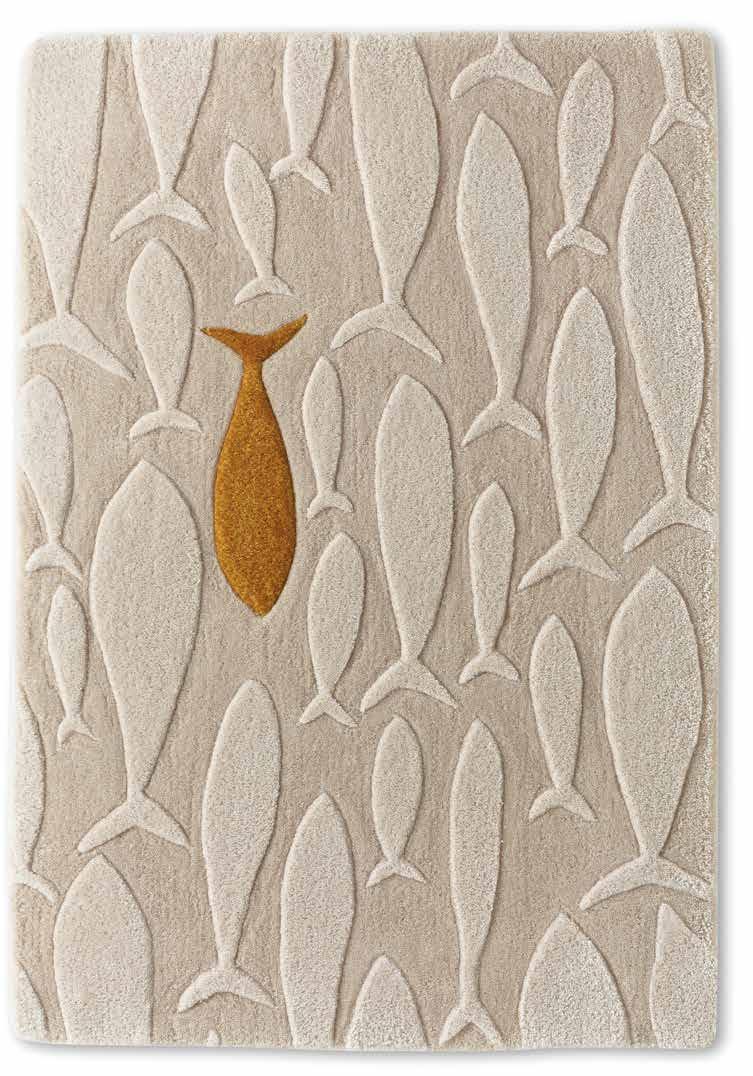
Treading an OT carpet can feel like walking along Carribbean beach, through the leaves of an Amazon rainforest or even a shaol of darting fish....there are literally no limits to OT’s creative scope. Renowned across the luxury yachting sector for its sublime craftsmanship, the German bespoke carpet specialist only uses the highest quality natural materials. This year, however, the company has taken its byword of “Design and Nature” to new levels. “It means never forgetting to have an eye for all the wonderful details Nature gifts us everyday. This has been part of our ethos for decades. Our job is to constantly draw on this huge library of endless possibilities and solutions,” says Oliver Treutlein, who founded the company in the town of Meerbusch in a region of Germany where the textile industry is very much part of life.
Made by OT’s craftspeople from luxury natural fibres, such as pure silk, cool linen and ultra-fine New Zealand virgin wool, OT’s carpets really are unique hand-tufted masterpieces. They have been adding the ultimate finishing touch – the perfect dash of flair - to the largest and most spectacular yachts plying our oceans since OT first entered the nautical arena nearly 40 years ago. “It grew out of my passion for sai ling and yachts,” confesses Oliver Treutlein who now works mostly with the leading international custom-build shipyards. When he started out in 1985, he made the carpets to order himself with the help of just two employees for interior designer and architect clients. Creating those custom designs for custom projects laid the foundations for OT’s subsequent focus and success. “From the beginning, we were very different from our competitors,” continues Oliver. Everything is the highest quality from the very first sketch to the installation phase. “Our carpets are a natural handmade product,” adds Elke. “We have always produced a sustainable product as we do not use any chemical ingredients.” Collaborations with renowned international designers have yielded collections that chime perfectly with the needs of highend interior designers.
Remaining a tightknit family business has also played a pivotal role in the OT success story. Indeed, Treutlein now runs the firm with his wife Elke, their daughter Julia (who joined five years ago and now works on client relations) and her partner Max (who joined it after completing his studies in finance two years ago) “The next generation is on the starting blocks, and together we can continue to develop our family business with their fresh ideas and inspiration!” concludes Oliver. www.olivertreutlein.com
Shoals of fish following the ocean currents, coral reefs, whales – all motifs from OT’s new Sealife collection. The company was founded 43 years ago by Oliver and Elke Treutlein, who are now flanked by the next generation, their daughter Julie and her partner Max

Returning again and again to nature to create the perfect motifs and geometries as well as to source of the very finest materials. Before skilfully crafting them into masterpieces of design. That’s the OT way....
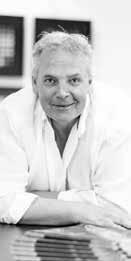 Founder
Founder
Feeling and flow of emotions. Design and Nature. What does it mean?

To learn and never forget to have an eye for all the wonderful details in nature. That means any design that is based on or follows the rules nature teaches us. Clients always love the result even though they may not know why exactly. Does it mean that respecting the planet is one of your goals when making your bespoke carpets?

This was never an issue for us. We have made our carpets in the most ecofriendly way for over four decades, using only natural yarns and materials. The inspiration for our designs comes from the bottomless basket of possibilities that nature provides us with. This is the most sustainable solution and gives clients a real feel-good environment. The main and highest quality material we use is 100 per cent pure New Zealand Wool which we source through special contracts over there. We also offer clients five different qualities of silk as well as cotton, cashmere and natural fibres of all kinds.
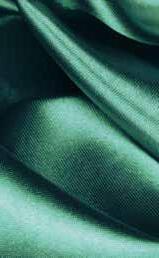
From the design point of view, which images and colours most closely reference nature in your opinion?

Regardless of what we are working on, we base our design on the client’s dreams and desires. The result is that it can be subtle, very ton-sur-ton, or full of life and colours like nature itself. However, we can never compete with nature because nature is perfection. We try our best to learn from nature, to understand the beauty of that perfection, and then put it to use.
What are owners asking for nowadays onboard their yachts?
We work all over the world and our international clients come to us for their yachts, homes and planes. They want outstanding design and solutions. We honestly get asked for all kinds of different designs – everything from contemporary to modern, classic, Art Nouveau, Bauhaus, etc. Our ultimate aim is to never sell or create our own tastes. Our only goal is to use our experience to make the client’s dreams and wishes come true.
What’s next?
Whatever challenge life holds for us!
OT’s bespoke designs laid the foundations of its success. Everything from the very first sketch to the installation phase is of the highest quality. Crafted by hand from luxury natural fibres, such as pure silk, cool linen and ultra-fine New Zealand virgin wool, these carpets really are unique hand-tufted masterpieces
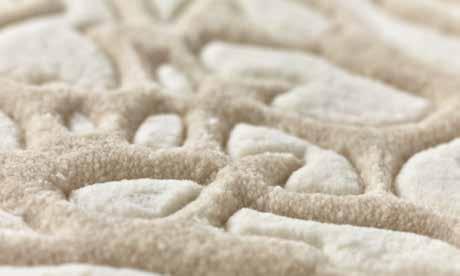


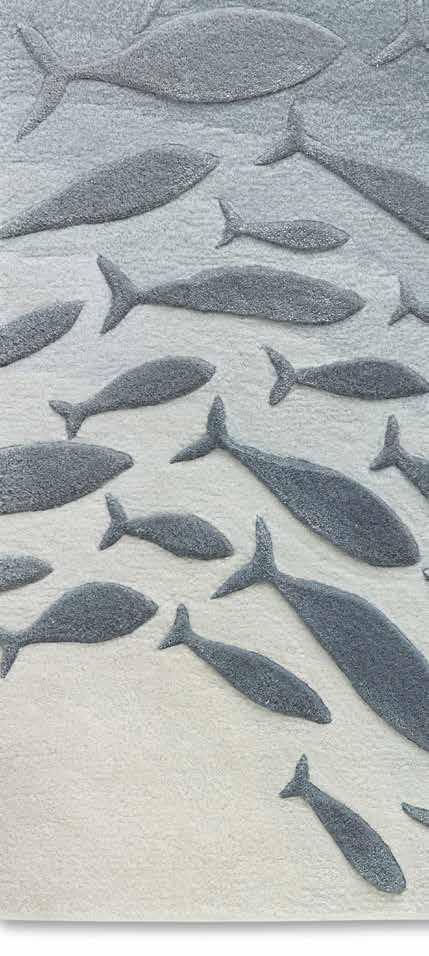

Until recently they were regarded as simply unimportant add-ons in an interior design project, but now control devices have acquired the status of functional and attractive assets that can enhance the look of any interior. Italian company PLH has launched an intriguing initiative whose aim is to broaden the scope of applications used in lighting design and domestic automation.
The company was founded in the early noughties as a spin-off brand from an established electronics and IT business. The project was sparked off by an idea from Enrico Corelli, who recognised the aesthetic potential of previously humdrum devices used in domotics. His vision was based on a handful of elements – the choice of materials like solid metal (aluminium, stainless steel, brass, copper), wood and DuPontTM Corian®, shunning plastic, and a stylistic appeal impervious to changing trends. The production process also reflects the sartorial nature of the products, which means shapes, materials, textures and surfaces are chosen and worked without restrictions. As a result of this design approach all PLH collections, cable or wireless, can be personalised using laser or plotter marking machines, and can be given finishing treatments that require
high-level artisanal skills, like satin finishing, micro-sand blasting, polishing and oxidation. This production strategy provides great exclusivity and generates demand from an especially sophisticated sector – luxury yacht building.
PLH plates are enjoying exceptional success in this special design area. Some exclusive features of the PLH lines are especially appreciated by owners and designers – the Slim collection, for example, is only 4mm thick, which means it blends almost seamlessly into the surface it is mounted on. Piero Lissoni chose Slim and Slim Custom plates for the interiors of the Sanlorenzo SX112, Patricia Urquiola chose Slim with black buttons and Neo for the lighting on SD96, also by Sanlorenzo, while Antonio Citterio and Patricia Viel went for total custom plates for the luxurious interiors of the Navetta 30 by Custom Line, a Ferretti Group brand. PLH products have a wide range of uses, harmonising with different style concepts.
Riva, another Ferretti Group brand, opted for PLH collections for all the yacht range. New design possibilities are now provided by PLH Belcanto, a switch plate with superb tactile qualities for controlling light and music.

www.plhitalia.com
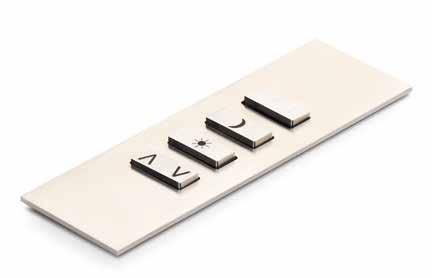
High-level performance and cutting-edge technology have taken PLH to the peak of the domotics sector, which also fits perfectly into the luxury yacht world

Let’s talk about the exciting new arrival –what is PLH Belcanto?



Belcanto is a sound system that integrates with switches and outlets we’ve created and developed in partnership with Outline, a Brescia-based company that’s a leader in production of professional audio systems and digital sound processing solutions. A year of intense, complex and exciting development led us to create a miniature system with a wireless amplifier (the Maestro), two mid-range tweeters (the Contralto) that can be integrated into the control plates, outlets or single installations and a subwoofer (the Baritono), which completes the sound quality by giving the system depth and power.
What opportunities does a light and music control plate provide?
This system, now ready for launch, is designed to enhance the sensory and emotional experience in private residential settings, hotel rooms and on-board yachts. Take, for example, the wrap-around stereo effect the sound plates can produce when installed in the bed head. The controls are positioned at exactly the listening height, so the speakers linked to the controls are in the perfect location for listening and control. What makes your products competitive in the high-end sector?
The opportunity to make new pieces that meet the requirements of architects and demanding clients who see custom products as providing added emotional and aesthetic value. How do you achieve this design flexibility?

We don’t use prints, but 3 or 5 axis numerical control machinery that enables us to create, on the basis of a strip of material, anything the client or architect wants. Then there’s our great expertise in finishings and treatments. Can you give some examples of especially interesting bespoke PLH products?

We’ve created plates with Rubelli silk inserts and others using a selection of Antolini marbles, split to a thickness of just 1mm. We also use antique, inlaid woods that can be transformed into devices.
Above, the Riva 100’ Corsaro and its owner cabin with personalised Slim plate can be seen in the door to the bathroom. Below, the 34 metre SX112 by Sanlorenzo, with interiors designed by Piero Lissoni, and a detail of the living area with personalised PLH wall outlets

Left and below, some examples of the many possible colour and decorative combinations in the Mono collection, inspired by Bauhaus design principles with an emphasis on simplification and ease of use. Its minimal aesthetic dominates, except for the number of controls. Top and right, the new line from PLH, now ready for launch – devices in the Belcanto collection, created to offer a new sensory experience. Opening page, plates from the Slim collection

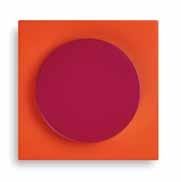


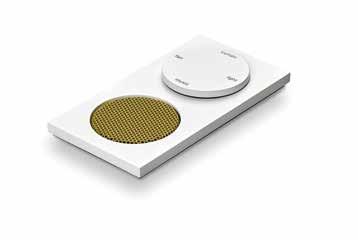

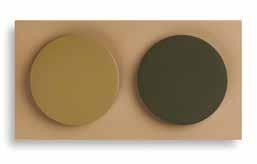

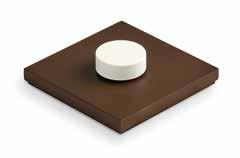
Besenzoni makes an impressive appearance at the Milan Design Week 2023 with Flow, a striking installation in the porch of the courtyard at Milan’s Università degli Studi, an iconic location for culture and research.
Flow, by Francesco Forcellini, is a work that will fascinate, stimulate and intrigue. It measures 9 metres long, 2.5 metres deep and 1.75 metres tall, and its subject is the Oceano staircase/platform, enveloped in a huge polystyrene and fibreglass wrapping painted in a special mirror paint.
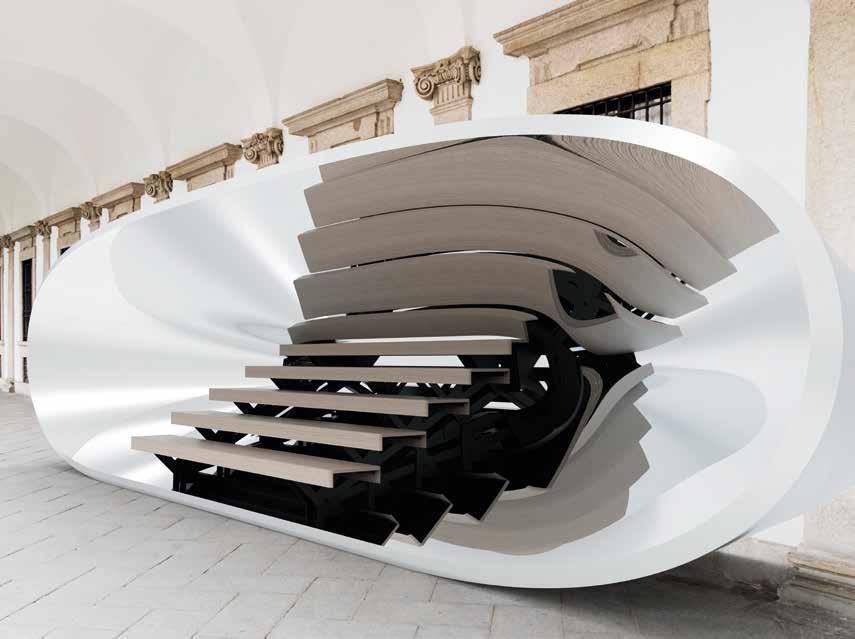
The reflective surfaces launch the visitor into a virtual space, a setting to explore and experiment, accessed by the Oceano stairs.
In the words of Francesco Forcellini, “The name Flow expresses the fluid movement of things in the most positive interpretation of the idea of change, a sequence of evolutions to create a revolution. Innovation lies at the heart of the concept of evolution, because to progress you have to renew, change paradigms and methods”.
Besenzoni has been doing just this for over fifty-five years, transforming itself from an artisanal metalworking concern to an industrial company introducing a stream of innovations to the yacht-building
For Besenzoni, the link between design and innovation is becoming ever closer. Its Oceano stairs-platform is the fulcrum of a visionary installation by designer Francesco Forcellini on show during the Milan Design Week, the perfect showcase for a company that’s looking beyond the yacht-building sector
market. Its cutting-edge products have a striking aesthetic impact, and incorporate the principles of sustainability, beauty, safety and functionality, designed to enhance owners’ experience of their yachts. With Flow Besenzoni gives the public at large a view of Oceano, a spacious staircase/platform with a wood finish and a warm, welcoming appearance. Oceanio is available in both hydraulic and electric versions.“This combination of technical revolution and natural materials”, says Forcellini, “means that Oceano can be used as both a staircase and walkway, a convenient means of moving to a different space, a space as we would like to imagine it, just like bespoke yachts and how we’d like

Sketches and renderings of Flow. The staircase/platform Oceano is at the centre of a large polystyrene and fibreglass envelope painted with reflective paint. This imposing installation, which measures 9 by 2.5 by 1.75 metres, creates a virtual space from which to imagine the landscapes we wish to be immersed in
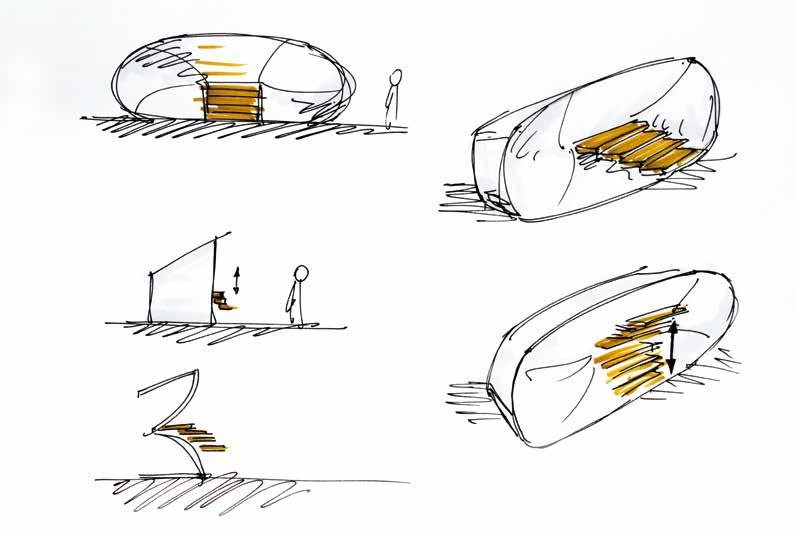
our future to be”.
And when we look at the technological and design progress achieved by Besenzoni it’s clear the company is ready to step out its comfort zone, the yacht-building sector. As Giogio Besenzoni, CEO of Besenzoni, says, “We like the idea of creating a bridge between our world and those with special requirements in the civil or design sectors – equipment or sophisticated systems that we’re used to dealing with in yachts can find applications in residences or hotels, and we’re ready to open ourselves to a new clientele and bring our expertise to bear in those sectors, too”. www.besenzoni.it
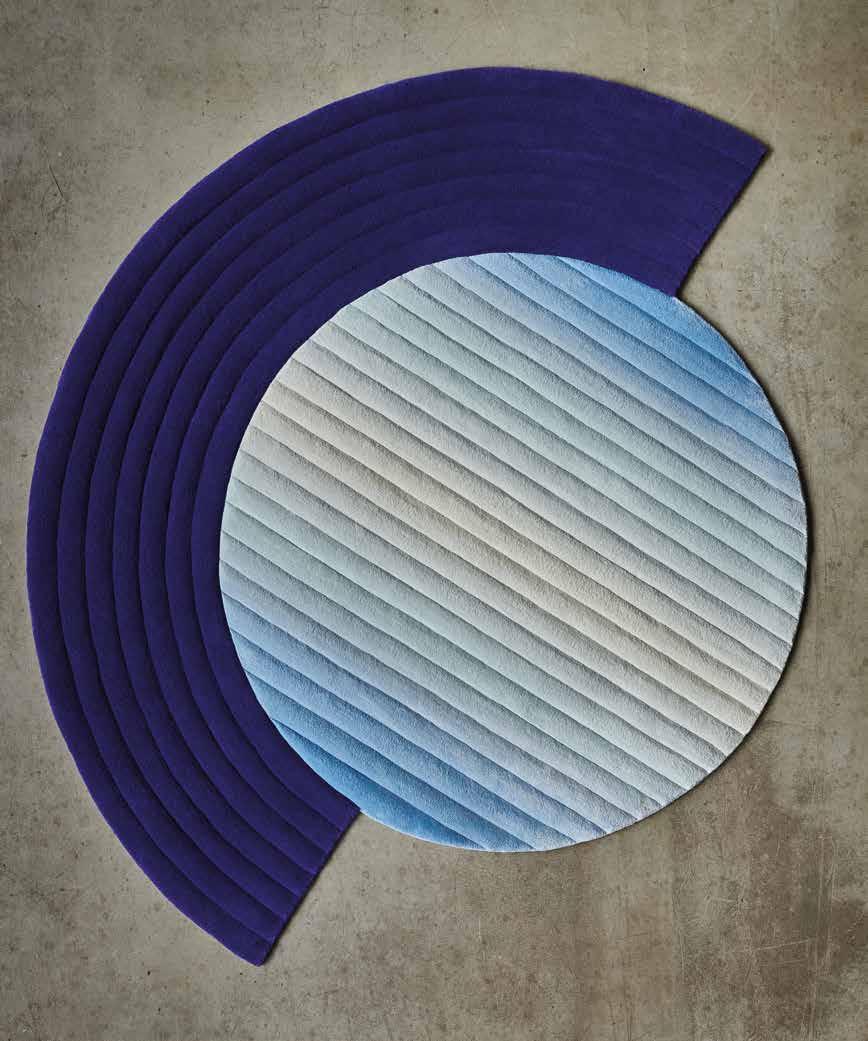

Innovation and research, technology and art – that’s the mantra of Luxury Carpet, a company dedicated to making prestigious rugs and carpets that reflect an intense commitment to excellence. Based in Italy’s Brianza district, this year its new collections showcase a range of vivid, daring colours inspired by style of the 1980s. After enjoying great success and robust growth in 2022, for 2023 CEO Vincenzo Solenne is aiming to consolidate these trends with a set of new objectives that are not only financial. “They’re also ambitious in terms of our expertise. Challenges drive us to improve, seemingly impossible tasks make us stronger without ever compromising on our fundamental values – in other words quality, beauty, customisation opportunities and respect for the environment”. This time the challenge took the form of the Colorful Collection, a top-of-the-line collection made using select wool and silk yarns, natural and eco-sustainable. These versatile products are intended for a variety of niches the company operates in, from hospitality to the residential sector, megayachts over 40 metres in length and fashion retail. The constant search for new sources of inspiration led the highly-experienced Luxury Carpet team to extend its creative horizons and draw from areas that at first glance may seem very different. This time the input came from the spring/summer runway shows in London
and New York. “I was looking for a strong, cutting-edge inspiration that could meet our CEO’s expectations”, says Elisabetta Santoro, a designer who works with the company’s style centre. “After a lot of thought I realised that I’d find what I was looking for in the fashion world. At the most recent runway shows I’d attended the scene was dominated by the kind of colours that were popular in the 1980s but also had a contemporary resonance – fuchsia, yellow, intense shades of blue, magenta and delicate pink and peach”. A palette of high-energy colours enhanced by abstract and geometric graphic patterns, another legacy from that period of explosive creativity, reinterpreted and revisited for the Luxury Carpet Studio products. Arrows, circles, triangles and intersecting lines create three-dimensional effects accentuated by sometimes fading colours, produced using a special embossing technique. The result is a striking collection that enables almost countless co-ordinations and solutions for practical and decorative purposes, with pieces adapted for both floor and walls. “It was a tough challenge but the total commitment shown by our team means we’ve come through with flying colours, so to speak, from Elisabetta Santoro’s sketches to technical production, gradually reaching the marketing stage”, says CEO Vincenzo Solenne.
www.luxurycarpet.it
The new Colorful Collection from Luxury Carpet is inspired by the vivid colours of the fabulous 1980s. A top-of-the-line collection made using select wool and silk yarns, natural and eco-sustainable


How did the brand come into being and how long has it been in existence?
The brand was launched in Italy in 2012, so it has Italian roots but a strong international outlook. We’ve opened branches outside Italy, in Hong Kong and Dubai. We also plan to open in London and Malta during the next two years. Our Design Studio is based in Seregno, Italy, and it’s here that that the collections for the whole group are developed. Seregno is also home to the commercial management for the EMEA area (Europe, Middle East and Africa). The creative team is a cultural melting pot comprising professionals from all over the world, making our style centre unique in our sector. The specifications arriving from the creative team drive our production division to push the outside of the envelope and achieve new levels of expertise.
Who are the company’s main clients?
We partner the world’s most important shipyards, collaborating with them on forty to fifty projects per year. We work with some of the most famous yacht designers.
Luxury Carpet Studio really comes into its own in the yacht building industry, designing, developing and producing hand-made items to meet all decorative, functional and budgetary requirements. We always find the best way to satisfy owners. Finally, our client portfolio includes the great hospitality brands - Marriot, Sheraton, Bulgari and Hyatt. Luxury Carpet Studio operates in the high fashion world. For the past ten years we’ve been working with the main international groups. Every year we supply around 300 shops for new openings and restructuring projects.
What’s different about this collection?
Colorful Collection is a perfect combination of technology, colour and art. It’s the new decorative cutting edge for carpets.

What is the embossing technique?

It’s a hand-production technique that enables us to make different carpet thicknesses on the same surface of the material.
Can you also produce rugs and carpets to the client’s design?
Yes, that’s Luxury Carpet Studio’s spirit and mission – to produce handmade rugs and carpets to our clients’ designs. We can make any colour, pattern, shape, size and look.
The Colorful Collection features geometric decorative motifs. An embossing technique achieved by hand makes it possible to create various thicknesses on the surface of the carpet material, creating a three-dimensional effect. Arrows, circles, triangles and intersecting lines create threedimensional effects accentuated by sometimes fading colours, produced using a special embossing technique. The result is a striking collection that enables almost countless co-ordinations and solutions for practical and decorative purposes, with pieces adapted for both floor and walls
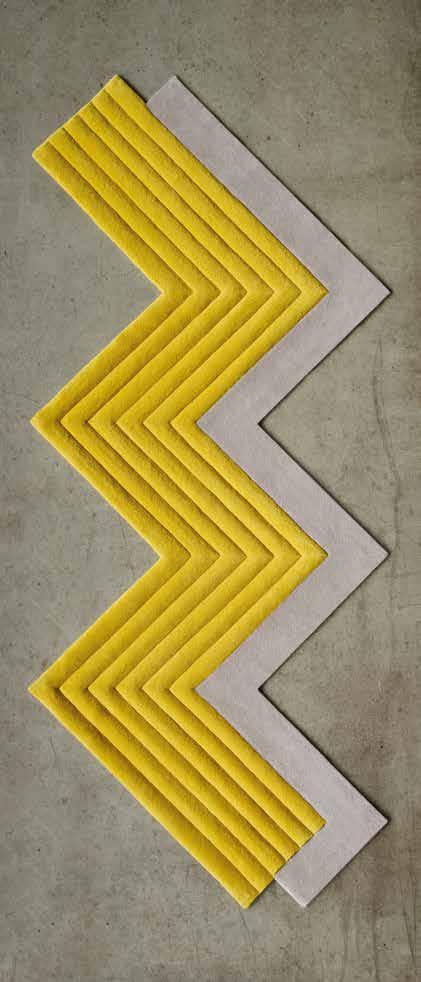



Sea0Spot (above) is the first unit on the market to combine the functions of desalinator, softener and nano-filter in a single unit. To side, Raymarine’s new Axiom 2 multifunction display with the HP Watermakers icon on the Home screen Courtesy by Raymarine

Flexible, far-sighted and always welcoming innovations, HP Watermakers designs, builds and distributes on-board water treatment systems. Its new developments are always game changers. The latest is Sea0spot, a combination desalinator and softener

The HP Watermakers story is that of a small but extremely smart company whose ideas have revolutionised the desalinator market. The first automatic machines launched twenty years ago have been followed by a series of patents and innovations, and nowadays the company has a broad overall water management vision, offering solutions ranging from desalination to the glass of water on our tables.


Extension work has recently been finished on the company’s main facility in Zibido San Giacomo, a few kilometres from Milan, doubling its area. The sales and assistance network is also enjoying constant growth – in 2022 HP Watermakers opened a flagship warehouse and shop in Fort Lauderdale, with shops already operating in Dubai, the Maldives and South Africa. HP Watermakers has always seen innovation as a top priority. “We’ve always been closely linked to technological innovation. For us, quality and innovation are fundamental elements in our work, we constantly try to look at least ten years ahead. For a small, flexible concern like ours you work like that or you get nowhere at all”, says Gianni Zucco, co-founder of HP Watermakers. The latest product, launched in nearly 2023, is Sea0spot, a first for the market – a single unit that functions as desalinator, softener and nano-filtration unit. “Because of the problems linked to managing water systems” says
Gianni Zucco, “More and more frequently the water from columns no longer has the same quality as mains water and can even be semi-saltwater. That’s why we decided to develop a smart, effective solution to the problem of poor quality water on the quayside and incorporate several functions into one unit”. Sea0Spot is a development of the HP Kilo, an innovative 220V desalinator launched in late 2022. Consuming only 1 kWh it can provide constant production of 120 litres of fresh water per hour. This compact, low-consumption unit is designed for medium-small yachts.
A further source of pride for Gianni Zucco is the partnership with Raymarine, a partnership that’s now resulted in the recently-launched Axiom 2 PRO, the most powerful Axiom plotter ever developed by Raymarine. It incorporates a chartplotter, fishfinder, radar, autopilot and video in a powerful multifunctional display. A series of third-party apps interact with the system. “The choice of applications that HP Watermakers is part of”, says Michelle Hildyard, VP of Product Management and Business Development Raymarine, “was subject to a careful analysis to select the most useful, the ones that would make the greatest contribution to enhancing on-board life. That’s why we included the desalinators, and the choice fell on HP Watermakers, which was also the first company to develop a communications protocol compatible with our systems”. https://hpwatermaker.it

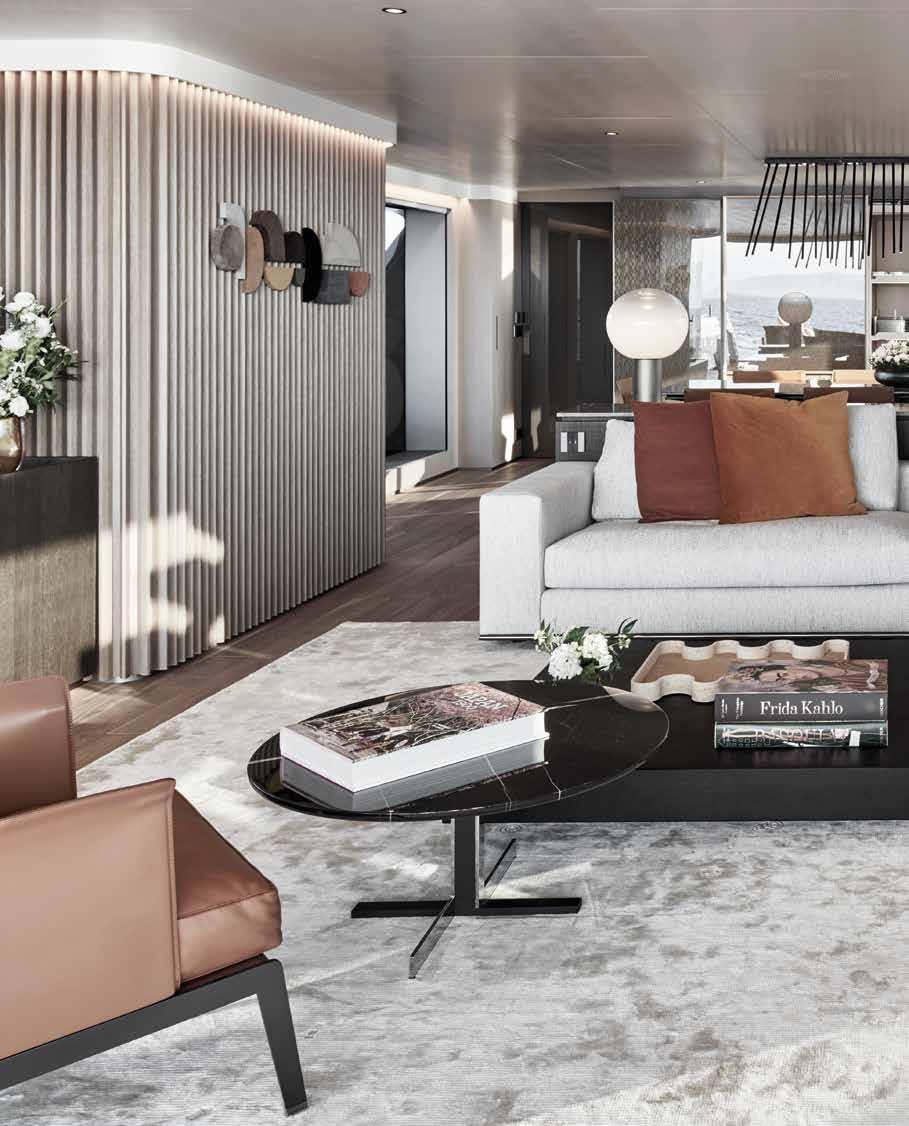
This aluminium build is the first 133’ in Baglietto’s DOM series. Designed by Stefano Vafiadis, it has sporty, articulated lines and warm, welcoming interiors by Mexican architect Ezequiel Farca
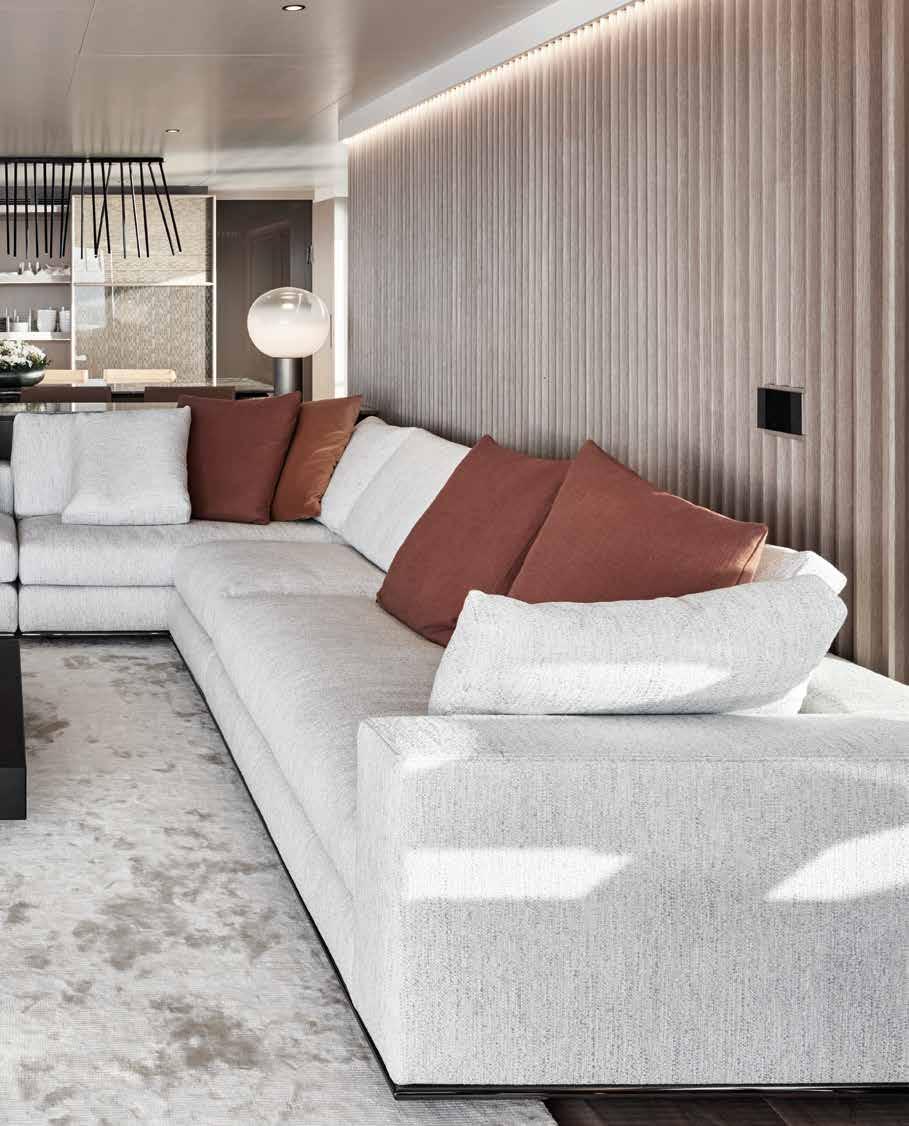 by Désirée Sormani - ph. Giuliano Sargentini and Leo Torri
by Désirée Sormani - ph. Giuliano Sargentini and Leo Torri

ttitude has a twofold character, with sporty lines contrasting with the interior warmth and comfort of a home away from home. Built in aluminium, Attitude is the first 133’ in Baglietto’s DOM Lines – the second model, in fact, after the DOM123 Run Away. The line looks set to be a roaring success and has already caught the attention of many potential owners.

With a length of 41 metres and an 8.70 metre beam, Attitude draws the eye with its complex, eye-catching profile. Its lines include an abundance of details and changing surfaces, with grilles that recall elements of car design. Elegant and comfortable, the DOM Lines, from the Latin word domus, “home”, has generous volumes that are unusual in a yacht of this size, complemented by extensive open-air spaces connected to the interiors. The concept is the brainchild of Stefano Vafiadis, and reflects the yard’s family feeling.
The interiors are by the American architecture and design studio Ezequiel Farca, which has shaped them around the requirements of the owner’s lifestyle - Attitude had to be able to host a family that intended to enjoy extended voyages. The result is a versatile yacht that combines elegance and functionality, comfort, practicality and style. The on-board spaces are functional, with many settings for convivial moments. The woods and other materials are chosen to emphasise the continuity between interiors and exteriors, enhancing their unique nature. The feel of a domestic setting is also generated by the
selection of furniture items from the finest Italian brands like Minotti, Flexform, Poliform, Baxter and Moroso, as well as the inclusion of perfectly integrated works of art. The designers adopted a holistic approach, and light, too, forms part of the on-board equilibrium – the bright saloon boasts a panoramic full-height window that opens to transform the space into a natural extension of the aft cockpit. It’s a warm, welcoming space in beige, brown and burnt orange with an extensive use of strongly-textured wood for the floors and oak walls, embellished by the work of Stephane Parmentier.
An imposing staircase with Edelman shagreen leather wall panels and personalised art works by Edith Beurskens links the three decks. Guest accommodation is on the lower deck, with two VIP and two twin cabins. The light-filled owner’s suite with large windows, office, walk-in closet, relaxation area and bathroom with central shower is on the main deck. It features light, relaxing colours for the carpets and walls with contrasting brown leather bedhead and dark flooring. The theme of an uninterrupted flow between interior and exterior spaces continues on the upper deck, where the sky lounge has a teak floor and central window that can be fully opened. However, the key element in Attitude’s design has to be the beach club, configured on two levels. The flush pool with moveable floor is a hallmark of the latest-generation Baglietto builds. It’s the perfect location for enjoying a direct contact with the sea.
www.baglietto.com

Lots of open-air spaces furnished with pieces by Paola Lenti and Roda, resulting in generous al fresco lounges. These large terraces were designed in close correlation with the interiors, creating a single sweeping space. The yacht is a floating home, but the sportier aspects of its design are not hidden. The low draught of only 2.10 metres is an interesting feature, enabling the yacht to sail in shallow waters like those surrounding the Bahamas or Caribbean. Opening, the living area with Minotti sofa
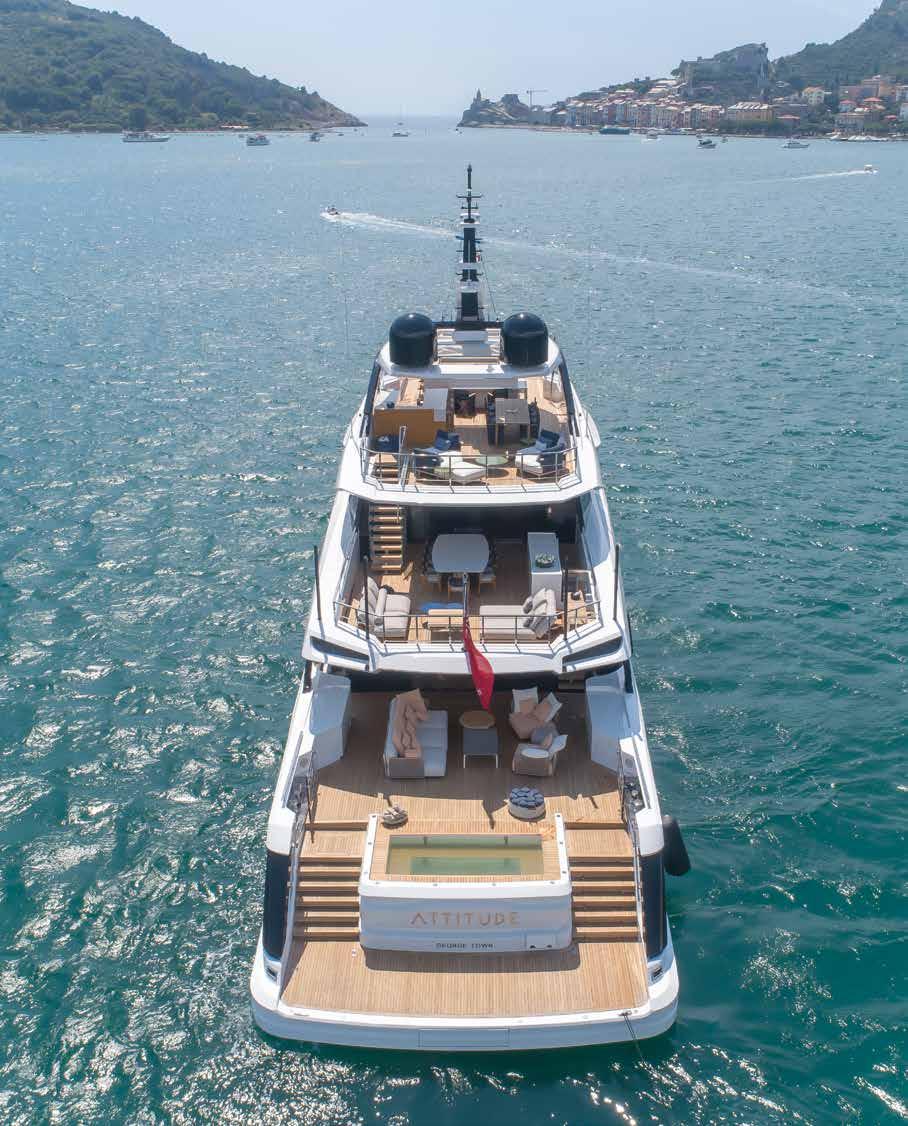


The living area (left, top) hosts a Minotti sofa and the Flexform (top right) leather armchairs are arranged to enable guests to enjoy the exterior view. Also by Minotti, the marble dining table for ten guests, lit by a bespoke ceiling light by Viabizzuno. Behind, the magnificent metal and glass screen by the artist Sophie adds a touch of elegance and creativity. Right and left, the owner’s suite

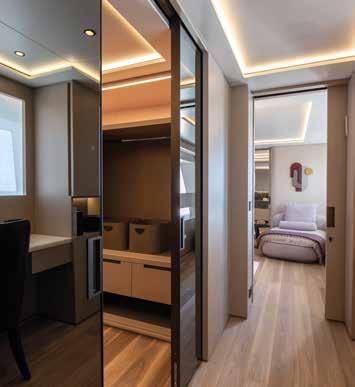


The DOM concept was inspired by the idea of having a floating “domus” on the sea, spacious and elegant yet also youthful and fresh, suitable for all owner profiles. The yard aimed for a comfortable but aesthetically-appealing yacht with the feel of a welcoming residence and attractive, universal lines. The interior spaces had to be generous, with optimal use of windows creating a constant dialogue between exteriors and interiors.
In this way I created a concept with taut exterior lines and extended gaps running along the sides, subtracting weight from the large volumes. There’s a mix of architecture and automotive design, meaning design in movement, something that emphasises the idea of the voyage. It wasn’t easy to harmonise sporty lines and large volumes – deconstructing the spaces by using horizontal vents has definitely helped to create sleeker lines and shape the volumes.
There are many elements that make DOM a unique yacht, especially the open stern. This modern, flexible space features a large pool whose floor rises and falls according to the intended use. The windows and air intakes are carefully designed using architectural tricks to minimise their visual impact, making the saloons airy and open to the outside, an effect increased by the fully opening rear window. The Baglietto yard is an icon of Italian yacht building, an expression of athleticism and timeless elegance. I sought to keep these values alive in the design and in the on-board functions without following fashion or deliberately looking for radical solutions. I’m very happy with this yacht and I’m especially pleased I didn’t make any compromises.
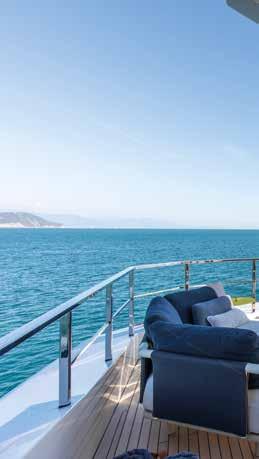

Elements of the yacht’s look draw inspiration from the automobile world, with many details borrowed from sports car design, like spoilers, air intakes, vents and flowing shapes evoking a sense of movement. Opposite page, all the sun deck elements are evidence of an almost sculptural approach - for example, the bar to port and the swimming pool bar with clean, minimalist lines are created with a play of geometric lines in wood and stone. On all three decks the outdoor spaces are designed as open-air lounges
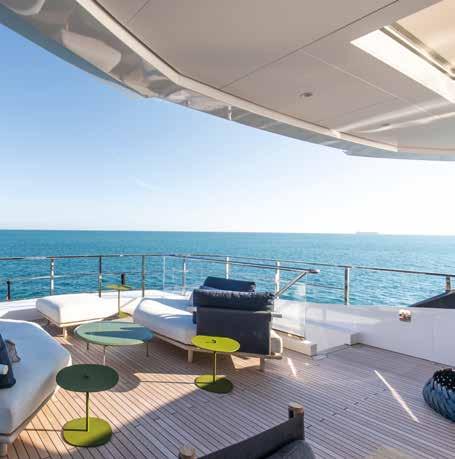


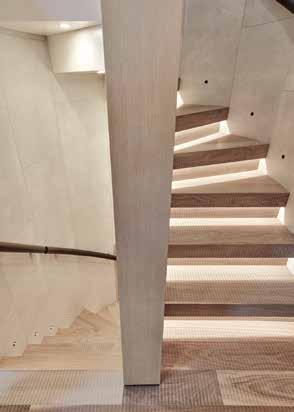

The colours throughout are warm and welcoming, and the textural fabrics and upholstery strike a balance between soft materials and hard surfaces. The bathrooms feature ivory onyx, Cote d’Azur, black Emperador and Orobico grey marble
The owner was intrigued by my studio portfolio: he had followed my work on previous boats and our residential projects. He wanted a second home, not a boat - he wanted to travel without limitations, on a technically sophisticated boat with unique construction and performance capabilities. So this was the perfect combination between our studio and Baglietto. The design brief was to accommodate his family of three in the most comfortable way possible in all the common areas. The integration of indoor and outdoor areas played a key role in the design. The intention was for the spaces to encourage family and friends to gather and mingle. We were totally in step from day one. Our approach is always to design from the inside to the outside, so comfort is our priority. I would define our design process as a holistic approach and a deep understanding of the client’s lifestyle. The proposed range of materials was complemented by a palette of warm, muted colours. For me this boat is really special - the integration between interiors and exteriors is seamless. What’s unique about this yacht is the amount of outdoor space dedicated to entertainment. Time was a challenge as we wanted to customize some areas structurally. Fortunately we made all these changes with the support of the Baglietto team. That was definitely the biggest challenge. Construction on the yacht began in the middle of the pandemic, and we immediately ran into a number of difficulties. To start with, the build was carried out a long way from our base, which meant we couldn’t visit the site as often as we would usually. Just as we would do for a villa, the wall art was selected with our design team with the intention of creating a look more like a home than anything else. For example, the salon’s full-height windows are framed with custom slatted oak wood with a Stephane Parmentier wall art piece. The central staircase wall panels are all in Edelman shagreen leather, with custom artwork by Edith Beurskens.



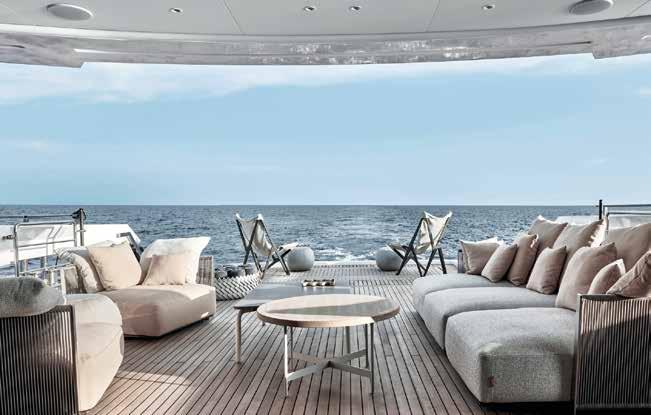

The DOM line was inspired by the idea of producing a yacht that could be lived and perceived as a home, a DOMUS, in fact. Its 41-metre length meant it would appeal to a large number of potential owners. The M/Y Attitude is the first DOM133, but we’re working on new developments that can provide a response to a wide spectrum of requirements. We’ve already sold eight, in fact! There are many successful elements, but what’s most appealing is the exceptional harmony and uniformity that links the exteriors to the interiors. Then there are the extraordinary spaces – the aft area with pool with lifting floor is another highly distinctive feature. The concept of the beach club on two levels sprang from a desire to provide guests with a versatile space, unlike beach clubs with opening transom that can’t be used when at berth. This once again shows the “atelier” character of our yard. The choice of aluminium, an extremely malleable material, for the build means that the level of customisation is almost total in both the interiors and exteriors. The hull was initially designed for performance, with the most powerful engines providing a top speed of around 20 knots, although in fact all our owners eventually opted for the displacement model. We’ll also be offering a hybrid power solution. The yacht is the first model with totally custom interiors, and was completed in only 24 months. The owner was totally satisfied, and immediately began using it privately for Mediterranean cruises. Our next challenge will be launching the first Baglietto with hybrid and hydrogen engines a few years from now.
Attitude’s complex, eye-catching design immediately attracts favourable attention. The hull is designed to provide excellent performance, with a top speed of around 20 knots. A hybrid power option is also under development


To celebrate the 50th anniversary of the car that enabled it dominate motorsport during the 1970s the Munich-based company has relaunched an iconic model once known as the “Batmobile”, the BMW 3.0 CSL
by Diego Tamone- ph. courtesy by BMW
With their yellow light, the Laser Light headlights are a specific reference to GT racing cars. They come on when high beam or dipped headlights are activated
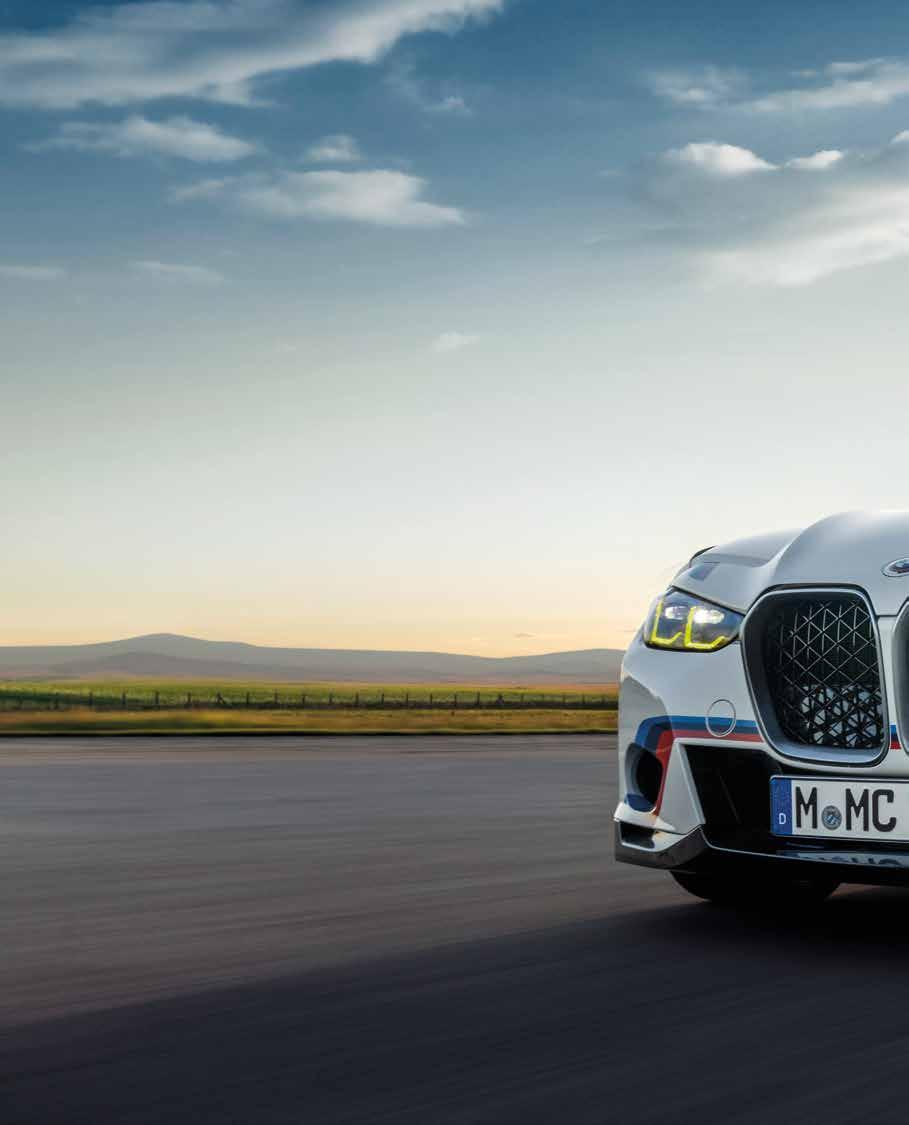
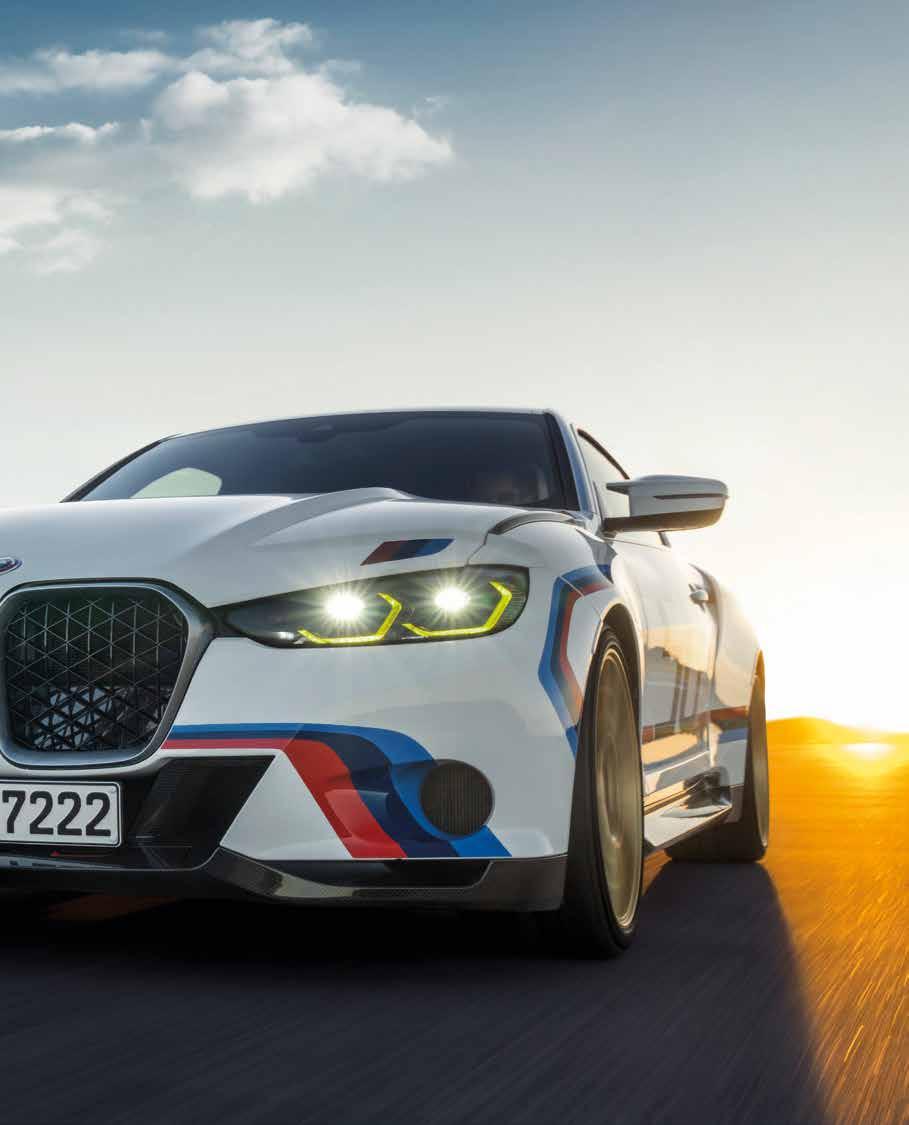

Front engine, manual transmission and rear-wheel drive – the enduring recipe for thrills and spectacle in touring car racing, enabling drivers to experience sheer driving pleasure while at the wheel of their everyday car. Although in recent times excellent electronic systems that have raised the bar for safety standards, they have also caused a levelling-out in drivers’ performance, making talent, flair and character less urgent priorities. The successful formula quoted at the beginning of this article was intensely fashionable in the 1970s, a golden decade of motorsport where instinct dominated, curves were taken with vicious slides and drivers received feedback from their cars through the seat rather than steering wheel. But above all it was a decade where all types of car were driven to provide the adrenaline rush of a motor race, not just open racers and sleek coupes but also unexpected saloons – three-box cars, in fact, like the BMW 3.0 CSL. The company began using this model in 1973 for the European Touring Car Championship, gaining a string of six victories between then and 1979. However, if the car was to be certified for track use, the regulations of the day demanded that it
must also be produced in a small run of road legal units. To fulfil this requirement, BMW manufactured a total of 1,265. The name reveals the strategy behind the initiative - CSL stands for Coupé, Sport, Leichtbau (“lightweight build”) - with no attempt made to conceal the purpose behind the car’s creation – to win. This fourwheeled object inspired its own cult, and today it’s a true collection piece, sold with the rear spoiler dismounted and stowed in the boot as it is not certified. Fifty years on 1973, BMW is celebrating this iconic car with a special edition of the new BMW 3.0 CSL, an authentic contemporary reincarnation of the legend. Even more exclusive than the original as only fifty numbered examples have been produced, intended this time only for road use. But it shares its forerunner’s artisanal construction, from the interior components in CFRP, its livery and assembly, handled by a team of specially-trained technicians. Carbon has replaced aluminium but the car’s essential character remains untouched – powerful yet stripped-down, no rear seats and insulating materials cut to a minimum. Aesthetic touches include widened wheel arches, a small roof spoiler and a large spoiler on the tail, the most significant

Three-box shape, exactly like the 1973 original. The number on the doors recalls the anniversary of the 3.0 CSL. Opposite page, a preliminary sketch by BMW’s creative studio

elements in an unambiguous aerodynamic package. Power is provided by a 3-litre, six-cylinder in-line engine that over the past fifty years has grown from 206 to 560 Cv and provides a maximum torque of 550 Nm. The whole package is rounded off with an Alpine White livery with blue, violet and red longitudinal bands, BMW’s trademark motor racing colour scheme. bmw.com

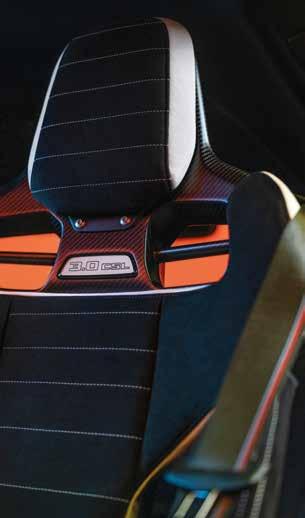
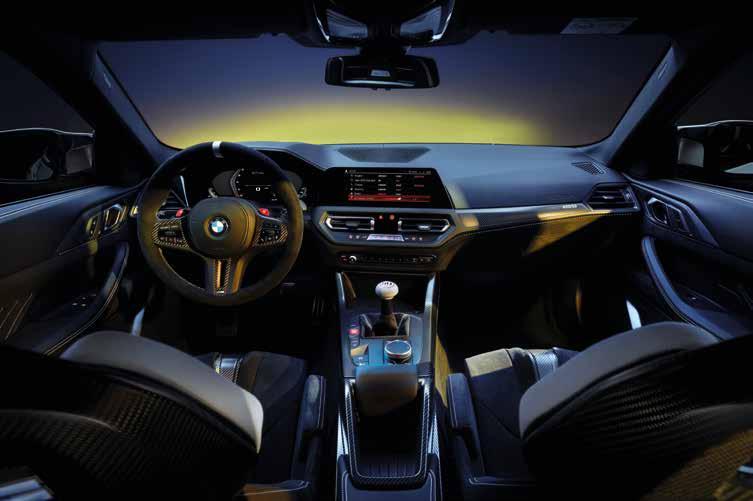

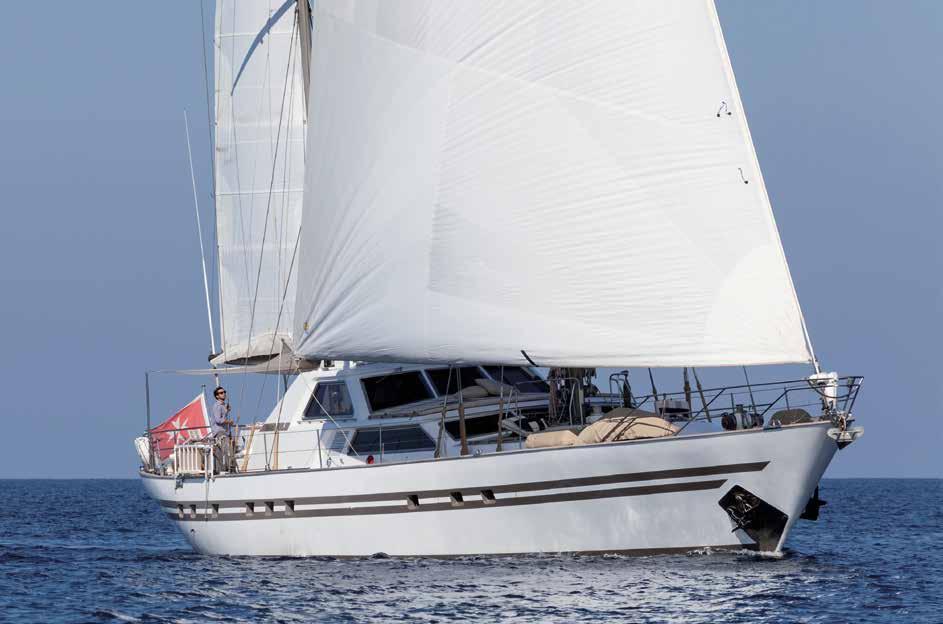




A move to the deserts of Saudi Arabia for Andy Warhol, with an exhibition featuring the legendary portraits of celebrities and Hollywood divas that helped the “Pope of Pop” become a counter-culture icon

Left, Andy
Founding Collection, Contribution The Andy Warhol Foundation for the Visual Arts, Inc. 1998.1.2900. To side, the entrance to the exhibition on the American artist in the Maraya Concert Hall, AlUla. Below, the exhbition with another selfportrait of the artist at 48 years of age (1976). Bottom, right, Screen Tests, Edie Sedgwick – Installation Photo. All rights reserved. Film still courtesy The Andy Warhol Museum)
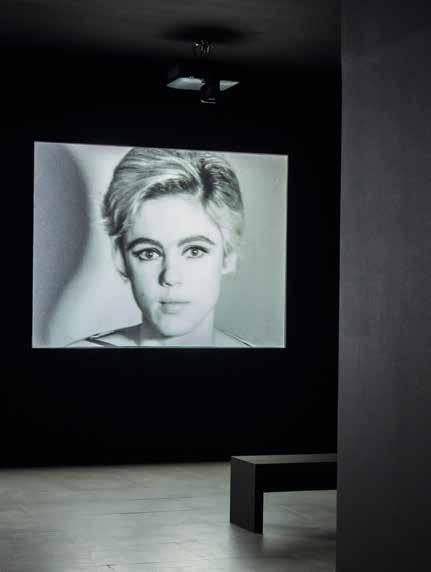
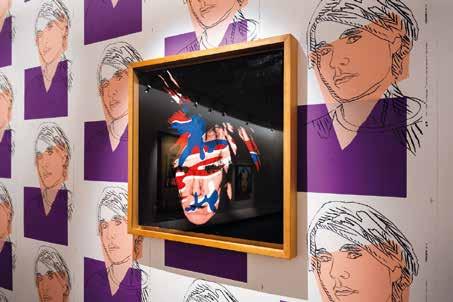
Andy Warhol (1928-1987) would take great pleasure in the reflections from the mirrored surfaces of the Maraya, a huge structure that rises like a mirage from the desert of AlUla in north-western Saudi Arabia. This unique auditorium by the Italian studio of Giò Forma, a setting for international festivals and events, is now hosting a retrospective dedicated to the legendary pop art icon (until 16th May). FAME: Andy Warhol in AlUla showcases the American artist for the first time in Saudi Arabia with works from the Andy Warhol Museum in Pittsburgh, the native city of an artist

who changed the way we see and perceive contemporary society. On show is an extensive collection of paintings, films and rare archive material with a focus on Hollywood celebrities, a central theme in Warhol’s work and one he first become fascinated by when a young man in Pittsburgh. “I thought this was the best way to introduce the artist in a country with a totally different culture, where most visitors will not be familiar with his work”, says Patrick Moore, curator of the exhibition and director of the Pittsburgh museum. The catalogue of works on show includes portraits of Elizabeth Taylor, Jackie Kennedy (depicted before JFK’s assassination), the legendary boxer Cassius Clay (Muhammad Ali) and singer-songwriter Dolly Parton, legends who become stars of the Studio 54 scene and conversations published in “Interview” magazine, founded by Warhol in New York in 1949. Less well-known though, are thirteen of the so-called “Screen Tests”, three-minute portraits filmed in black and white of personalities, famous or otherwise, of the New York avantgarde. Warhol shot hundreds of these between 1964 and 1966 in the famous “Factory”. “Once he’d started filming, Warhol would move away and leave his subjects to stand alone in front of the camera, as if looking in a mirror”, says Patrick Moore. The “Silver Clouds” of 1966, floating helium-filled clouds made of metallic plastic, close the
display. The “Fame” retrospective is part of the Arts AlUla Festival on the theme of “Living in Colour”, embracing contemporary art, artist residencies, design and artisanal skills. In 2024 it’s the turn of land art, and the first site specific works by five artists will be installed in the valley of Wadi Alfann (Valley of the Arts). The initiative is supported by the Royal Commission for AlUla in the context of the “Kingdom of Saudia Arabia Vision 2030”, an economic, social and cultural development plan for the country. “We’re focussing on art and creativity to promote the region and enable people to enjoy cultural and emotional experiences”, says Nora Aldabal, the Royal Commission’s Executive Director of Arts and Creative Industries. The exhibition held at Maraya is not the only event dedicated to Warhol this year. The MAGA museum in Gallarate (in Italy), for example, is presenting an extensive anthology of 200 works embracing the entire range of Andy Warhol’s creative output. The financial success his work enjoys is reflected by the prices achieved at auction. A silk screen portrait of Queen Elizabeth II made in 1985 went under the hammer for 850,000 dollars at the Heffel auction house in November 2022 and last February three of Warhol’s works were sold at Phillips auction house for 44,100, 37,800 and 36,540 dollars (Jackie II of 1965, Cow of 1976 and Kyoto of 1956 respectively).

This page, clockwise, Judy Garland, ca. 1979 (The Andy Warhol Museum, Pittsburgh; Founding Collection, Contribution The Andy Warhol Foundation for the Visual Arts, Inc. 1998.1.554). Muhammad Ali, 1978 (The Andy Warhol Museum, Pittsburgh; Founding Collection, Contribution DIA Center for the Arts, 1997.1.18.4). Dolly Parton, 1985 (The Andy Warhol Museum, Pittsburgh; Founding Collection, Contribution The Andy Warhol Foundation for the Visual Arts, Inc. 1998.1.625). Princess Caroline of Monaco, 1983 (The Andy Warhol Museum, Pittsburgh; Founding Collection, Contribution The Andy Warhol Foundation for the Visual Arts, Inc. 1998.1.633.



Left-hand page, the Maraya Concert Hall, and auditorium panelled entirely with mirrors reflecting the surrounding landscape, from an idea by Florian Boje of the

The brand’s iconic pattern, a symbol of Italian fashion and creativity, now also appears on porcelain, bringing a light-hearted joie de vivre to the table
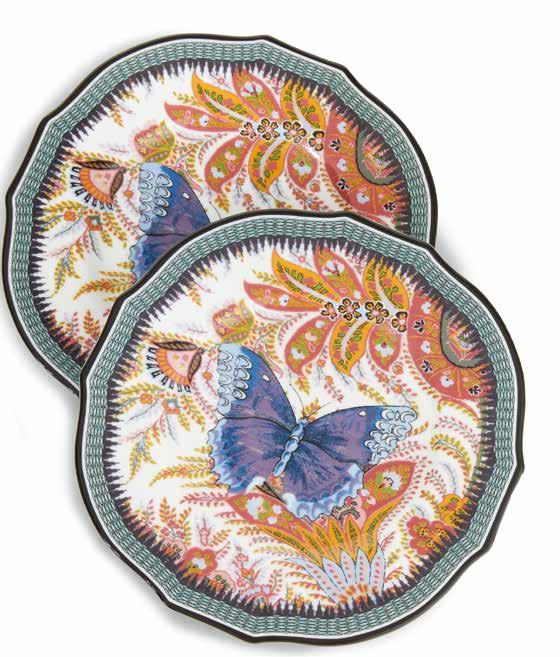 by Marta Bernasconi, ph. courtesy by Etro
by Marta Bernasconi, ph. courtesy by Etro

rints have always been the distinctive hallmark of Etro, founded as a textile company in Milan 1968. Introduced in 1981, the Paisley pattern became an iconic fashion motif, evolving through manifold interpretations and colour variations. Inspired by an ancient design typical of cashmere fabrics, the Paisley pattern created by Etro helped shape a fantastical world populated by constantly-evolving forms and colours, enhanced by experimentation and daring fusions. After giving a new, vital impulse to the men’s and women’s ready-to-wear collections, the brand’s creativity then extended to the home, with furnishing, accessory and fragrance lines, as well as a line specifically designed for the table.
The Boho Butterfly collection has been created in collaboration with Ginori 1735 and combines two elements of Made in Italy excellence – the brand’s spectacular creativity and the porcelain factory’s superb manufacturing quality. The tableware line features a sumptuous offer of objects for the heart of the home’s social interaction, including plates, dishes and coffee sets, complemented by printed cotton runners and napkins.
The world of Etro tableware reinterprets the brand’s distinctive motifs and colours with new compositions and renewed creative flair. Here, the Paisley pattern blends designs that are stylised yet rich in detail, reproducing botanical elements and other motifs inspired by nature. As the collection’s title suggests, butterflies are an important presence in the designs, fluttering across the patterns in an



From fashion to the home to table. The Etro lifestyle now embraces a complete range of tableware, too, with an offer including porcelain plates, runners, coffee cups and valet trays. Etro’s vivid, imagination-fuelled world takes in the full gamut of tableware items

Boho Butterfly is the name of the tableware collection created by Etro and Ginori 1735. The elegance and colours of butterflies are one of the main decorative themes. The only constraint to their flight is the edge of the plate, where Etro’s creative flair has created coloured borders with refined multicolour graphics


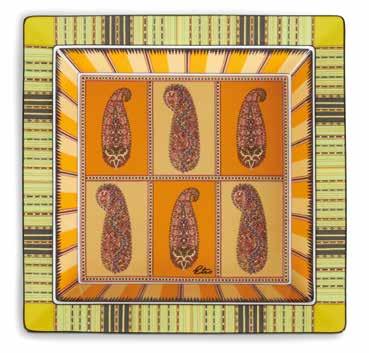
inquisitive search for exotic scenes and imaginary gardens. The butterflies appear against colourful backgrounds of full, decisive colours, showing that imagination makes everything possible. Alongside the detailed stylisation of flowers, leaves and multi-coloured butterflies, the famous Paisley pattern here forms part of a new creative journey, depicted not on the pages of a journal but through precious, fascinating designs on porcelain. www.etro.com



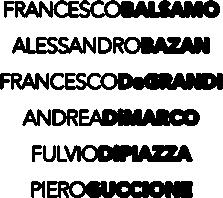
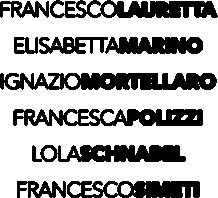



Remove and simplify. Designing with awareness and an emphasis on removal, in a context where essentiality is the single stylistic key, beyond trends and fashion. Respecting the object’s environment to re-establish the deep, ancestral connection with nature that generates a sense of total well-being
 by Désirée Sormani - Ph. courtesy by Matteo Thun & Partners
by Désirée Sormani - Ph. courtesy by Matteo Thun & Partners
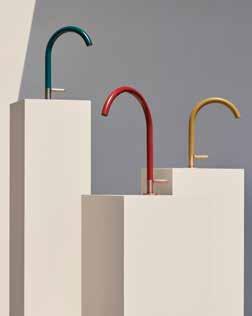
Reducing the work of Matteo Thun Antonio Rodriguez to a single statement is almost simplistic, because everything the studio creates, whether it’s a knife, tap, mountain chalet, clinic, master plan or even a yacht, is the sum of a series of interconnected concepts that aim to generate well-being, a sensation rooted deep in our ancestral connection to nature. This is the theme underpinning all their creations, dictating equilibriums, perceptions, transparencies,
senses and tactile sensations. The most intense expression of this idea is essentaility. “Removing and simplifying –that’s our task”, say architects Matteo Thun and Antonio Rodriguez, the founders of the multicutural architect and design studio based in Milan and Munich. “The real meaning is subtraction. We always seek to eliminate, never adding. Reducing means technical and aesthetic durability. The result is a silent luxury. That doesn’t mean ripping out the heart of
Matteo Thun, left, moved to Milan, and here in 1978 he started work in the Ettore Sottsass studio. In 1981 he became one of the founders of the Memphis Group. In 1984 he founded his own studio in Milan. His projects included developing prototypes of energy-efficient houses. Right, Antonio Rodriguez. Born in Valencia, in 1993 he moved to Milan, worked with the Taipei Design Center, Studio Matsunaga and Ugolini Design and taught at Milan’s European Design Institute. The Matteo Thun Antonio Rodriguez company was launched in 2003

things, we’re not at all minimalist. For us luxury means having the time to be with friends or family in a beautiful space that makes you feel good, with the correct balance of light, not too strong, not too low”.
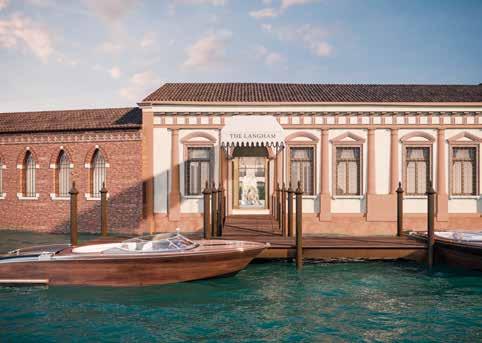

Matteo Thun, an internationally renowned architect, was among the founders in 1981 of the Memphis Group, the group of innovative design radicals led by Ettore Sottsass, whose members included Michele De Lucchi, Shiro Kuramata and Arata Isozaki, never betrays his link with nature. His roots are in Italy’s Alto Adige region (“I was born in

the mountains – but I also like swimming. When I’m by the sea I love enjoying the horizon”) so he’s perfectly aware what it means to live in symbiosis with what exists around us. This heritage has been a strong influence throughout his career. In 1984 he opened his own studio, and in 2001 he founded Matteo Thun + Partners and then Matteo Thun Antonio Rodriguez. He and the Spanish architect share the same values: “I arrived in the studio in 1999, becoming involved in product and interior design”, says Antonio Rodriguez, who studied in Valencia,

These pages, some examples of the variety of products created by the studio. Above, the infinity pool in the JW Marriot resort on a private island in Venice. Above, right, Brera and Botanica lamps for Strolz. Right, the Now for Zwilling knife collection. Below, The Bagno che non c’è “invisible” bathroom system for Rapsel, where the washbasin, shower and ‘hideaway’ WC almost disappear and become geometric modules that function as sculptural shelves composed of slats. Below, right, the Vigilius Mountain Resort. Opposite page, top, left, Faucet Collection, Venezia Special Edition for Fantini and Venini; right, Bar Campari in Vienna. Below, left, Langham Hotel in Venice; right, Eisenberg Waldkliniken

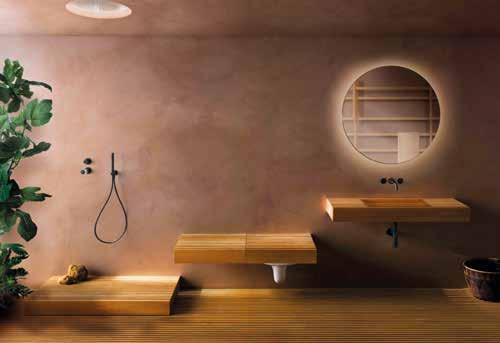
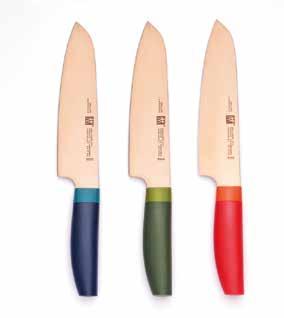

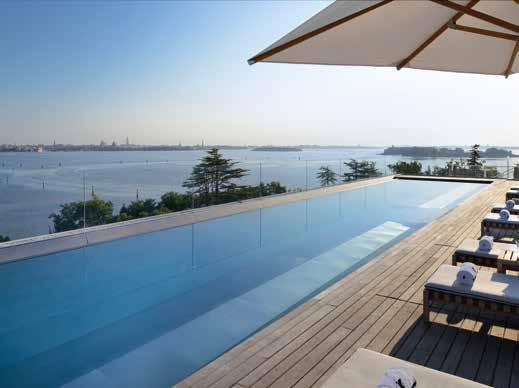
the city of his birth. “In 2001 we designed Isy, a series of taps for Zucchetti, and Thun wanted my name to be on the collection. In 2003 we decided to form a partnership. Now we have a number of companies, with various partners, involved in various aspects of design and architecture”. In short, “From spoon to city”. Each project has its own identity – the genius loci creates the architectural style. Building with the genius loci, respecting the soul of the place is what the studio does. That’s why structural transparencies are their hallmark, enabling nature to enter the spaces and become part of them. “The location is respected, we don’t want to cause pollution, we have to intervene silently. Feeling good doesn’t only mean functionality, it’s in our head, too. Glass lets natural light enter, and this means well-being, because it stimulates the production of serotonin, the feel-good hormone”, says Rodriguez. “We like wood, and it features in all our projects because we love natural materials, which become even more beautiful with the passage of time and have a textural solidity. Tactileness is very important to us. Matteo always says, “Touch with your eyes and see with your hands”. We use a lot of recycled materials, recyclable or natural. But these days “sustainability” is a much-abused term, we prefer to talk about Conscious Design”, says the Spanish architect. “You always have to be aware of where you want to go and what to do, with all the possible variations. We try to use as little materials as possible, and the materials we do use are locally sourced. When possible, for example, we reuse stone from building foundations in our architecture. That’s what we did for the Waldhotel, a clinic built
in Switzerland. We try to make architecture and objects that will endure, they shouldn’t be thrown away tomorrow just because the fashion has changed. If you design a clean, simple product then it will last. That, too, is Conscious Design”. Their mission is to design according to the Three Zeroes - Zero Kilometres, Zero CO2, Zero Waste. Zero kilometres means nearness of construction materials and local skills, Zero CO2 means energy management and lower emissions and Zero waste means lifecycle-management in the building process and the reuse of building materials.
All these principals have shaped the development of Seadeck, the new series of yachts by Azimut whose overall concept by yacht designer Alberto Mancini is based on a more conscious relationship with nature, protecting it and placing at the heart of the on-board experience. Matteo Thun and Antonio Rodriguez handled the interiors. “It was a new adventure for us, but also a straightforward one because it involves transposing what the studio offers on land to a marine environment. Our encounter with Azimut was inspired by the fact that we share some clear values – a desire to cut away, to allow the heart of the interiors to emerge, creating spaces where it’s easier to feel at ease. It’s a new interpretation of luxury, one developed in terms of wellbeing and a choice of natural or recycled materials. That’s the case with antique and Mediterranean cork, which can regenerate spontaneously, taking the place of teak.
“We, Azimut and Alberto Mancini are all very enthusiastic about the new Seadeck series and we’re ready to offer a truly conscious

In these pictures, renderings of the Seadeck series (Seadeck 6, above, the first of the three models, will be presented at the Düsseldorf Boat Show 2024; Seadeck 7, below and opposite). The interior design concept emphasises simplicity and well-being, a redefinition of luxury based on subtraction, “Because reducing means technical and aesthetic durability. A yacht should endure and be beautiful forever”. With a selection of a just a few natural or recycled
experience on the yachts. We had to do a great deal of research to find a solution that was at the same time contemporary, light and conscious, working exclusively with recycled, recyclable and natural materials”, says Matteo Thun, who had already worked in the yachtbuilding industry with the German shipyard Dehler on the creation of a fully custom 33-foot sail yacht. “That project was all about the
interiors of a very small yacht”, says Thun.



“With Azimut it is a completely different experience and we’ve introduced some new products”, adds Rodriguez, “like the carpet made from plastic recovered from the sea. It feels like wool.
We like to think that we’ve taken something ugly from the sea and given it a new shape and beauty”.

This Italian brand has come a long way since it launched in 1976. In fact, it is now one of the touchstone names on the Italian furniture and design scene. Cantori’s signature style has retained its distinctive character over the years, a character imbued by the fundamental role played by the highly skilled Italian artisans that make furniture that doesn’t just look good but is sublimely comfortable too. Equally, it has grown and expanded its sphere of operations so that its range now spans the entire domestic spectrum.
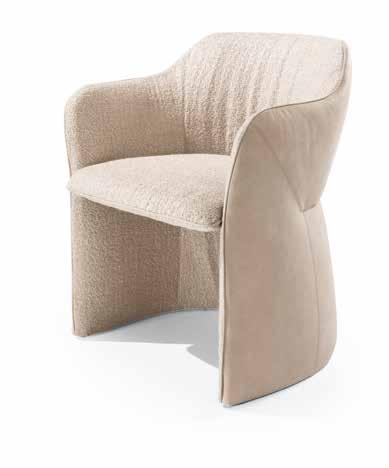
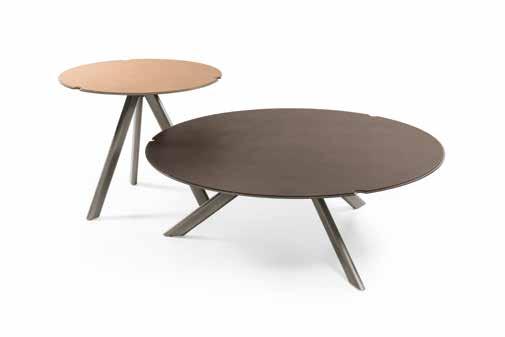
We asked marketing manager Federica Cantori what makes the brand’s style and inspirations so unique. What inspires the brand’s styling? All of which ties in with that artisanal vocation and the company’s very special ability to create highly customised interior projects. “Our main sources of inspiration are firstly the design work of the early Bauhaus and then also the local Marche area, which is rich in forms and combinations of materials. Our company is literally built on its craftspeople and so our strength lies in applying that same meticulous care to interior designs and bespoke design specifics. Personalisation has always been a powerful added value that enhances the perceived value of the furniture we create and makes it competitive in terms of luxury sector projects. There are other pluses too, such as the care that goes into our pre-sales and aftersales service”. In that regard, Cantori mentions a villa in Miami in which catalogue products were flanked by completely bespoke pieces, including a very large (420 x 170 cm) glass and metal table. Yachts too are an important market for the company. Cantori’s latest work can be seen aboard
by Marta Bernasconi - ph. courtesy by CantoriThe brand’s contemporary aesthetic is aimed an international public that appreciates the quality raw materials and attention to detail that only artisanal handcrafting can deliver. Here’s what Federica Cantori has to say about the company’s upcoming new productsLeft, the Valley cabinet and Karina table armchair, the latter also below in close-up. Above, the new Twiggy coffee table collection made from metal and leather. Available in two sizes
In Milan’s Salone del Mobile and Design Week, Cantori gives plenty of strong hints about the focus of its new collection which is ably represented by the Twiggy coffee tables designed by Luca Roccadadria. “Our new furniture products will fire up the five senses thanks to the use of natural, authentic, noble materials,” concludes a proud Cantori. Authentic materials that represent the company’s artisanal roots, an invaluable legacy it continues to nurture despite its burgeoning fortunes.
The Valley, left and above, with the Hong Kong bookshelf and Montecarlo coffee table which has two shelves and a steel structure with rounded corners. The sofa line has a strikingly unusual metallic band that supports and compliments the padded areas. All were designed by Maurizio Manzoni

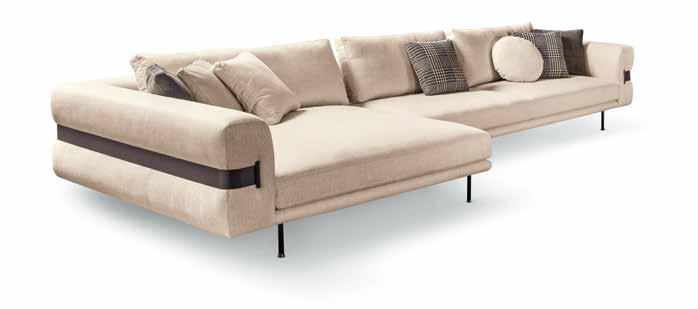

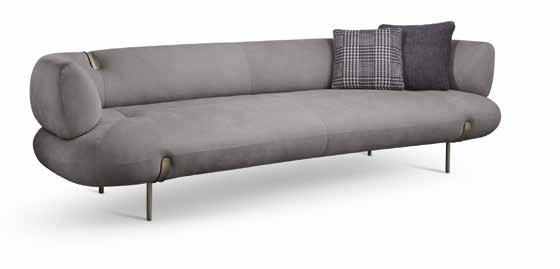


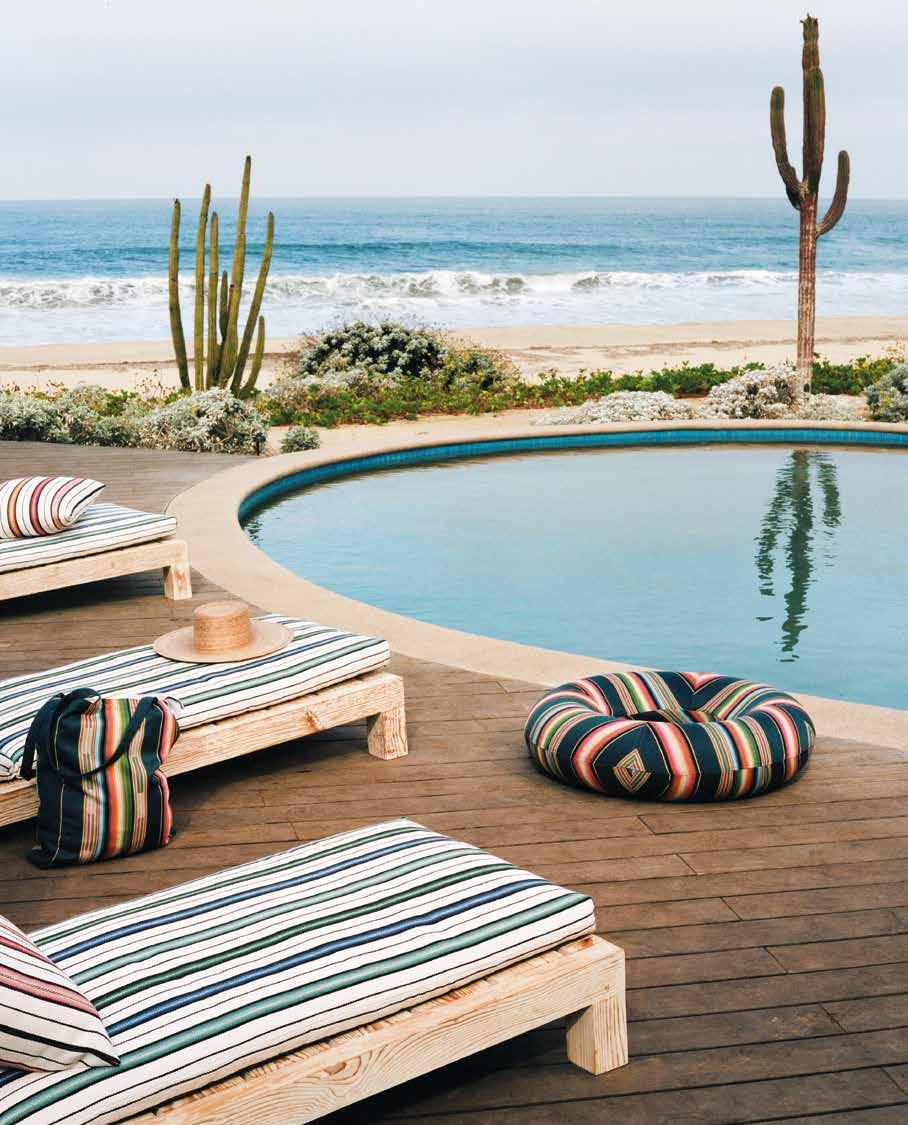
Born from an ingenious talent for curating interior and exterior collections of luxury furniture, fabrics and rugs, Perennials and Sutherland have become icons in the design industry. Ann Sutherland, Chief Creative Director of Perennials, reveals how both brands stand for longevity, timeless design, and consistent innovation
by Bryony Mc Cabe - ph. courtesy by Sutherland and PerennialsAll too often, interior designers are faced with a difficult choice between style and performance. As such, Perennials was born out of the need for luxurious performance fabrics in a space where only marine-grade textiles existed. After founding Sutherland Furniture in 1994, David Sutherland and his design partner John Hutton were at a loss when it came to sourcing performance fabrics with a soft touch in sophisticated hues. David convinced his wife Ann Sutherland to find a solution, and Perennials was born. As purveyors of outdoor furniture and yachting aficionados, David and Ann desired textiles that competed with interior fabrics in terms of comfort and style. As a result, Perennials’ 100% solution-dyed acrylic textiles blur the lines of indoor and outdoor design. “Yacht designers want and need products that are on par with the elegance and sophistication their clients expect,” explains Ann. “They also need products that can stand up to the elements of the seas. Sutherland and Perennials collections are created with materials that resist water damage, salt corrosion, spills from swells, you name it.”

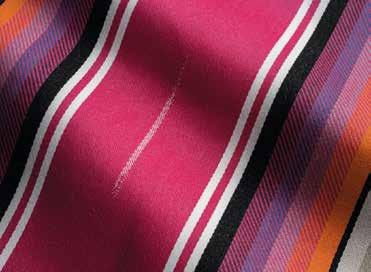
100% solution-
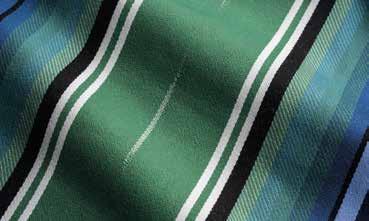
Perennials by Far West was informed by Liz Lambert’s love of Texas-meets-Baja craftsmanship (above with Ann Sutherland, right). With a history of working with artisans across Mexico, Lambert created a collection of vibrant stripes with strong textures. Five new fabric qualities – Serape Stripe, Tejas Stripe, Baja Stripe, Roadrunner Stripe, and Campo Stripe – feature a kaleidoscope of colour and texture.

When the Sutherlands recently refurbished their yacht, the 40m All Inn, it was no surprise that Perennials fabrics and rugs were featured heavily in the redesign. “We have Homespun, a gorgeous tweed-like quality, on our yacht,” adds Ann. “Blues are also a big seller on yachts, our velvets are popular for interior use, and our chenille fabrics like Soft Touch and Touchy Feely have an ultraluxurious feel that clients aim for. On the Sutherland side, popular collections for yachts include Peninsula, Classic, Poolside, the Neo-Classic Folding, and, of course, Mariner, a collection of 316 stainless steel furniture ideal for marine exposure.”
Constantly innovating and adding new collections, Perennials and Sutherland often collaborate with iconic yacht designers. Such

collections include Perennials by Bannenberg & Rowell, Oceana by Bannenberg & Rowell for Sutherland Furniture, and Plateau by Bonetti Kozerski, who designed a 40m Benetti yacht. The latest collection to be released is Perennials by Far West; inspired by hotelier Liz Lambert’s Baja bohemian aesthetic, it is characterised by a kaleidoscope of vibrant stripes with strong textures.
“The large-scale stripes with marine colour variations are particularly great for yachts – stripes are a classic in the yacht design industry, so this is a fresh look at stripes,” comments Ann. Collaborations allow Perennials and Sutherland to explore different aesthetics, and Perennials by Far West is a prime example.
www.perennialsandsutherland.com
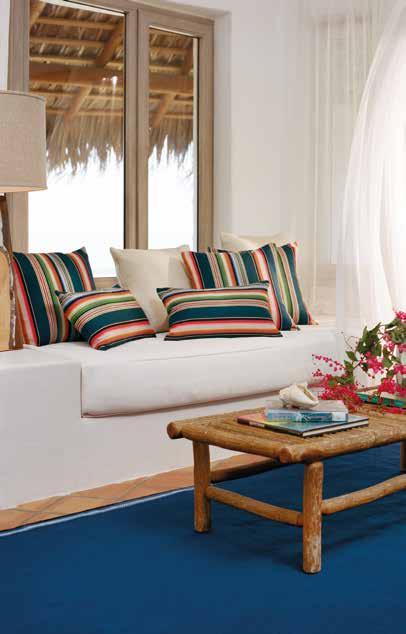






Sexy, powerful, greener – the first Southern Wind yacht with hybrid propulsion has flawless lines, contemporary interiors
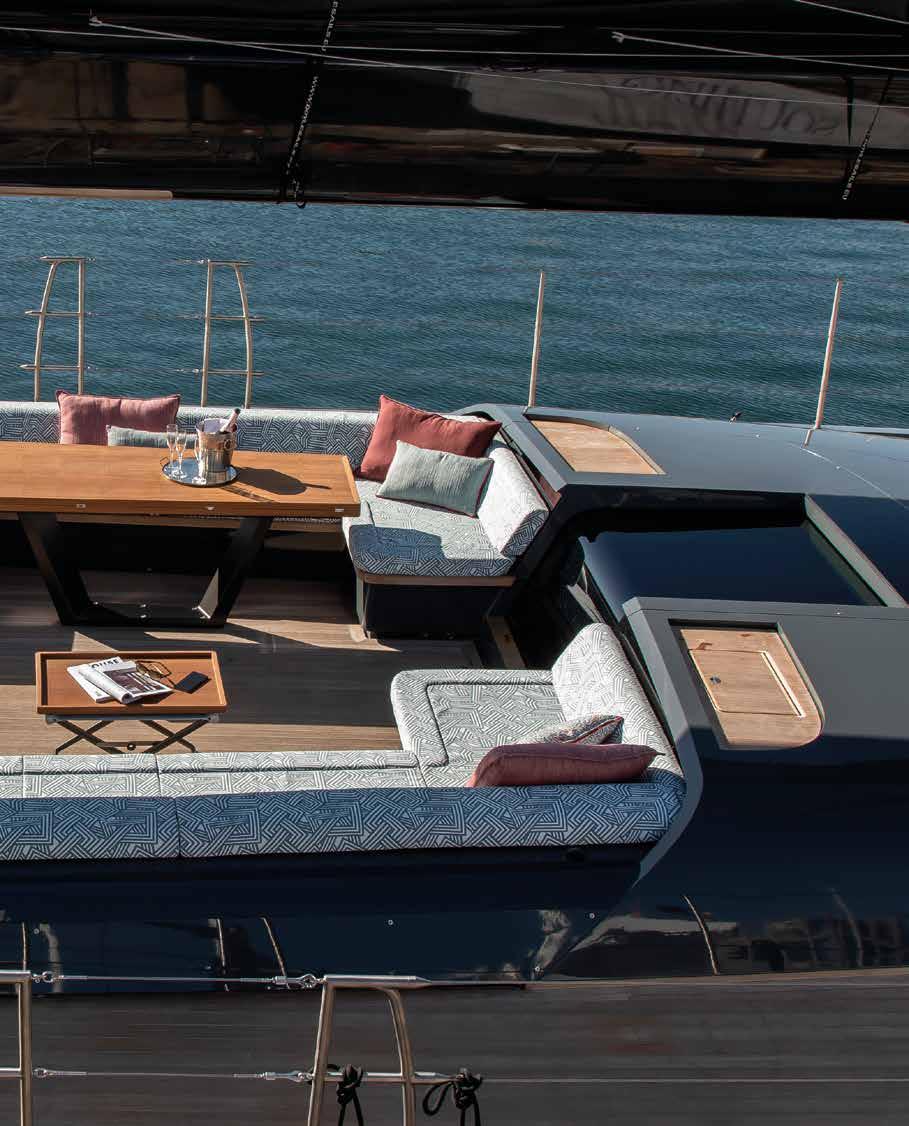 by Nauta Design and
by Nauta Design and
naval
architecture by Paola Bertelli - ph. Giuliano Sargentiniby
Farr Yacht Designyumba is the result of one of those lucky encounters between a passionate, expert owner who’s ready to raise the bar and dynamic, cutting-edge yard that’s eager to take on new challenges. Combining functionality, technology and efficiency, Nyumba is Southern Wind’s first yacht with a diesel electric hybrid propulsion system. The owner, an expert sail yachtsman and racer, approached Southern Wind with some very clear requirements – a yacht that’s sexy, comfortable, sustainable, reliable and above all innovative, to be used for sailing shorthanded around the world with his wife and family, and occasionally for racing when the fancy takes him. And finally, it had to have a green propulsion system.
As well as reflecting greater environmental awareness, the hybrid system developed by Southern Wind in collaboration with BAE Systems offers unprecedented on-board comfort, providing a totally silent cruising experience and greater range enabled by a hydrogenerator that recharges while the yacht is under sail. Nyumba, which means “home” in Swahili, is the fourth unit in the SW96 project. Farr Yacht Design penned the water lines of this high-performance craft, and Nauta Design developed the exteriors and interiors, displaying its unmistakeable refined, essential style.

It’s based on a versatile, tried-and-tested naval platform that can then be tailored to match the owner’s needs. Southern Wind calls this “smart custom”, and its aim is to take full advantage of a custom construction with its unique nature and innovation and the efficiency of a semi-production build. It differs in several crucial ways from its
sisters in the SW 96 family – the hybrid propulsion system and a total rethink of the main deck, new keel and rigging design and revamped interior layout.

The racy element that defines Nyumba’s elegant, dynamic profile is its low, compact coachroof with its soft, sleek shapes. In grey, like the hull and sails, it complements the warm colour of the deck teak. The owner wanted a spacious beach club in the stern, and Southern Wind has achieved this by opening out the transom and a section of the deck, creating a total of 8.5 square metres at water level. Behind it, the garage provides stowage space for a 4.5 metre tender.
Slightly lower than the deck, the guest cockpit with two deep, C-shaped deep sofas/sun loungers that seem to be suspended in the air is connected to the interior saloon by a large transparent companionway hatch. The below deck interiors are bright, contemporary and welcoming, displaying a coherent, harmonious style. Classic oiled teak surfaces co-ordinate with furnishing items and materials chosen by the owner, and the baseboard ropelights emphasise the floating effect. The saloon is raised higher than the other spaces, and natural light floods the interior through the transparent companionway hatch, hull windows and a coachroof skylight. It’s a versatile space with conversation/dining area to port and a daybed to starboard, as well as an office corner. A couple of steps provide access to an intimate TV and relaxation area forward, preceding a twin guest cabin and the owner’s cabin. Aft of the saloon lie a third cabin and crew quarters with independent access, comprising two cabins, galley and nav station. www.sws-yachts.com
A spectacular shot of Nyumba against the backdrop of Table Mountain Cape Town, South Africa. The 29.24-metre yacht has carbon fibre hull, deck and bulwarks, twin rudders and a lifting keel (3.4m-5.5m). The main deck’s clean, essential lines are created by a low, sleek coachroof. Opening, the cockpit prepared for guests with cushions and tables
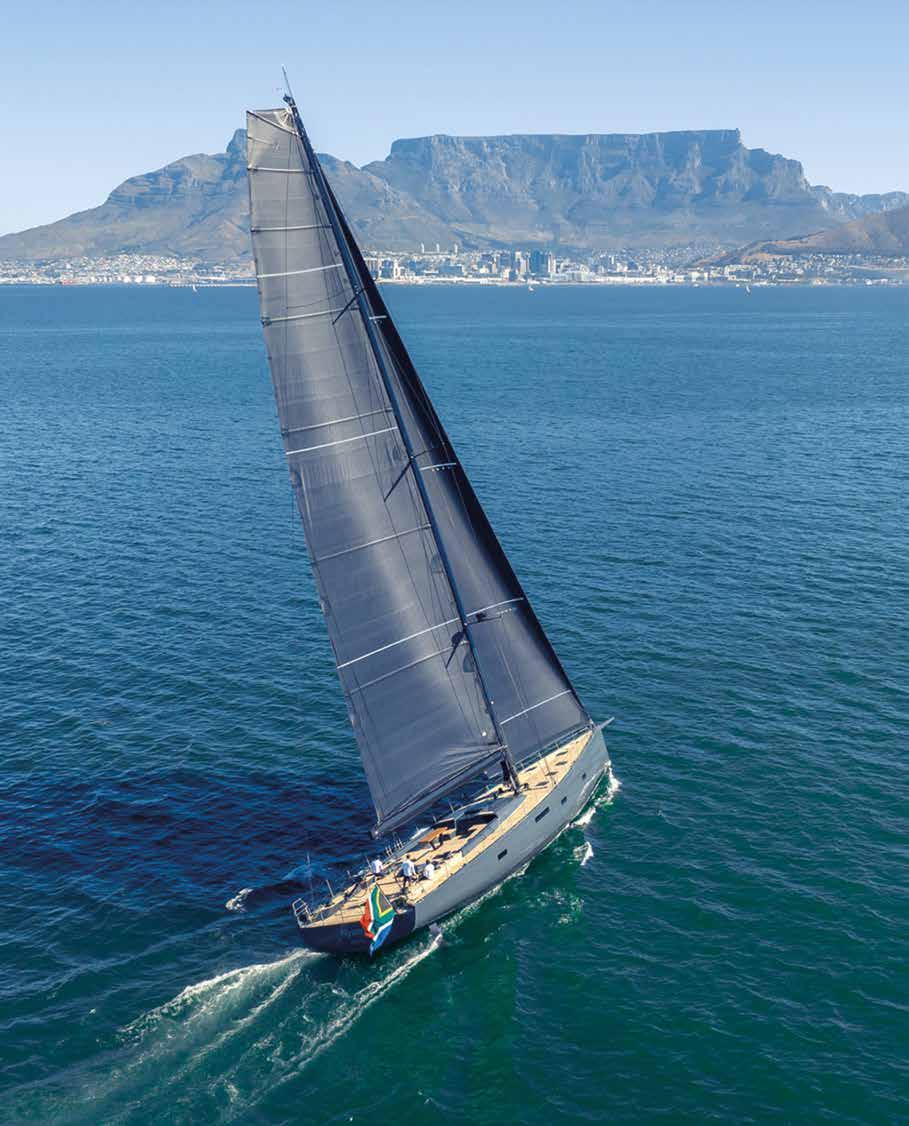
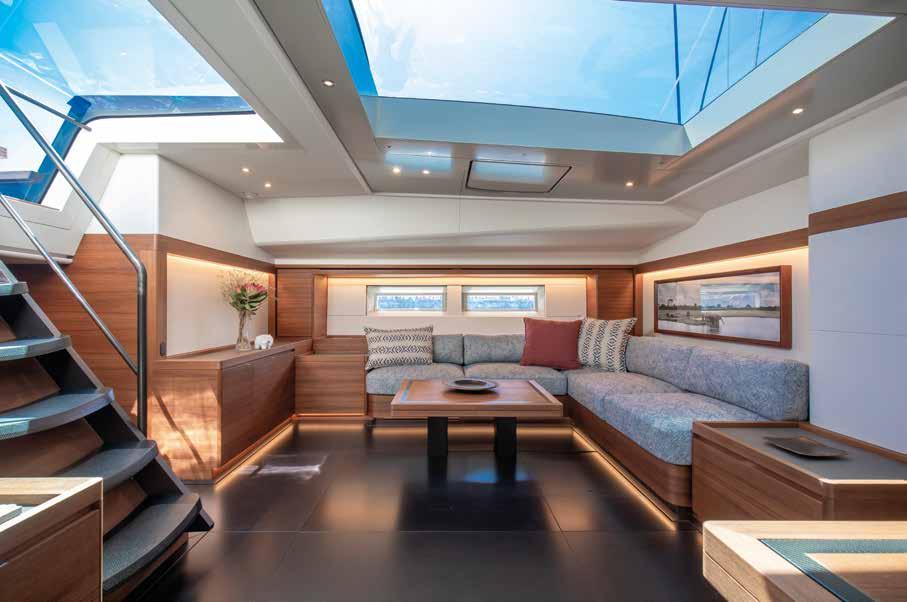

The relaxation/TV corner, and on the page opposite, above, the saloon with conversation/ dining area.. Classic oiled teak is the main surfacing material, the baseboard ropelights enhance the floating effect and the large windows, especially the coachroof skylight, balance the dark, elegant flooring. Below, the galley


Clear, uncluttered deck equipment positioning enables easy circulation on board and the GT styling lends the deck a breathtaking simplicity and lightness. Bottom, from right, the crew entrance echoes the coachroof lines; the design of the wheel supports is inspired by the shape of a propeller hub

Nyumba’s owner, an expert sail yachtsman, asked us to create a fast, efficient yacht for long-range short-handed sailing that could also make a good showing in superyacht regattas. This involved designing a yacht with a sleek, dynamic profile with an uncluttered deck and ergonomically positioned running rigging for greater ease of use, plus enhanced safety and comfort for guests. The main deck has been totally redesigned when compared to the other three SW96 models – its clean, elegant designs are an evolution of the GT deck concept we first developed on the SW105 GT Taniwha. The coachroof is an important design element we drew with an unobtrusive profile and sleek lines. To facilitate short-handed yacht-handling the three winches on each side are mounted on teak coamings that also serve as comfy benches close to the helm positions. The LED lighting below these creates a floating effect after nightfall. It’s important to emphasise that in order to make sail handling safer the aft deck is on a single level, with the guest cockpit a single step lower for greater protection. The owner asked us to reduce the aft sunpad area, adding space to the work area. This enabled us to put the mainsail traveller as far back as possible, on a level with the end of the boom, cutting load to a minimum. It’s now aft of the crew companionway, which is styled to look like a mini version of the coachroof. We’ve also designed new supports for the two helms, drawing inspiration from the shape of a propeller hub. Last but not least, the owner’s choice of dark grey for the hull and coachroof highlights the sophisticated simplicity of the exterior design. There is no cove or waterline stripe and even the antifouling paint is the same shade of grey as the hull. This deck is one of the cleanest and most balanced and sportiest we have ever designed.

Holistic, sporty and cosy – that’s how I like to describe Nyumba’s interior design. Our starting point for the project was the fact that the owners will spend a lot of time on board, so our objective was to create comfy, welcoming spaces. The owners played a very active role in shaping the overall style, choosing colours and materials from the range of options offered by Southern Wind. Among their selections are the classic oiled teak veneers and specially-made pieces of fitted furniture. We developed an extremely coherent interior design, which I would define as holistic: for instance, the soft materials chosen by the owner’s wife complement the interior design and styling provided by Nauta, and the relationship between exterior and interior is itself holistic, too. Nyumba’s concept is based on fixed dimensions for every room and space, because the structural
bulkheads and net spaces (the empty rooms, the empty cabins) are fixed. Inside those spaces we developed several different solutions both for the cabins and for the social areas like the saloon and the TV area. For instance, Nyumba’s owners asked for a special relaxation and working corner in the starboard part of the saloon, where we replaced the long L-shaped lounge sofa with two different areas where he can use a desk to work and she can relax reading a book in a deep, cosy daybed. The opposite area will mainly be used as guest lounge that can be transformed into a dining area. The most challenging aspect of this project is that the interiors feature dark flooring, which is very elegant but lowers interior light levels. We had to compensate by introducing extra natural light: we achieved this by adding a huge skylight in the saloon.
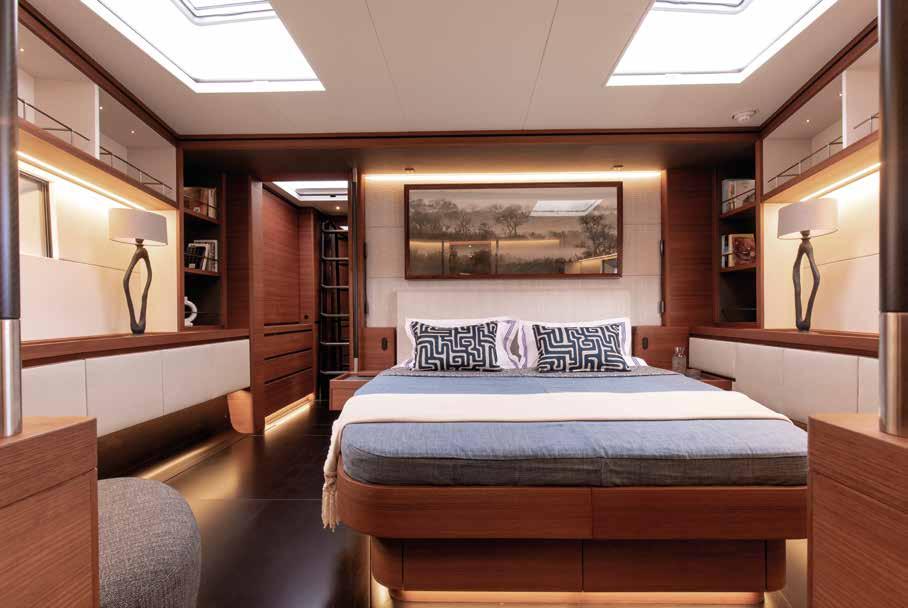

Nyumba is a major milestone for the shipyard, as she is the brand’s first yacht with a hybrid propulsion system. The owner is a keen, hands-on sailor – this is his third sail yacht but his first from Southern Wind. His design brief was very complex and ambitious, to put it mildly, and the opportunity to install an innovative hybrid solution played a pivotal role in his decision. Only a “smart custom” or a full custom could match his expectations. We discussed both options extensively: he favoured our “smart custom” approach to full custom construction. He wanted to reap the benefits of both the yard’s and the design
team’s experience while enjoying a smoother, well-structured decision process. Overall, Nyumba is a “smart custom” pushed to the boundaries of a full custom built within the time limits of a semi-custom. Learning about the design work we did with BAE Systems in developing the SW108 Hybrid sparked his enthusiasm - he wanted to be the first owner to have such a sophisticated system, and he wanted it to be developed for the SW96, too. We decided to build Nyumba to RINA Charter Class standards to enhance the redundancy we built into the system. Achieving this certification with a hybrid 96-foot sailing yacht is itself an
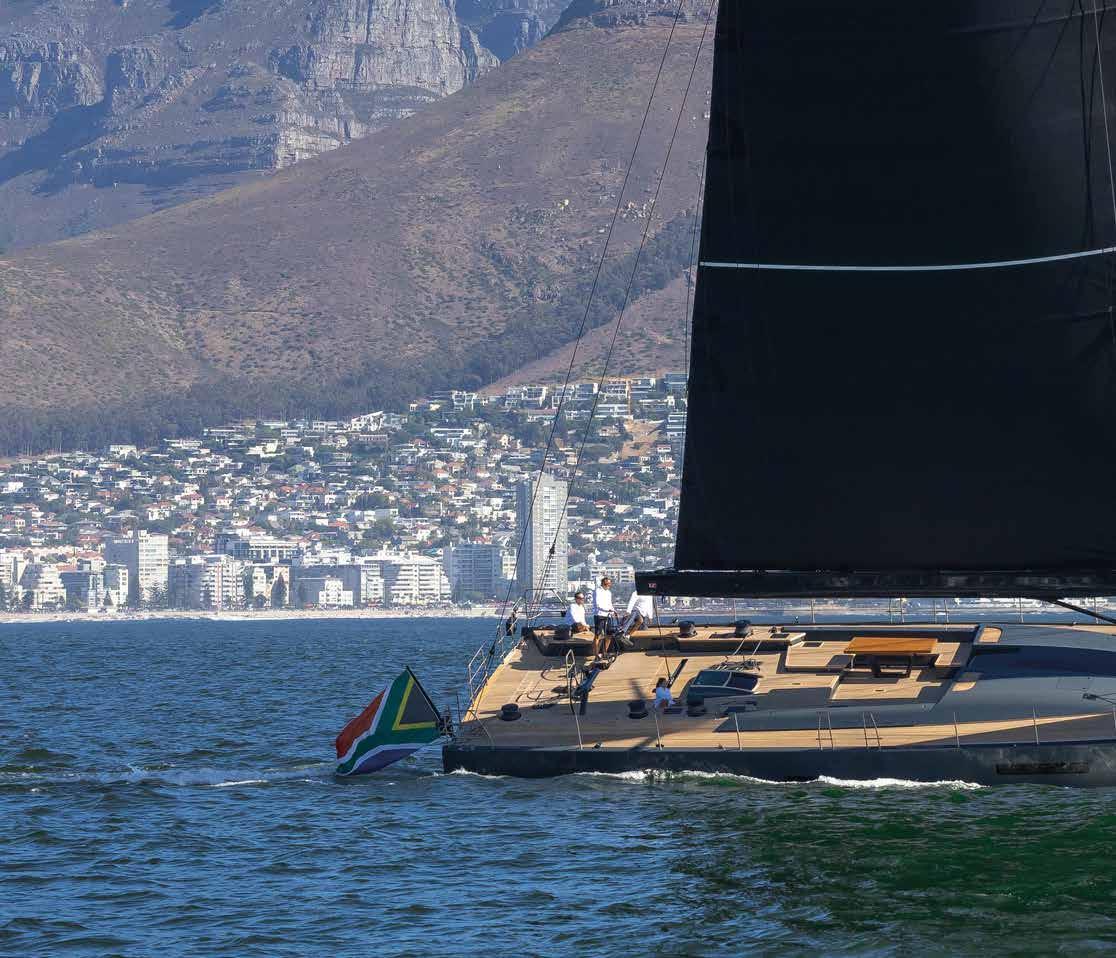
enormous achievement.
We had to completely redesign the engine room around the machinery and the cooling system required to handle the high voltage electrical components. We benefitted by not being the first in the sector to work on a similar project, but we take the credit for raising the bar for system performance, dimensions and weight. Although every electrical component from BAE is very sophisticated and compact, there are many more elements than would be found in a conventional engine room. Stringent safety requirements mean that every high voltage connection, cable and
cabinet is bigger than the comparable low-voltage equivalent. Sophisticated can-bus links integrate the systems, providing an unprecedented level of monitoring and control. We are proud to have achieved the objective of mounting these innovative systems without having to extend the engine room.
Nyumba is still a real sail yacht, a thrilling craft built for real sailors. At the helm she feels like a 60-footer and when you’re on deck or inside the yacht she feels like a superyacht, but her systems offer ground-breaking technical solutions typical of gigayachts.
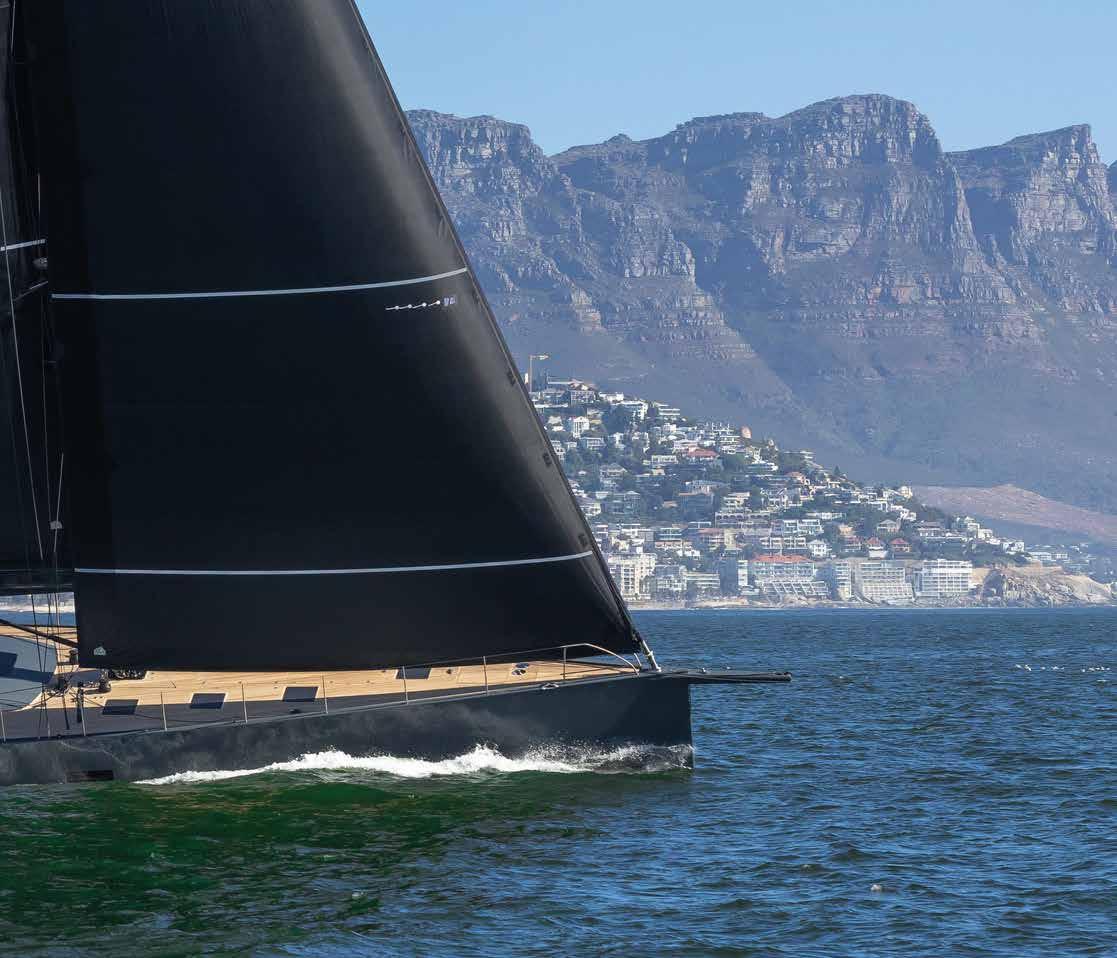

Contact with the water is high on the list of most owners’ requirements. Only a private sea-level beach makes it possible to enjoy a cruise to the full - this important feature has influenced yacht design since the early noughties and is now the main attraction in many new models
 by Désirée Sormani
by Désirée Sormani
The year 2007 saw the first appearance of a motor yacht that brought those on board closer to the sea despite its 81-metre length. The transom was open, a platform on the sea, and the yacht’s profile dropped gently down to the surface, providing guests with a direct contact with the marine environment. Not only did the designers eliminate the architectural barrier of the transom, they also broke the limitations imposed by a common preconception, the idea that to be safe while at under way a yacht must be an entirely closed unit. The yacht in question is Alfa Nero, built by Oceanco and designed by Nuvolari & Lenard. The stern was – is, in fact – an island furnished with loungers, bar and convivial corners. In the background was a large swimming pool, the base of which could be raised electrically to form a helipad when the pool was emptied. At the time most new design features were more the result of a search for the elusive “wow” factor than a desire to develop practical solutions. This was different, though, and transforming yacht design in terms of functionality was on the way to becoming established
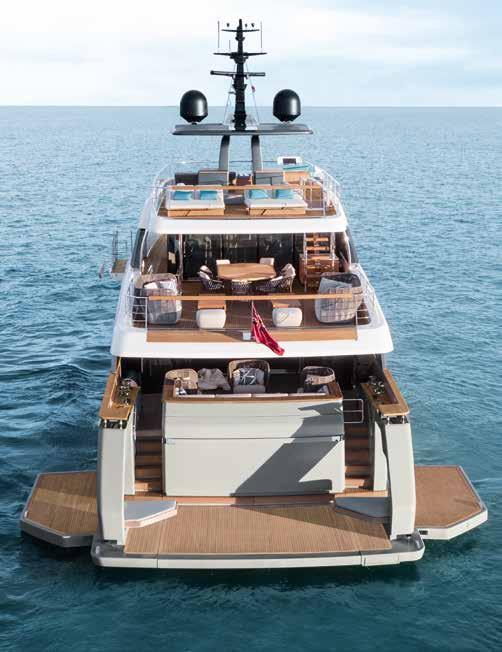
practice. In the first decade of the 21st century the first yachts began to appear that focussed on the contact with the elements and sought to erode the distance between guests and the sea. Designers also sought to reproduce the sail yacht experience on board motor cruisers. Research and development carried out by yacht-building yards, the new frontiers of engineering and the support of visionary owners enabled designers to give free rein to their creativity and transform dreams into reality. This was influenced in part by a changing sail yacht market where many owners were switching to motor yachts, and with them many designers who had previously specialised in sail yachts. This migration of designers meant that the motor yacht world now began to be influenced by new, interesting stylistic elements. Take, for example, Andrea Vallicelli, Sergio Cutolo, Nauta Design and Nuvolari Lenard, some of the many names who brought their sail experience to the motor cruiser market. In 2002 it was possible to obtain a glimpse of what has now become a fully-fledged trend with the launch of Isa 120, designed by Andrea Vallicelli, which sported a sea-level

These pictures, the Oasis 34M by Benetti presented at Cannes in 2022 and designed, like the first, the Oasis 40 metre, by RWD, introducing the Oasisdeck concept. Above, left, the Maiora30 Walkaround launched in 2021, created by the Next Yacht Group and its design team. Above left, Attitude Baglietto, designed by Stefano Vafiadis – the modern, flexible open stern features a large pool with lifting floor. Opposite page, from left, Sanlorenzo SD118 designed by Zuccon International Project. Acala, designed by Horacio Bozo for Cantiere delle Marche


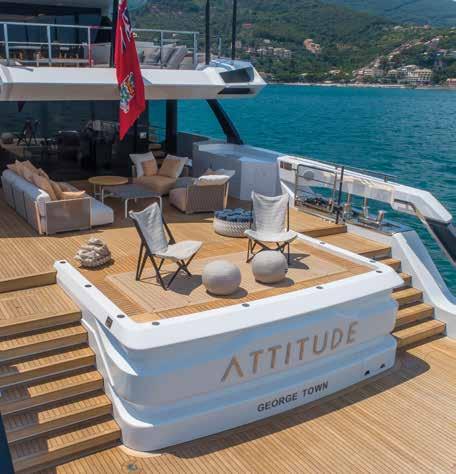
platform. “Created for water games and swimming, it’s easily accessed from the cockpit and sun deck down slightly sloping stairs”, writes the designer in his book “Vallicelli Yacht Design”, published by Skira. Vallicelli later emphasised on this descent to the sea on the 66-metre Okto, built by Isa Yachts in 2014. In 2008 Nauta Design also provided a foretaste of the current trend. “When we developed the 80 LIGHT patented concept we asked ourselves a question – what is real luxury?”, says Mario Pedol. “We’re sail yacht enthusiasts, so there could be no doubt – contact with the sea. And our new initiative started from there”. An interesting project in this context is the refit work carried out on the 51-metre motor cruiser Masquenada recently bought by Pier Luigi Loro Piana, a seasoned sail yachtsman, who specified the creation of an open beach club providing easy access to the sea and the main saloon. The stern bulwarks were cut out and the area was transformed into a sea level platform. The same feature, renamed “The IslandTM” by the studio, also appears in Feadship’s 72.60-metre Project 2024 and became reality in 2025 on Moonflower 72, under construction at the Wider shipyard. The engineer Sergio Cutolo brought his experience in integrated design with his Hydro Tec and his sail yacht expertise to the Explorer market, with outstanding results. “Nowadays all owners live the sea like this, and the aft deck where we used to stow the tender is becoming a space for relaxation and entertainment, like on the Aurelia, a 39.37-metre designed for Cantiere delle Marche
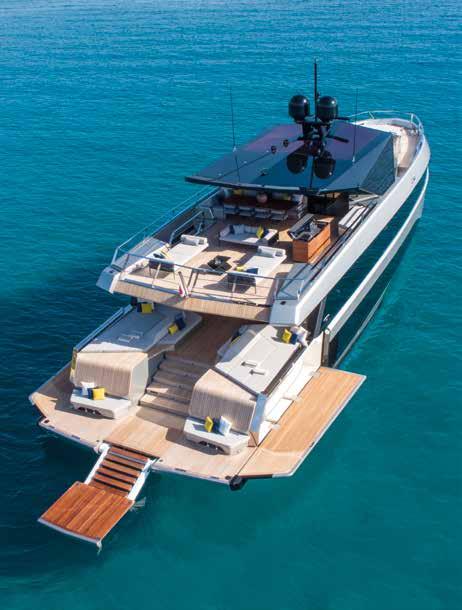
and launched in 2020. Then the pandemic upset everything, and owners now see their yacht as the safest island in the world”. Contact with the sea has become a top priority and there’s a greater awareness that this intimacy must be protected and preserved. In 2021 Benetti launched Oasis 40M, which has an extraordinary sea-level terrace that extends inside. Its exterior area can be doubled by folding out over the water surface taking the beach area’s total usable surface to 90 square metres with, of course, an infinity pool in the centre. “The guiding principle in developing the Oasis 40M centred around fostering an unforced symbiosis with nature. It was about designing a yacht that enabled guests to have an effortless, boundless connection with their surroundings while on board, leading to unique, unforgettable experiences,” explains Adrian Chisnell, RWD’s team principal.
This glamorous feature has even caught the eye of footballer Zlatan Ibrahimovic, who has been seduced by the tantalizing attractions of a safe island of his own with the purchase of a 34-metre Oasisdeck. Emboldened by this show of interest, Azimut recently launched Seadeck, the first seriesbuilt hybrid motoryacht to embody the idea of returning to nature through the use of technological solutions that cut emissions by 40% and the Fun Island, a reinvented stern area that embraces the sea in a new lifestyle based on family well-being. Choices driven by intensely practical considerations, not a desire to show off!
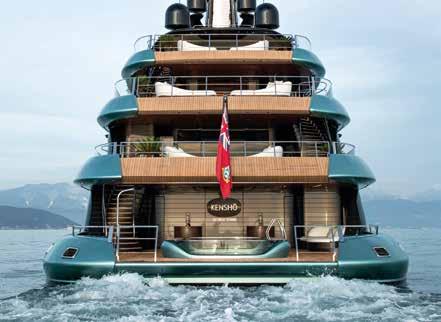

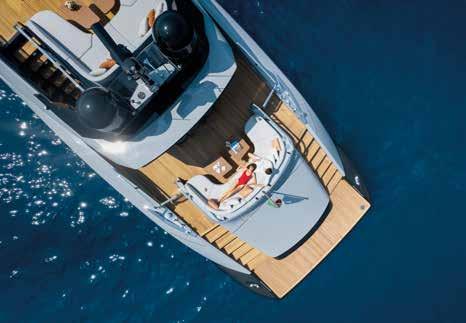
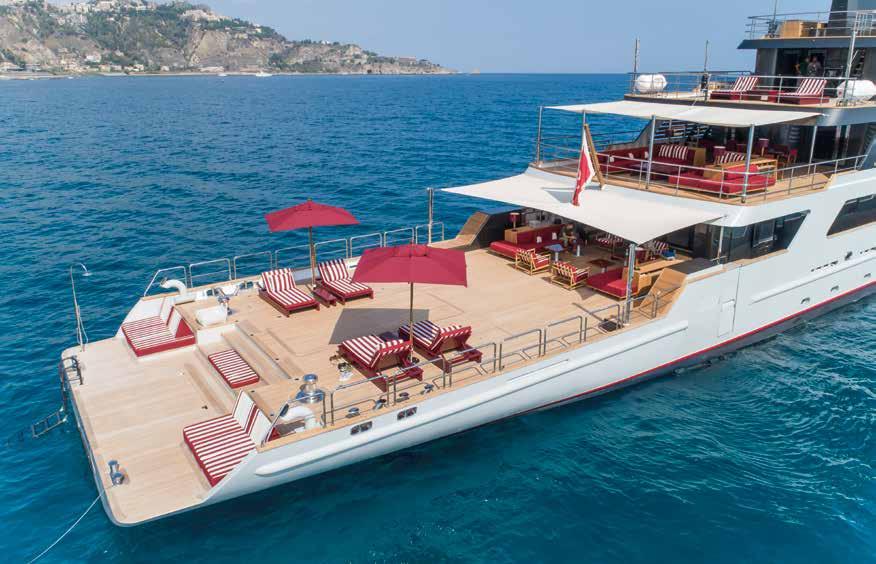
Clearly born from the same design language as its Frauscher chase boat family, the new 1212 Ghost at the same time revolutionises the concept in terms of versatility and performance
 by Bryony Mc Cabe - ph. courtesy by Frauscher
by Bryony Mc Cabe - ph. courtesy by Frauscher
While most ghosts choose to stay invisible, the new Frauscher 1212 Ghost enthuses with an evolution of the Frauscher design language that is both bold and beautiful


The consequence of years of development, the 39ft 1212 Ghost encompasses the very best features from the Frauscher range of chase boats while filling the gap between the brand’s best seller, the 1017 GT, and its flagship, the 1414 Demon. The Ghost, therefore, strikes a balance for both those who love to navigate inland waterways and those who enjoy discovering coastlines around the world. For the Ghost’s interior design and exterior lines, Frauscher once again worked with Stephan Everwin, an Austrian designer and renowned design partner for Porsche Design. It is no coincidence, then, that there are clear references to the automotive sector on board – a design philosophy that unites the most recent models in the range. The large side air intakes for example, already featured on board the 747 Mirage and 1414 Demon, are reminiscent of a sports car aesthetic and define the Ghost’s profile in a powerful and stealthy way.

The expansive teak decking, frameless windshield and vertical bow are among the other distinctive features of the Ghost, creating maximum space and comfort on board. The stern area opens into a protected cockpit and seating area, with lines that flow in a swooping design to frame sun loungers and a generous teak bathing platform aft.
Below deck, there is a large and versatile cabin; thanks to the electrically folding table, it is possible to transform the space from a dining area into an elegant double cabin with natural daylight flooding in from the window hatches overhead.
The interior also features a toilet and wet room with plentiful height.
The Ghost is comfortable as well as agile, with performance characteristics focused on stability, manoeuvrability, and acceleration. This is the result of Frauscher’s ongoing collaboration with designer Harry Miesbauer, who designed the hull and relative water lines. The Ghost also incorporates all the features essential on a modern chase boat, such as the retractable bimini, retractable anchor, bow thruster, and functional joystick.
With its versatile design and capabilities, the Ghost can conquer a variety of waters around the world with the same dexterity as its namesake.
www.frauscherboats.com
The 1212 Ghost features distinctive elements like the huge teak deck, frameless windscreen, and vertical bow design. The interior features a versatile space that can transform from social area to double cabin in an instant


It’s Bell’s flagship and as its name suggests, the Bell 525 Relentless is the top of the range for the Texan manufacturer. This hard-working aircraft is an innovative ‘copter that combines aesthetic appeal with elegant interiors featuring select materials
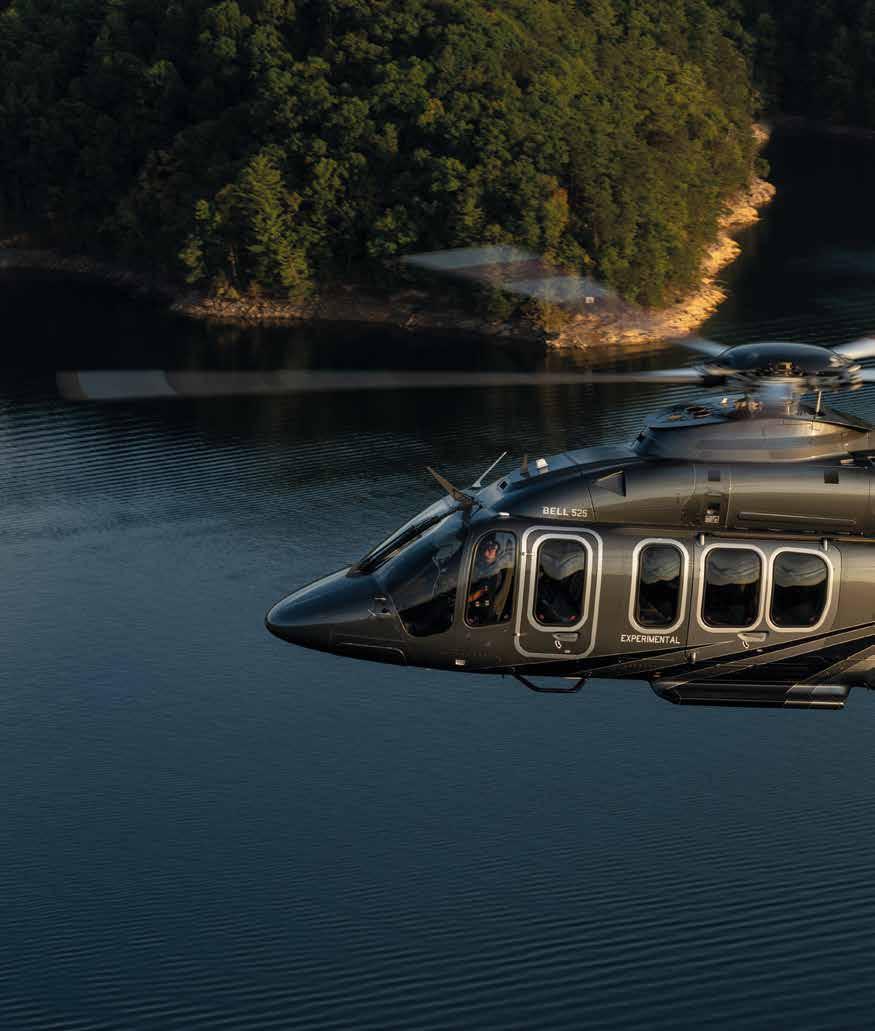 by Sergio Barlocchetti - ph. courtesy by Bell Helicopters
by Sergio Barlocchetti - ph. courtesy by Bell Helicopters
Agiant of helicopter production like Bell can never remain without a flagship, but the unforgiving laws of aviation dictate that when you design something innovative the route to success is three times more complicated. The Bell 525 Relentless, though seems set to be one of the few innovative helicopters to appeal to a wide market, and although it was developed to ferry personnel to and from oil rigs, it can look forward to enjoying a future in the VIP/corporate and emergency services sectors, becoming the top of the range for the Amarillo, Texas based constructor. As well digital controls the B525 boasts Integrated Vehicle Health Management (IVHM), which monitors the health of all the aircrafts systems, fluid levels included. The information is gathered by an impressive number of sensors distributed throughout the fuselage and mechanisms, generating thousands of parameters providing data operators can access. This helps cut maintenance and running costs for components that have to be checked every 5,000 flight hours, a very long period for this type of aircraft. If you spend 15 million dollars you naturally expect to be travelling in comfort, which for a helicopter means offering elegant, luxurious interiors made using recycled materials and in this case providing the passenger cabin with larger windows. Above
all, though, the LIVE system cuts out 95% of vibration generated by the main rotor. All in all, it’s a velvet-smooth ride where passengers can close their eyes and imagine they are flying on board a business jet. The cockpit has been designed with great care, cossetting pilots with ergonomic seats that make long journeys much more tolerable and providing the degree of visibility required for landing on open-sea oil platforms or private helipads. The B525 is one of the most versatile helicopters in its class, being suitable for corporate transport, emergency response or personnel transport with a cabin capable of carrying up to sixteen passengers. Among the pilots who have tried the aircraft out is James Maner, chief pilot for PHI Americas, one of the first operators to choose the helicopter. In his words, “The Bell 525 is a phenomenally unique flying experience. It’s incredibly smooth and intuitive, simple to operate, and blends complex advancements into an impressive pilot and passenger experience”. Bell states that the 525 consumes 30% less fuel than direct competitors like the Sikorsky S-92 and 27% less than the H225, even when using sustainable fuels. (SAF). www.bellflight.com




Riva Anniversario, a 33’ brimming with unique charisma and power. From design to performance, Officina Italiana Design’s sublime and spectacular open creates a sophisticated dialogue between past and present. And is set to become a real collectors’ item too!
 by Paola Bertelli
by Paola Bertelli
Just 18 lucky owners will take delivery of the Riva Anniversario, the boat designed last year especially to celebrate Riva’s 180th anniversary. The Riva Anniversario is the perfect encapsulation of the Limited Edition concept of rarity, exclusivity and uniqueness.

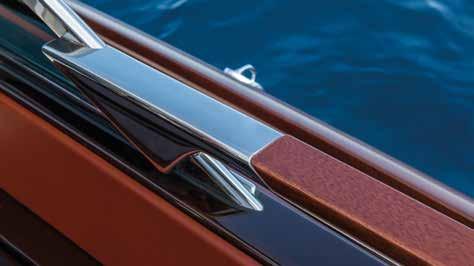

The creative process that produced this 33’ open began with another hugely successful model, the Aquariva, which in turn was the heir to the Aquarama, an evergreen style and design icon. The Riva Anniversario, Aquariva and Aquarama are inextricably linked and all brilliant expressions of the power of a deeply-rooted tradition that has still moved with the times by remaining open to contemporary stimuli.
The Riva Anniversario’s stylishness is a loud and proud declaration. “We love ultra-clean classic design that is all about taking away rather than adding. All with the aim of achieving the very essence of a unique and unmistakeable style,” explains Mauro Micheli who together with his business partner, Sergio Beretta, founded OID, the studio that has been penning Riva’s glorious models for the last three decades. OID’s passion for sleek, streamlined lines and extreme formal purity has produced functional elements, such as air intakes and stern platforms, being deftly hidden.
The deep rich mahogany livery is clear reference to Riva tradition too but has been given a contemporary allure thanks to a sophisticated and up-to-the minute metallic finish. Aboard the designers have reintroduced the now-legendary white and aquamarine colour combination, while steel is used to define details, profiles and finishing touches. In a constant dialogue between contemporary and traditional, the windscreen looks like it has been borrowed from the Aquariva but is actually absolutely up-tothe-minute – just like the waylights and the round portholes. The bridge’s vintage references are flanked by new generation digital instrumentation too. In fact, everything aboard has been meticulously designed to achieve the formidable mix of innovation, detailing and timeless styling that has made Riva such an iconic brand.
Last but very far from least, performance is what makes a beautiful boat great and beneath the classic aft sunpad nestles a clever engine compartment complete with twin 370 hp Yanmar engines that guarantee exhilarating adrenaline-fuelled spins with peaks of 40.5 knots as well as still zippy but more leisurely cruising at 36.
www.riva-yacht.com


Ladies and gentlemen, I give you the sign of the horns, reproduced for the occasion as an artistic flourish above and below the calibre RM66, mechanical hand-wound movement with a flying tourbillon in the centre of the latest dazzling creation by Richard Mille

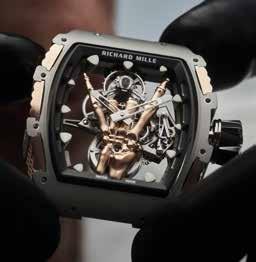


Above, clockwise: polishing the red gold bones; the calibre seen through the sapphire caseback; a detail of its frontal section; the caseband with design recalling punk belts; an assembly phase; the Goth-style spidershaped crown clasping a ruby. Opposite page, the RM 66 Flying Tourbillon
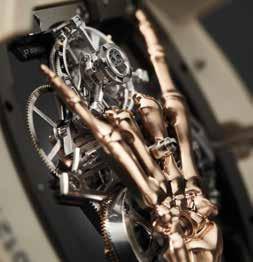

An unambiguous symbol combining culture and tradition, belief and superstition. Born in the depths of time, in the 1960s and 70s it became a universal brand on the social, cultural and music scene, an unofficial symbol of defiance, revolution and rebellion, but also a sign of belonging, especially in the world of rock. From the Beatles (John Lennon can be seen making it on the cover of Yellow Submarine) to Black Sabbath, a band that made it even more famous on the art scene through its front man Ronnie James Dio. Two outstretched digits, the index and little fingers, and two clenched, the middle and ring fingers, locked in place by the thumb. This challenge thrown out to the establishment has now become part of an equally anti-conformist watch – the RM 66 Flying Tourbillon. With mechanics developed in Richard Mille’s Swiss workshops, the aesthetics of brand’s latest creative folly were conceived by creative and development director Cécile Guenat, and it was produced by master watchmakers in collaboration with Olivier Vaucher, a Geneva-based engraver who created the red gold skeleton that is the watch’s aesthetic and functional star.

This unprecedented technical and architectural challenge demanded almost 1,500 hours of research and development. Not forgetting, of course, the time needed for its production, assembly, calibration and the creation and finishing of the precious gold alloy bones, the unholy element in an openworked mechanical hand-wound movement with grade 5 titanium plate and bridges, equipped with a flying tourbillon at 12 o’clock. This high-impact watch is produced in a limited run of only fifty examples.
www. richardmille.com





Sky Services represents the all in one solution for your general aviation flights to Italy. Our FBOs are located in: Milan-Linate, Milan-Malpensa, Milan-Bresso, Venice, Verona, Treviso, Rome-Ciampino, Naples, Saler no, Bari and Brindisi Own equipment, staff and facilities with elegant VIP lounges. Ground Support & Permits at all Italian airports / Fuel / SKY CUISINE inflight catering. Credit facilities a nd VAT exemption available. Full handling, long stay parking, hangars Aircraft Management - Maintenance PART 145 / AOC / CAMO. Flight Academy - ATO Milan / Capua / Brindisi. Courses from 0 to ATPL.

The universe of Van Cleef & Arpels from its foundation in 1906. An identity defined by three key words embodying the essence of the French High Jewelry House
 by Gianfilippo Versari ph. courtesy by Van Cleef & Arpels
by Gianfilippo Versari ph. courtesy by Van Cleef & Arpels
It all began in 1895, in the heart of Paris, with the marriage of Estelle Arpels, daughter of a gem dealer, and diamond cutter Alfred Van Cleef. The rest is history. The young couple shared the same values - enthusiasm and innovation, a sense of family and a passion for precious stones. These values inspired the creation of the first boutique, which opened its doors in 1906 at 22 Place Vendôme, Paris, near the Ritz Hotel, the exclusive residence of wealthy travelers. The brand quickly achieved remarkable success, opening branches in Nice, Deauville, Vichy, Cannes, and Monte Carlo. The couple’s daughter, Renée Puissant, became the company’s artistic director in 1926 and with exceptional daring and imagination she created the unique, immediately recognizable Van Cleef & Arpels style. The initial production of platinum and diamond jewelry embodying the garland style in vogue at the time evolved into the exoticism that swept the fashion world of the 1920s. The House’s creatives were fascinated by the jewelry discovered the tomb of Pharaoh Tutankhamun in 1922, inspiring them to enhance their repertoire with Egyptian motifs and colors. Among the most successful jewelry designs in this style were bracelets decorated with sphinxes, lotus flowers, scarabs, slaves at work, snakes, vultures, and hieroglyphs made with colored precious stone cabochons on a background of faceted diamonds.
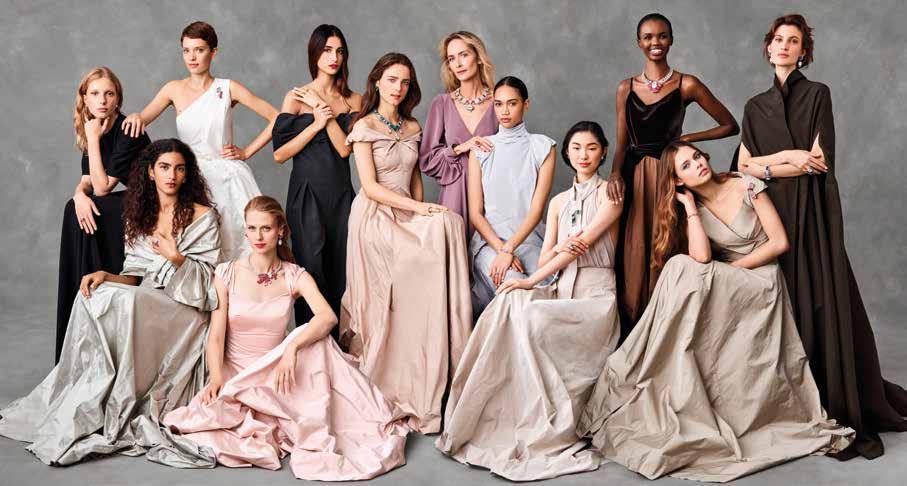
Love has always been an important source of inspiration for the House – in fact, the first item
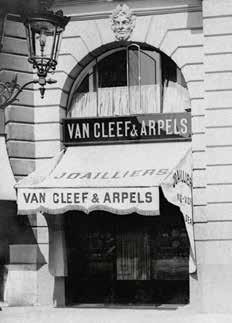
recorded in the sales ledger is a heart-shaped diamond. In the following years, many creations were made to celebrate the most famous love stories, from the Duke and Duchess of Windsor to Grace Kelly’s marriage to Prince Rainier of Monaco. The theme of love is still a constant in all the House’s collections, from engagement rings to wedding rings as well as watches and high-end jewelry pieces. Precious objects have always been expressions of love but they also reflect the zeitgeist. Over the years, Van Cleef & Arpels has played a major role in the jewelry world, developing an original style based on a subtle alchemy of creativity, innovation, and elegance. Nature, a classic source of inspiration for art and jewelry, has also provided the brand with an inexhaustible stylistic repertoire, and throughout its history, plants, flowers and animals have prompted an extraordinary profusion of colors, patterns, and materials, from precious gems to semi-precious stone and even organic materials. Van Cleef & Arpels became a key player after the opening of its New York headquarters, enjoying a period of great success in the 1950s, with the launch of the Tissu Serge collection and boutiques selling limited editions of jewelry at an accessible price to a wider, younger clientele. In the 1960s and 1970s, Van Cleef & Arpels focused on a floral motif with the Rose de Nöel coral brooches and earrings and Alhambra chains with gold and hard stone four-leaf clovers. The brand was also influenced by Eastern culture, which led to the creation of a series of multicolored necklaces inspired by the jewels worn by Maharajas.
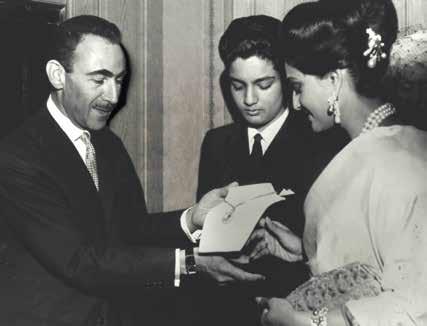

Today, Van Cleef & Arpels expresses its commitment to research and innovation through the introduction of unusual materials such as hematite and gray mother-of-pearl. Current production is based on the reinterpretation of timeless classics like Serti Mystérieux necklaces while also offering jewelry with rare gems and the harmonious shapes of original yet classic products. One example among many is 25 Mystery Set Jewels, part of the recently launched Legend of Diamonds collection, whose story began in 2018 when Van Cleef & Arpels discovered a rough diamond known as the Lesotho Legend. The fifth largest rough diamond ever mined in the world, the stone weighed 910 carats and was a perfect
Right-hand page, clockwise: Roaring Twenties transformable long necklace & Chrysler EarringsPhotography by Erik Madigan Heck, Volutes Mystérieuses transformable necklace and earrings accompanied by Echo Mystérieux earrings with detachable pendants and ring & Entrelacs Mystérieux bracelet, both part of the Legend of Diamonds - 25 Mystery Set Jewels collection.
Photography by Marc de Groot plus images taken during the creative process
D color. It was subsequently cut into 67 diamonds, which the Van Cleef & Arpels design studio used to create a collection of 25 pieces. The final collection celebrates the House’s historic techniques, as well as gemstone combinations such as sapphires and emeralds. Some pieces were designed to be transformable and wearable in up to six different ways. This spectacular collection is based on the power of one stone to create 25 unique pieces, each of which sparkles in its own way.
Along with the 25 Mystery Set Jewels, the White Diamond Variations collection, also part of the Legend of Diamonds collection, celebrates the House’s creative history and the timeless beauty of this precious stone. Inspired by the brand’s rich heritage, the pieces in the collection reinterpret Van Cleef & Arpel’s distinctive style, reflecting different eras and artistic trends.
www.vancleefarpels.com
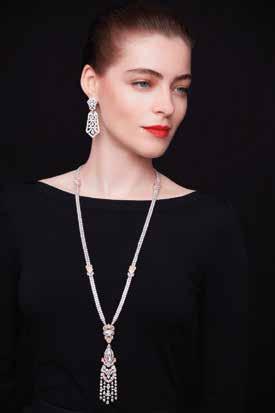



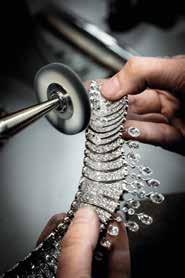
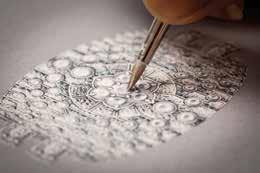

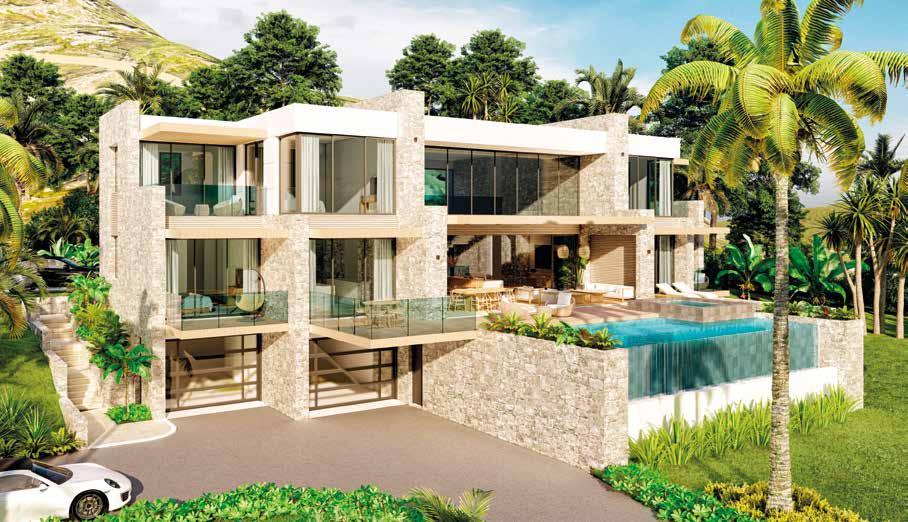

Nestled between the sun and the sea, lies Cockleshell Bay and the setting for the Solterre residences. Cooled by the gentle breeze of the tradewinds and lapped by the ocean, this is barefoot luxury living, Caribbean style
 by Roxanne Hughes
by Roxanne Hughes
This secluded bay on the south-eastern tip of St Kitts is about to become the island’s most sought after address. The crescentshaped enclave enjoys a beachfront position with views across the turquoise waters towards St Kitts’ sister island, Nevis.
The exquisite Solterre residences were envisioned by Capital Realty & Development (CR&D), experienced master-planners who have created residential and resort developments across the US and the Caribbean. CR&D turned to RAD Architecture for the development’s alluringly distinct design, with a strict instruction that the venture support the island’s businesses, respect the environment, and show responsible consideration for sustainability.
Comprising 36 two-to-three bedroom three-storey homes, as well as nine estate properties that each occupy a half-acre plot, Solterre will establish its own small community in this corner of the Caribbean. Built from volcanic stone and set amongst lush, tropical gardens, the smaller homes are equipped with their own private plunge pools and offer desirable terraces for an indoor/outdoor dynamic.
The estates offer open plan living with multiple balconies, larger pools and

extended grounds with features such as sunken fire pits and additional staff accommodation.
All the properties are available fully furnished and are styled in a contemporary Caribbean fashion.
Alongside the private residences, there are plans for a resort and club house, complete with state-of-the-art fitness centre, infinity pool and beachside concierge, as well as a bar and restaurant with a rooftop space for events. Residents of Solterre will benefit from full access to the resort’s amenities and services.
The neighbouring islands of St. Kitts & Nevis are joined by The Narrows, a two-mile channel that’s easily traversed by water taxi. Solterre is just a 15-minute drive to the airport and a five-minute drive to Christophe Harbour, the Caribbean’s newest deep-water marina.
St Kitts boasts a favourable tax environment with a citizenship investment programme, and enormous opportunity for those seeking a barefoot luxury bolthole in the Caribbean.
The Solterre residences are listed for sale with Sotheby’s International Realty, with prices from $2,450,000. www.sothebysrealty.com

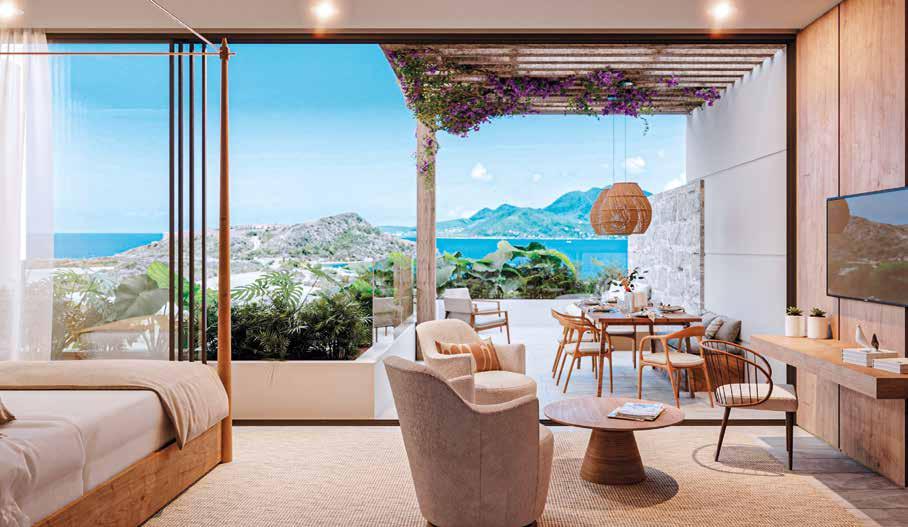 The homes feature jaw-dropping 10-foot-high ceilings and enormous impact-resistant floor-to-ceiling glass panels The interiors have been designed by Rafael Amuchastegui. Finishes include engineered oak flooring and quartz countertops, and textured woods run throughout
The homes feature jaw-dropping 10-foot-high ceilings and enormous impact-resistant floor-to-ceiling glass panels The interiors have been designed by Rafael Amuchastegui. Finishes include engineered oak flooring and quartz countertops, and textured woods run throughout
theoneyd.com platinummedialab.com
EDITOR IN CHIEF
Barbara Del Duca
PUBLISHER
Deborah Bazzoni deborahbazzoni@platinummedialab.com
MANAGING DIRECTOR
Désirée Sormani desireesormani@platinummedialab.com
ART DIRECTOR
Laura Larese de Santo lauralarese@platinummedialab.com
EDITORIAL STAFF
Beatrice Galbiati (Jewellery Editor) beatricegalbiati@platinummedialab.com
CONTRIBUTORS
Sergio A. Barlocchetti (Aviation), Marta Bernasconi (Furniture & Design), Paola Bertelli, Mary Hegarty, Roxanne Huges (Properties), Valentina Lempi, Bryony McCabe, Diego Tamone (Cars and Watches), Gianfilippo Versari (Luxury Goods), Micaela Zucconi (Art)
TRANSLATIONS
Mary Hegarty, Chris Thompson
DISTRIBUTION FOR ITALY AND ABROAD
SO.DI.P. “Angelo Patuzzi” S.p.a. Via Bettola, 18 - 20092 Cinisello Balsamo (MI), Italy ph. +39/02-660301- fax +39/02-66030320
e-mail sies@sodip.it
ADVERTISING
Deborah Bazzoni (Sales Director)
ph. + 39/02-36683420, mobile + 39/335 6282058 deborahbazzoni@platinummedialab.com
Ilaria Valerio (Furniture & Luxury Goods) mobile +39 335 8027816 ilariavalerio@platinummedialab.com
PRINTING
GECA SRL
Via Monferrato, 54 - 20098 San Giuliano Milanese
SUBSCRIPTION SERVICE
ph.: + 39/02-36683420 (Italy’s office hours)


www.theoneyd.com/magazine-subscription
BACK ISSUES
Double the cover price + delivery costs
NEWSSTAND DISTRIBUTION
The ONEYacht&Design is distributed in the major newsstands and airports in the following countries: EUROPE: Italy, Austria, Belgium, Czech Republic, France, Germany, Great Britain, Greece, Luxembourg, Netherlands, Poland, Portuga, Principality of Monaco, Slovenia, Spain, Sweden, Switzerland. AMERICA: Brazil, Canada, United States.
OCEANIA: Australia, New Zeland. MIDDLE EAST: U.A.E. United Arab Emirates, Qatar, Oman,Turkey. ASIA: Japan, Hong Kong, India, Maldives, Seychelles, Singapore, Thailand, Taiwan
ALTERNATIVE DISTRIBUTION
The updated list of our distribution among Platinum Media Lab’s premium partners can be found on our web site platinummedialab.com
All rights reserved for Italy and abroad The One, Registered at the Milan law court n° 22 - 30/01/2015
PUBLISHER
Via San Calimero, 1 20122 Milan Italy ph. +39/02-36683420 a.r. - fax + 39/02-36683421 info@platinummedialab.com
CEO
Matteo Galbiati matteogalbiati@platinummedialab.com
EDITORIAL DIRECTOR
Barbara Del Duca
Platinum Media Lab publishes the following international magazines
Watches onder






